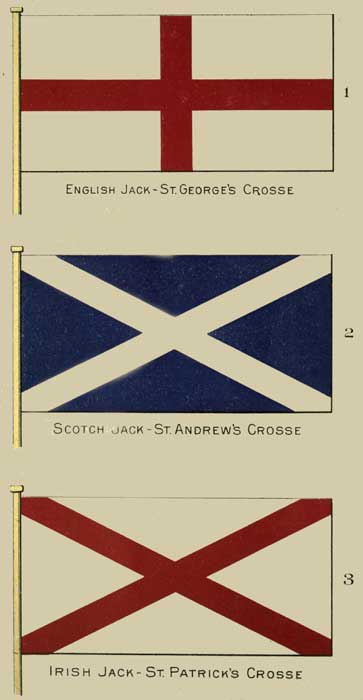
| 1 English Jack—St. George's Crosse |
| 2 Scotch Jack—St. Andrew's Crosse |
| 3 Irish Jack—St. Patrick's Crosse |
Their Origin, Proportions and Meanings as tracing the Constitutional Development of the British Realm, and with References to other National Ensigns
BY BARLOW CUMBERLAND, M.A.
Past President of the National Club, and of the Sons of England, Toronto; President of the Ontario Historical Society, Canada
With Illustrations and Nine Coloured Plates
THIRD EDITION, REVISED AND EXTENDED, WITH INDEX
TORONTO WILLIAM BRIGGS Booksellers' Row, Richmond Street West 1909 Copyright, Canada, 1909, by BARLOW CUMBERLAND.
TO THE FLAG ITSELF THIS STORY OF THE
Union Jack
IS DEDICATED WITH MUCH RESPECT BY ONE OF ITS SONS.
PLATE I.

| 1 English Jack—St. George's Crosse |
| 2 Scotch Jack—St. Andrew's Crosse |
| 3 Irish Jack—St. Patrick's Crosse |
This history of the Union Jack grew out of a paper principally intended to inform my boys of how the Union Jack of our Empire grew into its present form, and how the colours and groupings of its parts are connected with our government and history, so that through this knowledge the flag itself might speak to them in a way it had not done before.
A search for further information, extended over many varied fields, gathered together facts that had previously been separated, and grouped them into consecutive order; thus the story grew, and having developed into a lecture, was afterwards, at the suggestion of others, launched upon its public way.
The chapters on the history of the Jacks in the Thirteen American Colonies and in the United States are also new ground and may be of novel interest to not a few. The added information on the proper proportions of our Union Jack, and the directions and reasons for the proper making of its parts, may serve to correct some of the unhappy errors which now exist and may interest all in the observation and study of flags.
An Index has been added, and a record of the "Diamond Anthem" is also appended.
I would acknowledge the criticisms and kindly assistance of many, particularly of Mr. James Bain, Public Librarian of Toronto, who opened out to me the valuable collection in his library; of Mr. J. G. Colmer, C.M.G., Secretary to the Canadian High Commissioner, London, who assisted in obtaining material in England; and of Mr. W. Laird Clowes, Sir James Le Moine, Sir J. G. Bourinot and Dr. J. G. Hodgins, Historiographer of Ontario, who have made many valuable and effective suggestions.
Toronto, October 1, 1900.
The celebration of EMPIRE DAY and of other National and Historic Anniversaries, accompanied by appropriate addresses, has greatly developed at home and abroad. The instructing value of Flags as the visible evidences of the progressive periods of National history, and the concentration of patriotic remembrance, having become more appreciated, have led, no doubt, to the request for a re-issue of this book, which had been for some time out of print.
For such purposes, and as an assistance to Readers and Teachers, the material has been practically recast and new matter incorporated, so that with the collations in the Index the phases of the various portions of the Flags, both of the British and other nationalities, may be more conveniently traced and connected.
Much additional information, particularly in the designing and creation of the Flags, has been sought out and, with additional illustrations, recorded with a view that the intentions expressed in their forms may be more clearly evidenced, their meanings realized, and their connection with Constitutional movements developed.
The suggestions and assistance of many correspondents, to this end, has been much availed of and is thankfully acknowledged.
During the interval since the last issue the Liberties and Methods of the British Constitution have still further expanded. Additional Daughter-Parliaments in the Dominions over-seas have been empowered, and their Union Flags created. To these, as also added information on other Ensigns, is due the addition to the Title.
The references in stating the progress of our National Flag are, of necessity, much condensed, but the writer trusts that with the instructing aid and narrations of its exponents, the information here put together may be found of help in causing the study of Flags, and the stories which they voice, to be of increasing interest, and their Union Jack and Ensigns more intimately known to our youth as the living emblems of our British History and Union.
Port Hope, September, 1909.
| Chapter | Page | |
| A Poem—The Union Jack | 11 | |
| Notes on Flags | 12 | |
| I. | Emblems and Flags | 13 |
| II. | The Origins of National Flags | 21 |
| III. | The Origin of the Jacks | 32 |
| IV. | The English Jack | 41 |
| V. | The Supremacy of the English Jack | 53 |
| VI. | The Scottish Jack | 64 |
| VII. | The "Additional" Union Jack of James I. | 71 |
| VIII. | The English Jack Restored | 81 |
| IX. | The Evolution of the Red Ensign | 92 |
| X. | The Sovereignty of the Seas—The Fight for the Flag | 102 |
| XI. | The Sovereignty of the Seas—The Fight for the Trade | 111 |
| XII. | The Union Jack of Queen Anne, 1707 | 118 |
| XIII. | The Two-Crossed Jack in Canada | 132 |
| XIV. | The Irish Jack | 140 |
| XV. | The Jacks in the Thirteen Colonies of North America | 153 |
| XVI. | The Union Flags of the United States | 170 |
| XVII. | The Jack and Parliamentary Union in Britain | 182 |
| XVIII. | The Jack and Parliamentary Union in Canada | 189 |
| XIX. | The Union Jack of George III., 1801 | 199 |
| XX. | The Lessons of the Crosses | 215 |
| XXI. | The Proportions of the Crosses | 222 |
| XXII. | Under the Three Crosses in Canada | 235 |
| XXIII. | The Flag of Freedom | 243 |
| XXIV. | The Flag of Liberty | 253 |
| XXV. | The Union Jack as a Single Flag | 264 |
| XXVI. | The Jacks in Red, White and Blue Ensigns | 272 |
| XXVII. | The Union Ensigns of the British Empire | 280 |
| Appendix A. | The Maple Leaf Emblem | 295 |
| Appendix B. | Letters from the Private Secretary of His Majesty King Edward VII. | 298 |
| Appendix C. | Canadian War Medals | 299 |
| Appendix D. | A Record of the "Diamond Anthem" | 300 |
| Index | 313 |
| No. | Page | |
| 1. | Assyrian Emblems | 15 |
| 2. | Eagle Emblems | 16 |
| 3. | Tortoise Totem | 18 |
| 4. | Wolf Totem | 18 |
| 5. | The Hawaiian Ensig | 30 |
| 6. | A Red Cross Knight | 35 |
| 7. | Colours of 10th Royal Grenadiers, Canada | 39 |
| 8. | St. George's Jack | 41 |
| 9. | The Borough Seal of Lyme Regis, 1284 | 46 |
| 10. | Brass in Elsing Church, 1347 | 49 |
| 11. | The Henri Grace à Dieu, 1515 | 60 |
| 12. | St. Andrew's Jack | 64 |
| 13. | Scotch "Talle Shippe," 16th Century | 67 |
| 14. | Royal Arms of England, Henry V., 1413, to Elizabeth | 71 |
| 15. | Royal Arms of James I., 1603 | 72 |
| 16. | Jack of James I., 1606 | 74 |
| 17. | The Sovereign of the Seas, 1637 | 85 |
| 18. | Commonwealth Twenty-Shilling Piece | 87 |
| 19. | Commonwealth Boat Flag | 88 |
| 20. | The Naseby. Charles II. | 95 |
| 21. | Medal of Charles II., 1665 | 98 |
| 22. | Whip-lash Pennant, British Navy | 108 |
| 23. | Union Jack of Anne, 1707 | 118 |
| 24. | Draft "C," Union Jack, 1707 | 121 |
| 25. | The Red Ensign in "The Margent," 1707 | 125 |
| 26. | Fort Niagara, 1759 | 128 |
| 27. | The Assault at Wolfe's Cove, Quebec, 1759 | 130 |
| 28. | St. Patrick's Jack | 141 |
| 29. | Labarum of Constantine | 142 |
| 30. | Harp of Hibernia | 143 |
| 31. | Seal of Carrickfergus, 1605 | 148 |
| 32. | Royal Arms of Queen Victoria[Pg 8] | 148 |
| 33. | Medal of Queen's First Visit to Ireland | 149 |
| 34. | The Throne of Queen Victoria in the House of Lords, 1900 | 150 |
| 35. | Arms of the Fitzgeralds | 151 |
| 36. | Medal of Louis XIV., "Kebeca Liberata," 1690 | 165 |
| 37. | New England Ensign | 166 |
| 38. | The Louisbourg Medal, 1758 | 168 |
| 39. | The First Union Flag, 1776 | 174 |
| 40. | The Pennsylvania Flag, 1776 | 176 |
| 41. | Arms of the Washington Family | 177 |
| 42. | Washington's Book-Plate | 178 |
| 43. | Washington's Seals | 179 |
| 44. | Fort George and the Port of New York in 1770 | 187 |
| 45. | Royal Arms of George II. | 190 |
| 46. | The Great Seal of Upper Canada, 1792 | 195 |
| 47. | Upper Canada Penny | 198 |
| 48. | Draft "C" of Union Jack, 1800 | 200 |
| 49. | Royal Arms of George III., 1801 | 202 |
| 50. | Union Jack of George III., 1801 | 203 |
| 51. | Outline Jack—The Proper Proportions of the Crosses | 209 |
| 52. | The Union Jack and Shackleton at Farthest South | 213 |
| 53. | Square Union Jack | 219 |
| 54. | Oblong Union Jack | 220 |
| 55. | Flag of a French Caravel, 16th Century | 223 |
| 56. | The Colonial Jack, 1701 | 226 |
| 57. | Jack of England, 1711 | 227 |
| 58. | Jack in Carolina, 1739 | 228 |
| 59. | The Combat between La Surveillante and the Quebec, 1779 | 229 |
| 60. | Ensign of 7th Royal Fusiliers, 1775 | 230 |
| 61. | "King's Colour," 1781 | 231 |
| 62. | The War Medal, 1793-1814 | 236 |
| 63. | The Service Medal, Canada, 1866-1870 | 237 |
| 64. | The North-West Canada Medal, 1885 | 240 |
| 65. | Flag of the Governor-General of Canada | 259 |
| 66. | Flag of the Lieutenant-Governor of Quebec | 260 |
| 67. | Australian Emblems | 283 |
| 68. | Australian Federation Badge | 287 |
| 69. | Suggested Canadian Union Ensign | 297 |
| Page | ||
| Plate I. | Frontispiece | |
| 1. English Jack—St. George's Crosse. | ||
| 2. Scottish Jack—St. Andrew's Crosse. | ||
| 3. Irish Jack—St. Patrick's Crosse. | ||
| Plate II. | 22 | |
| 1. Germany. | ||
| 2. Italy. | ||
| 3. Greece. | ||
| 4. Hawaii. | ||
| Plate III. | 76 | |
| 1. The Percys' Ensign, 1560. | ||
| 2. Union Jack of James I., 1606. | ||
| 3. Colonial Union Jack, 1701. | ||
| Plate IV. | 92 | |
| 1. Commonwealth Ensign, 1648. | ||
| 2. Cromwell's "Great Union," 1658. | ||
| 3. Ensign Red—Charles II., 1660. | ||
| Plate V. | 118 | |
| 1. Union Jack of Anne, 1707. | ||
| 2. Red Ensign of Anne, 1707. | ||
| 3. Union Jack of George III., 1801. | ||
| Plate VI. | 174 | |
| 1. Grand Union, 1776. | ||
| 2. United States, 1777. | ||
| 3. United States, 1909. | ||
| Plate VII. | 218 | |
| 1. Present Union Jack upside down. | ||
| 2. Jack wrongly made. | ||
| 2. Jack wrongly made. | ||
| Plate VIII. | 272 | |
| 1. Red Ensign. | ||
| 2. White Ensign. | ||
| 3. Blue Ensign. | ||
| Plate IX. | 280 | |
| 1. Canadian Union Ensign. | ||
| 2. Australian Union Ensign. | ||
| 3. New Zealand Union Ensign. |
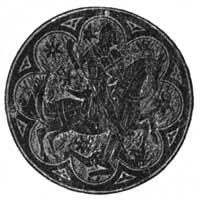
NAMES OF PARTS.
Particular names are given to the several parts of a flag.
The part next the flagstaff, or width, Is called the "hoist."
The outer part, or length, is termed the "fly," and also the "field."
These parts are further divided into "quarters," or "cantons": two "next the staff," two "in the fly."
These descriptive terms should be noted, as they will be in constant use in the pages which follow.
USAGE.
A flag at half-mast is a sign of mourning.
A flag reversed is a signal of distress.
The lowering of a flag is a signal of surrender.
The raising of the victors' flag in its place is a signal of capture.
The nationality of a country is shown by its flag.
The nationality of a vessel is made known by the flag she flies at the stern.
To hoist the flag of one nation under that of another nation, on the same flag-staff, is to show it disrespect.
EMBLEMS AND FLAGS.
There is an instinct in the human race which delights in the flying of flags—a sentiment which appears to be inborn, causing men to become enthusiastic about a significant emblem raised in the air, whether as the insignia of descent, or as a symbol of race, or of nationality; something which, being held aloft before the sight of other men, declares, at a glance, the side to which the bearer belongs, and serves as a rallying point for those who think with him.
The child chortles at a piece of riband waved before him; a boy marches with head erect and martial stride as bearer of the banner at the head of his mimic battalion; the man, at duty's call, rallies to his national standard, and leaving home and all, stakes his life for it in his country's cause; and when the battle of life is closing and steps are homeward bound, the gray-beard, lifting his heart-filled eyes, blesses[Pg 14] the day that brings him back within sight of his native flag.
At all ages and in all times has it been the same. The deeper we go into the records of the past the more evidence do we find that man, however varied his race or primitive his condition, however cultured his surroundings or rude his methods, has universally displayed this innate characteristic instinct of delighting and glorifying in some personal or national emblem.
To search for and discover the emblems which they bore thus discloses to us the eras of a people's history, and, therefore, it is that the study of a nation's flag is something more than a mere passing interest, and becomes one of real educational value, meriting our closest investigation, for the study of Flags is really the tracing of History by sight.
In ancient Africa, explorations among the sculptured antiquities on the Nile have brought to light a series of national and religious emblem-standards, which had meaning and use among the Egyptians long before history had a written record. The fans and hieroglyphic standards of the Pharaohs are the index to their dynasties.
The Israelites, at the time of the Exodus, had their distinctive emblems, and in the Book of Numbers (ch. ii. 2), it is related how Moses directed that in their journeyings, "Every man of the children of Israel shall pitch by his own standard, with the ensign of their father's house."
So it came that to every Jewish child, in all the subsequent centuries, the emblem on the standard of his tribe recalled the history and the trials of his[Pg 15] ancestors and fortified his faith in the God of their Deliverance.
From the lost cities of Nineveh have been unearthed the ensign of the great Assyrian race, the "Twin Bull" (1), sign of their imperial might, and the records of their warriors are thus identified.
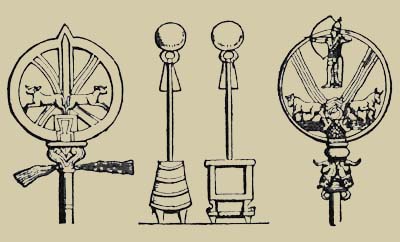
In Europe in later times there were few parts of the continent which did not become acquainted with the metal ensigns of the great Roman Empire. The formidable Legions of their armies, issuing from the centre of the realm, carried the Imperial Eagle at their head, and setting it in triumph over many a subjugated state, established its supremacy among the peoples as a sign of the all-conquering power of their mighty Empire. To this eagle of the Roman legions may be traced back the crop of eagle emblems (2), which are borne by so many of the nationalities of Europe at the present day. The golden eagle of the French battalions, the black eagle of Prussia, the white eagle of Poland, and the double-headed[Pg 16] eagles of Austria and Russia, whose two heads typify claim to sovereignty over both the ancient Eastern and Western sections of the Roman Empire, are all descendants from the Imperial Eagle of ancient Rome.
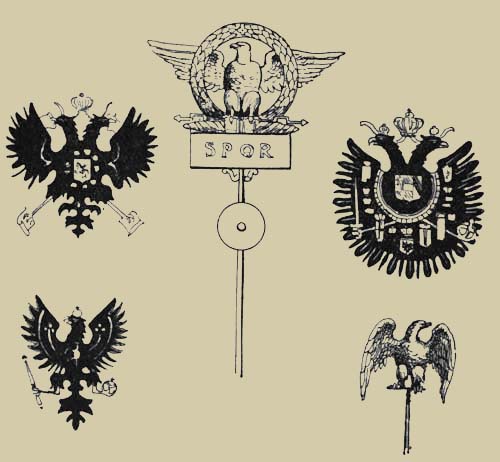
| Austrian. | Roman. | Russian. |
| Prussian. | French. |
As these nationalities of modern Europe have successively arisen and developed into their separate existence, the emblem of their ancient subjugation has been raised by them as the emblem of their power, just as the Cross, which was once the emblem[Pg 17] of the degradation and death of the Christ, has been accepted as the signal and glory of the nations which have come under the Christian sway.
As on the Eastern, so also on the Western hemisphere. On all continents the rainbow in the heavens is a perpetual memorial of the covenant made between God and man—the sign that behind the wonders of nature dwells the still more wonderful First Cause and Author of them all. The Peruvians, far back in the centuries of existence on the continent of South America, had preserved a tradition of a great event which, although it had taken place on another hemisphere, yet had been, by some means, transmitted to theirs, and, tracing from it the story of their national origin, they carried this emblem as sign of the lineage which they claimed as being, as they called themselves, "The Children of the Skies." Thus it was that under the standard of a "Rainbow" the armies of the Incas of Peru valiantly resisted the invasions of Pizzaro when, in the sixteenth century, the South American Continent came under the domination of Spain.
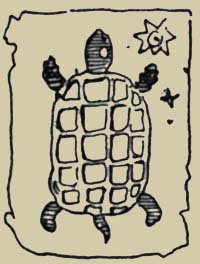
National emblems were borne farther north on the Northern continent by another nation, even yet more ancient than the Peruvians. Embedded in the ruins of buried cities of the Aztecs, in Mexico, are found the memorials of a constructive and artistic people, whose emblem of the "Eagle with outstretched wings," repeated with patriotic iteration in the stone carvings of their buildings, has thus come down to us the mute declarant of their national aspirations. The nation itself as a power has long since passed[Pg 18] away, but the outlines of their emblem still preserve the ideals of the vanished race.
A living instance of much interest also evidences the adherence to national emblems among the earlier inhabitants of North America. Long before the invading Europeans first landed on the shores of the North Atlantic coasts, the nomad Red Indian, as he travelled from place to place through the fastnesses of the forests, along the shores of the great lakes, over the plains of vast central prairies, or amid the mountains that crown the Pacific slope, everywhere attested the story of his descent by the "Totem" of his family. This sign of the Tortoise (3), the Wolf (4), the Bear, or the Fish, painted or embroidered on his trappings or carved upon his weapons, was displayed as evidence of his origin, and whether he came as a friend or advanced as a foe, its presence nerved him to maintain the reputation of his family and the honour of his tribe.
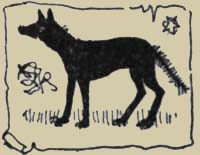
To-day the Red Man slowly yields to the ever-advancing march of the dominant and civilizing white; his means of sustenance by the chase, or of livelihood by his skill as a trapper, have been destroyed. The Indian tribes are, under the Indian treaties, required to remain within large blocks of territory called "Reserves," so that now in his poverty he is maintained upon these "reservations" solely by the dole of the[Pg 19] peoples by whom his native country has been absorbed; yet, though so changed in their circumstances, his descendants still cling with resolute fortitude and pathetic eagerness to these ancient insignia of their native worth. These rudely-formed emblems, in outline and shape mainly taken from the animals and birds of the plain and forest, are the memorials in his decadence of the long past days when his forefathers were the undisputed monarchs of all the wilds and possessors of its widest domains. They are the Indian patents of nobility, and thus are clung to with all the pride of ancient race.
This Instinct in man to attach a national meaning to some vital emblem, and to display it as evidence of his patriotic fervour, is thus found to be all-pervading. The accuracy of its form may not be exact—it may, indeed, be well-nigh indistinguishable in its outlines—but whenever it be raised aloft, the halo of patriotic meaning, with which memory has illumined it, is answered by the flutterings of the bearer's heart; self is lost in inspiring recollection; clanship, absorbing the individual, enfolds him as one of a mighty whole, and the race-blood that is deep within him springs quick into action, obedient to the stirring call.
The fervour of this manifestation was eloquently expressed by Lord Dufferin in narrating some incidents which had occurred during one of his official tours through Canada, when Governor-General of the country, the greatest daughter-nation among the children of the Union Jack:
"Wherever I have gone, in crowded cities, in the remote hamlets, the affection of the people for their[Pg 20] Sovereign has been blazoned forth against the summer sky by every device which art could fashion or ingenuity invent. Even in the wilds and deserts of the land, the most secluded and untutored settler would hoist some cloth or rag above his shanty, and startle the solitude of the forest with a shot from his rusty firelock and a lusty cheer from himself and his children in glad allegiance to his country's Queen. Even the Indian in his forest and on his reserve would marshal forth his picturesque symbols of fidelity in grateful recognition of a Government that never broke a treaty or falsified its plighted word to the Red Man, or failed to evince for the ancient children of the soil a wise and conscientious solicitude."[1]
Of all emblems, a Flag is the one which is universally accepted among men as the incarnation of their intensest sentiment, and when uplifted above them, concentrates in itself the annals of a nation and all the traditions of an empire.
A country's flag becomes, therefore, of additional value to its people in proportion as its symbolism is better understood and its story is more fully known. Its combinations should be studied, its story unfolded—for in itself a flag is nothing, but in its meaning it is everything.
So long, then, as pride of race and nation exists among men, so long will a waving flag command all that is strongest within them, and stir their national instincts to their utmost heights.
THE ORIGINS OF NATIONAL FLAGS.
With such natural emotions stirring within the breasts of its people, one can appreciate the fervid interest taken by each nation in its own national flag, and understand how it comes that the associations which cluster about its folds are so ardently treasured up.
Flags would at first sight appear to be but gaudy things, displaying contrasts of colour or variations of shape or design, according to the mood or the fancy of some enterprising flagmaker. This, no doubt, is the case with many signalling or mercantile flags. On the other hand, there is, in not a few of the flags known as "national flags," some particular combination of form or of colourings which, if they were but known, indicates the reason for their origin, or which marks some historic memory. There has been, perhaps, some notable occasion on which they were first displayed, or they may have been formed by the joining together of separate designs united at some eventful epoch, to signalize a victorious cause, or to perpetuate the memory of a great event. These great stories of the past are thus brought to mind and told anew by the coloured folds each time they are spread open by the breeze; for of most national flags it can be said, as was said by an American orator[3] of his[Pg 22] own, "It is a piece of bunting lifted in the air, but it speaks sublimity, and every part has a voice." It is to see these colours and hear these voices in the British national flags that is our present undertaking.
Before tracing the history of our British Union Jack, some instances may be briefly mentioned in which associations connected with the history of some other nations are displayed in the designs of their national flags.
The colours of the German national banner are black, white and red (Pl. II., fig. 1). Since 1870, when, at the conclusion of the French war, the united German Empire was formed, this has been the general Standard for all the states and principalities that were then brought into imperial union; although each of these lesser states continues to have, in addition, its own particular flag. This banner of United Germany introduced once more the old German colours, which had been displayed from 1184 until the time when, in 1806, the empire was broken up by Napoleon I. Tradition is extant that these colours had their origin as a national emblem at the time of the crowning of Frederic I. (Barbarossa) in 1152, as ruler of the countries which are now largely included in Germany. On this occasion the pathway to the cathedral at Aix-la-Chapelle was laid with a carpeting of black, gold and red, and the story goes that after the ceremony this carpet was cut by the people into strips which they then displayed as flags. Thus by the repetition of these historic colours in their ensign the present union of the German Empire is connected with the early history of more than seven centuries before.
PLATE II.
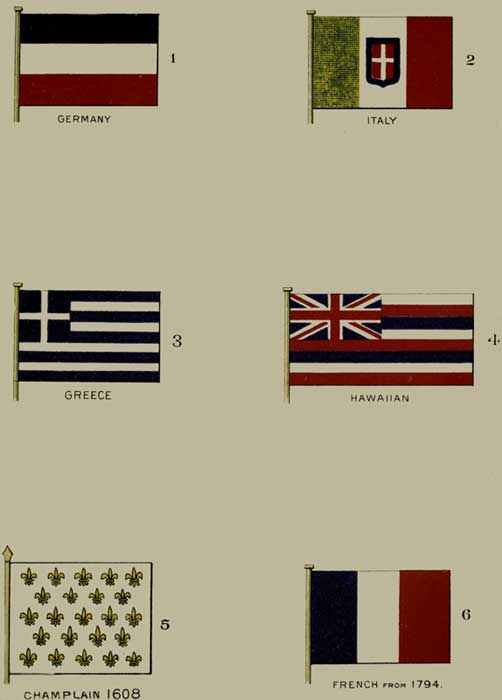
| 1 GERMANY | 2 ITALY |
| 3 GREECE | 4 HAWAIIAN |
| 5 CHAMPLAIN 1608 | 6 FRENCH from 1794 |
The national ensign of United Italy (Pl. II. , fig. 2) is a flag having three parallel vertical stripes, green, white and red, the green being next the flagstaff. Upon the central white stripe there is shown a red shield, having upon it a white cross. This national flag was adopted in 1870, after the Italian peoples had risen against their separate rulers, and the previously separated principalities and kingdoms had, under the leadership of Garibaldi, been consolidated into one united kingdom under Victor Emmanuel, the then reigning king of Sardinia. The red shield here displayed on the centre of the Italian flag designates the arms of the House of Savoy, to which the Royal House of Sardinia belonged, and which had been gained by the following ancient and honourable event:
The island of Rhodes, an Italian colony in the Eastern Mediterranean, had, in 1311, been in deadly peril from the attacks of the Turks. In their extremity the then Duke of Savoy came to the aid of the Knights Hospitallers of St. John, who were defending the island, and with his help they were able to make a successful resistance. In record and acknowledgment of this great service the Knights of St. John granted to the House of Savoy the privilege of wearing upon their royal arms the white cross on a red shield, which was the badge of their order of St. John.
So it happened when, nearly six centuries afterwards, the Sardinians again came to the aid of their southern brethren, and the King of Sardinia was crowned as ruler over the new united Italian kingdom,[Pg 24] the old emblem won in defence of ancient liberties was further perpetuated on the banner of the new kingdom of liberated and united Italy.
The colours of the Greek flag preserve the memory of a dynasty. In 1828, the Greeks, after rising in successful rebellion, had freed their land from Mohammedan domination and the power of the Sultan of Turkey. The several States formed themselves into one united kingdom, and seeking a king from among the royal houses of Europe, obtained, in 1832, Otho I., a scion of the ruling house of Bavaria. The dynasty at that time set upon the throne of Greece has since been changed, the Bavarian having parted company with the kingdom in 1861. The throne was then offered to Prince Alfred of England, but declined by him. The present king, chosen in 1863, after the withdrawal of his predecessor, is a member of the Royal House of Denmark; yet, notwithstanding this change in the reigning family, the white Greek Cross upon a light blue ground in the upper quarter, and the four alternate stripes of white on a light blue ground in the field, which form the national flag of Greece (Pl. II. , fig. 3), still preserve the blue and white colours of Bavaria, from whence the Greeks had obtained their first king.
The Tri-colour as displayed by the present Republic in France (Pl. II. II., fig. 6) has been credited with widely differing explanations of its origin, as its plain colours of blue, white and red admit of many different interpretations.
One story of its origin is, that its colours represent those of the three flags which had been carried in suc[Pg 25]cession in the early centuries of the nation. The early kings of France carried the plain blue banner of St. Martin. To this succeeded, in A.D. 1124, the flaming red flag, or Oriflamme, of St. Denis, to be afterwards superseded, in the fifteenth century, by the white "Cornette Blanche," the personal banner of the heroic Joan of Arc.
It was under this royal white flag (Pl. II., fig. 5), bearing upon it the lilies of ancient France, that Cartier, in 1534, had sailed up the St. Lawrence, and Champlain, in 1608, had founded Quebec. Under this flag Canada was colonized; to it belonged the glories of the Jesuit Fathers and Dollard; with it La Salle and Marquette explored the far West, planting three fleur-de-lis as the sign of their discoveries. Under it Frontenac, Montcalm and Levis[4] achieved their renown, and all the annals of early Canada are contained under its régime until, in 1759, after the assault by Wolfe, it was exchanged, at the cession of Quebec, for the British Union Flag.
The tri-colour of Republican France was never carried by the forefathers of the French Canadians of the Province of Quebec, nor has it any connection with the French history of Canada. In fact, it did not make its appearance as an emblem until the time of the revolution in France in 1789, or thirty years after the original French régime in Canada had closed its eventful period.
More detailed evidence of the origin of this flag states that the creation of the tri-colour arose from the incident that, when the revolutionary militia were first assembled in the city of Paris, at the revolution of 1789, they had adopted blue and red, which were the ancient colours of the city of Paris, for the colours of their cockade; between these they placed the white of the soldiery of the Bourbon régime, who afterwards joined their forces, and thus they had combined the blue, white and red in the "tri-colour" as their revolutionary signal.[5]
Whether or not its colours record those of the three ancient monarchical periods, or those of the revolution, the tri-colour as a French ensign for use by the people of France, as their national flag both on land and sea, was not regularly established until a still later period, in 1794. Then it was that the Republican Convention passed the first decree[6] authorizing an ensign and directing that the French national flag (Pl. II. , fig. 6) shall be formed of the three colours placed vertically in equal bands—that next the staff being blue, the centre white, and the fly red.
This was the flag under which Napoleon I. won his greatest victories, both as General and Emperor; but whatever glories may have been won for it by France, yet many years before it had been even designed, or the prowess of Napoleon's armies had created its renown, the French Canadian had been fighting under the Union Jack as his patriotic ensign and[Pg 27] adding to the history of its valiant glory by victory won by himself in defence of his own Canadian home.[7] When in Canada the tri-colour is seen flying it is raised solely out of compliment and courtesy to the French-speaking friends in modern France. The fact that the tri-colour has received any acceptance with the French-speaking Canadian may have arisen from the reason that, side by side with the Union Jack, it had participated in all the struggles and glories of the Crimea, when the two flags, the tri-colour and the Union Jack, were raised together above Sebastopol.
It is interesting to note how it is stated to have first arrived.[8] The Canadiens-Français being, by lineage and temperament, Monarchists, had shown no regard or liking for the early Revolutionary and Republican emblem, and had never raised it in Canada.
In 1853, under Victoria and Napoleon III., an entente cordiale had been established between England and France, and in that same year arrangements had been completed with the Allan Line to build new steamers and perform a regular service direct between Liverpool and Montreal. Actuated, no doubt, by the prevailing fervour, they had selected as the distinguishing, or "house," flag of their line one of the same shape and colours as the French flag, but with the broad bands reversed, the red being next the mast instead of the blue as in the French ensign.
In the spring of 1854, as their first steamer was[Pg 28] seen entering the St. Lawrence, this flag so nearly resembled the French ensign as to cause surprise to be expressed. "What," said the older heads, "the flag of the Revolution on an English ship!" It was a novel sight, but great were the rejoicings over the establishment of the new line.
Their second ship came in dressed with many French and English flags, for war had been declared by the alliance of England and France against Russia, this being the first announcement in Canada, for there were no telegraph cables in those days.
Following this came the exploits of the allied armies in the Crimea, bringing with them the consequent profusion and intertwining of the English and French flags with which ships and business buildings were decorated to celebrate their combined victories.
Such was the entry of the tri-colour into Canada, not being introduced by the Canadians, speaking French, but by their English friends.
A quaint suggestion has been made to the writer by no less an authority than Sir James Le Moine, the historian of Quebec: "The French Canadian is very partial to display, but is primarily economical. While the simple colours of the tri-colour can be conveniently made by the most inexperienced, the details of the Union Jack are very difficult to cut and to correctly sew together. The bonne mère can easily provide out of her household treasures the materials for the one, but she must purchase the other, and this, therefore, is the reason why the tri-colour is so frequently seen in French-speaking Quebec."
The tri-colour, having never been the flag of his[Pg 29] forefathers, carries neither allegiance nor loyalty to the French Canadian. His people have never fought under it, while many a gallant French Canadian son has poured out his blood for the Union Jack at home in defence of Canada or upon foreign shores in service in the British armies. It has never brought him liberty or protection as has his Union Jack, which has been his British flag for a century and a half, and for more than a quarter of a century before the tri-colour of the European French ever came into existence.
Another flag—although it has ceased to be a national flag, and is now the flag of a possession of the United States—should yet be mentioned by reason of the history which was told in its folds.
The Hawaiian national ensign (5) was at first composed of nine horizontal stripes of equal width, alternating white, red and blue, the top stripe being white and the bottom blue.[9]
Afterwards the lowest stripe was taken off and the new flag (Pl. II. , fig. 4) adopted, in which there are eight stripes, the bottom stripe being red and the British Union Jack placed in the upper corner.
The Sandwich Islands, made known to the world mainly by the tragic death of Captain Cook, in 1778, and now known as the Hawaiian Islands, had been fused into a single monarchy by the impetuous valour of King Kamehama, who, in 1794, admitted Christian missionaries to his kingdom. Its existence as an independent monarchy was thereafter maintained and was recognized by the great powers.
Internal difficulties having arisen in the kingdom and an insult been given to a British consul, the islands were ceded and the sovereignty offered to Great Britain in 1843, when, on 12th February, the Union Jack was raised on all the islands, the understanding being that the natives were to be under the protection of the flag of Great Britain, and internal order to be guaranteed pending the final disposition which might be arrived at in England between the representatives of the Hawaiians and the British Government.[10]
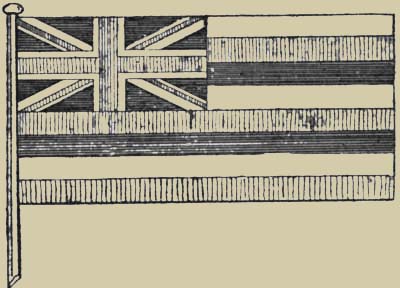
The British did not accept the proffered transfer of the islands, but returned the sovereignty to the native government, which was thereafter to continue as an independent monarchy under the protection of Great Britain; and by an accompanying treaty all British manufactures and produce were to be admitted duty free. On July 31st, 1843, the British flag was lowered and the new Hawaiian ensign raised[Pg 31] in its place.[11] It was in recognition of this event that the Union Jack was placed in the Hawaiian ensign.
In the same year France and England agreed never to take possession of the islands either by protectorate or in any other form.
The natives steadily decreased in number and in power, and the trade and commerce of the islands had passed almost entirely into American hands.
Dissensions had afterwards arisen under the subsequent native sovereigns, and in 1893 the Queen, Liliuokalani, was deposed by a revolution, and a republican government formed under President Dole, an American citizen.
Cession of the islands was offered in 1896 to the American Government and was refused, but in 1898 the islands were finally annexed to the United States and the American ensign raised; but the Hawaiian flag, with its Union Jack in the upper corner, continued as a local flag, and was so displayed on June 14th, 1900, at the inauguration of President Dole as Governor of the new-formed "Territory of Hawaii," among the Territories of the United States.
These instances of the origin of some of the national flags of other nations show how history is interwoven in their folds, and how they perpetuate the memories of past days or of the men who have dominated vital occasions. A singularly similar origin is associated with the creation of the Stars and Stripes, the ensign of the United States of North America (Pl. VI. , fig. 3), which is treated of in Chapter XVI.
THE ORIGIN OF THE JACKS.
It is quite evident, then, that national flags are not merely a haphazard patchwork of coloured bunting, nor by any means "meaningless things." Their combinations have a history, and, in many cases, tell a story; but of all the national flags there is none that bears upon its folds so interesting a story, nor has its history so plainly written in its parts and colourings, as has our British "Union Jack."
Our present enterprise is to search out whence it got its name, how it was built up into its present form, and what is the meaning of each of its several parts. This is not only an enquiry of deepest interest, but is of practical and educational value, for to trace the story of the successive combinations of our national flags is to follow the history of the British race.
The flags of other nations have mostly derived their origin from association with some dominant personage, or with a particular epoch. They are, as a rule, the signal of a dynasty or the record of some revolution; but our British Union Jack records in its folds the steady and continuous growth of a great nation, and traces, by the changes made in it during centuries of adventure and progress, and by the flags in which it has been successively combined, the[Pg 33] gradual extension of its union and methods of Constitutional Government over a world-wide Empire.
The origin of the name "Union Jack" has given rise to considerable conjecture and much interesting surmise; in the proclamation of Charles I., 1634, it is called the "Union Flagge"; in the treaty of peace made with the Dutch in 1674, in the reign of Charles II., it is mentioned as "His Majesty of Great Britain's flag or Jack," and in the proclamation of Queen Anne, in 1707, as "Our Jack, commonly called the Union Jack."
The most generally quoted suggestion given for the origin of the name is that it was acquired from the fact that the first proclamation which authorized a flag, in which the national crosses of England and Scotland were for the first time combined, was issued by James VI. of Scotland, after he had become James I. of England, and that as King James frequently signed his name in the French manner as "Jacques," this was abbreviated into "Jac," and thus his new flag came to be called a "Jack."
The derivation suggested is ingenious and interesting, but cannot be accepted as correct, for the simple reason that there were "Jacks" long before the time and reign of James I., and that their prior origin may be clearly traced.
In the earliest days of chivalry, long before the time of the Norman conquest of England, both the knights on horseback and the men on foot of the armies in the field wore a surcoat or "Jacque" (whence our word "Jacket"), extending over the body from the neck to the thighs, bearing upon it the[Pg 34] blazon or sign either of their lord or of their nationality. Numberless examples of these are to be seen in early illuminated manuscripts, or on monuments erected in many cathedrals and sanctuaries.
In the time of the Crusaders, during the eleventh and twelfth centuries, when the Christian nations of Europe were combined together to rescue Jerusalem and the Holy Land from the rule of the Mohammedan, the warrior pilgrims, recruited from the different countries, wore crosses of different shapes and colours upon their surcoats, to indicate the nationalities to which they belonged, and to evidence the holy cause in which they were engaged. It was from wearing these crosses that they gained their name of "Crusaders," or cross-bearers.
The cross worn by each of the nationalities was of a different colour—that of France being red; Flanders, green; Germany, black, and Italy, yellow.
In the earlier crusades the cross worn by the English was white, but in later expeditions the red cross of St. George was adopted and worn upon the Jacque as the sign of the English, in the same way as shown in the accompanying knightly figure (6).
The continuing use of this St. George cross, and the reason for wearing it as an identification of English forces is well shown in the following extracts from the "Ordnaunces," issued to the army with which Richard II. of England invaded Scotland in 1386:
"... Also that everi man of what estate, condicion or nation thei be of, so that he be of oure partie, bere a signe of the[Pg 35][Pg 36] armes of Saint George, large, bothe before and behynde upon parell, that yf he be slayne or wounded to deth, he that has so doon to hym shall not be putte to deth for defaulte of the crosse that he lacketh, and that non enemy do here the same token or crosse of Saint George, notwithstanding yf he be prisoner upon payne of deth."[12]
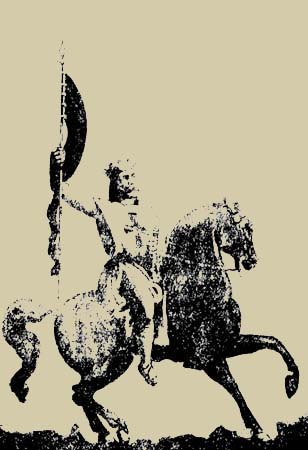
A fuller understanding is afforded of the character of this "parell," as also of the early adoption of its name by references to it given in 1415:
"At those days the yoemen had their lymmes at lybertie, and their jackes were longe and easy to shote in."[13]
The sailors of the "Cinque Ports" of Hastings, Sandwich, Hythe, Romney and Dover, on the east of England, to which Winchelsea and Rye were subsequently added, and by whose municipalities, in consideration of certain privileges granted them, the royal navies were in early days principally manned, are recorded to have worn as their uniform, in 1513, "a cote of whyte cotyn, with a red crosse and the armes of ye Ports underneathe."
In the time of Queen Mary the continuation of the custom is further evidenced by entries in a contemporary diary of 1588:
"... The x day of January hevy news came to London that the French had won Cales (Calais), the whyche was the[Pg 37] hevest tydings to England that ever was herd of.
"The xj day of January the Cete of London took up a thousand men and made them whytt cotes and red crosses and every ward of London found men.
"The xviij day of May there was sent to the shyppes men in whytt cotes and red crosses, and gones to the Queen's shyppes."[14]
These "surcoats" or "Jacques" came in time to be known as the "Jacks" of the various nationalities they represented, and it was from the raising of one of these upon a lance or staff at the bow of a ship, in order that the nationality of those on board might be made known, that a single flag bearing on it only the cross of St. George, or the cross of St. Andrew, came to be known as a "Jack." From this origin, too, the small flag-pole at the bow of a ship is still called the "Jack-staff," and similarly the short flag-pole at the stern of vessels, upon which the distinguishing Ensign of the nationality of the ship is displayed, is called the "Ensign-staff."
This custom of wearing the national Jack at the bow had not only been early established by usage, but had also been officially recognized. On the great seal of the first Lord Admiral of England, in 1409, under Henry IV., a one-masted galley is shown.[15] At the stern of the ship is the Royal Standard of the King, and at the bow a staff bearing on it the square banner or Jack of St. George, the sign of England.
Another instance of the use of these national Jacks as a sign of national union is to be noted.
During the feudal period of European history, when armed forces were called into the field, each of the nobles and leaders, as in duty bound, furnished to the cause his quota of men equipped with complete armament. These troops bore upon their arms and banners the heraldic device or coat-of-arms of their own liege lord, as a sign of "the company to which they belonged"; and in such way the particular locality from which they came, and the leadership under which they were marshalled could at once be recognized.
The Sovereigns also in their turn displayed the banner of the kingdom over which each reigned, such as the fleur-de-lis for France, the cross of St. George for England, the cross of St. Andrew for Scotland; and this banner of the king formed the ensign under which the combined forces of the royal adherents and their supporters served.
As the forces collected together came to be more the national army of the nation and less the personal adherents of their chief, it was provided in England that the liege lord of each local force should bear on his banner the cross of St. George, as well as his own coat-of-arms, the ordinance being:
"Every Standard, or Guydhome, is to hang in the chiefe the crosse of St. George and to conteyne the crest or supporter and devise of the owner."[16]
An excellent example of this is given in the standard or ensign of the forces of the Earls of Percy in the sixteenth century (Pl. III. , fig. 1). In the chief is the red cross of St. George, as the sign of allegiance to King and nation; in the fly is the crest of the Percys, a blue lion with other insignia, and their motto, "Esperance en Dieu," the signs of their liege lord and local country.
This flag declared its bearers to be the men of the Percy contingent, Englishmen, and soldiers of the King.
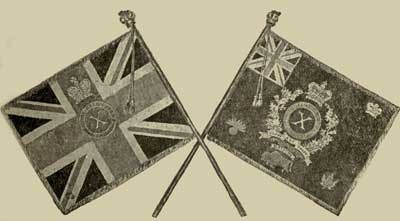
A survival of this ancient custom exists to this day in our British military service, both in the Colonial and Imperial forces. Rifle regiments do not carry "colours," but all infantry regiments are entitled,[Pg 40] upon receiving the royal warrant, to carry two flags, which are called "Colours" (7).
The "First," or "King's Colour," is the plain "Union Jack," in sign of allegiance to the Sovereign, and upon this, in the centre, is the number or designation of the regiment, surmounted by a royal crown. The "Second," or "Regimental Colour," has a small Union Jack in the upper corner. The body of the flag is of the local colour of the facings of the regiment. If the facings are blue, as in all "Royal" regiments, the flag is blue; if they are white, then the flag is white, having on it a large St. George's cross in addition to the small Union Jack in the upper corner. On the body of this colour are embroidered the regimental badge, the names of actions in which it has taken part, and any distinctive emblems indicating the special history of the regiment itself, and in territorial regiments the locality from which they are recruited. In this way both the national and local methods of distinction are to-day preserved and displayed in the same way as they were in original times; the Union Jack of the present day having been substituted for the St. George's cross of the first period.
Such, then, was the origin of the name Jack, and it is from the combination of the three national "Jacks" of England, Scotland and Ireland, at successive periods in their history, into one flag, that the well-known "Union Jack" of our British nation has gradually grown into its present form.
THE ENGLISH JACK.
A.D. 1194-1606.
The original leader and dominant partner in the three kingdoms, which have been the cradle of the British race throughout the world, was England, and it is her flag which forms the groundwork upon which our Union Flag has been built up.
The English Jack (Pl I. , fig. 1) is described in simple language as a white flag having upon it a plain red cross.
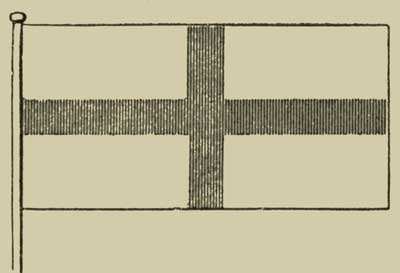
This is the banner of St. George (8), the patron saint of England, and in heraldic language is described as "Argent, a cross gules" (on silver-white a plain red cross).
The great Christian hero, St. George, is stated by those who have made most intimate search into his legend and history[17] to have been descended from a noble Cappadocian Christian family, and to have been beheaded for his faith on the 23rd April, A.D.[Pg 42] 303, during the persecution of the Christians by the Emperor Diocletian. The anniversary of that day is for that reason celebrated as St. George's Day. He was a soldier of highest renown, a knight of purest honour, and many exploits of his heroism and courage are narrated in ancient prose and poetry.
About three miles north along the shore of the Mediterranean, from the city of Beyrut (Beyrout), there was in the time of the Crusaders, and still remains, an ancient grotto cut into the rock, and famous as being the traditional place where the gallant knight St. George,
was reputed to have performed one of his most doughty deeds, and had "redeemed the King's daughter out of the fiery jaws of a dreadful dragon.[19]
The memory of St. George has always been greatly revered in the East, particularly by the Christian Greek Church, by which he was acclaimed as the "Victorious One," the "Champion Knight of Christendom," and early accepted as the protector saint of soldiers and sailors. One of the first churches erected by Constantine the Great, about A.D. 313, and many other Eastern churches, were dedicated to him.
It is to be noted, however, that St. George has never been canonized by the Roman Church, nor his name placed in her calendar of sacred saints. His name, like those of St. Christopher, St. Sebastian and[Pg 43] St. Nicholas, was only included in a list issued in A.D. 494, by Pope Gelasius, as being among those "whose names are justly reverenced among men, but whose actions are known only to God.[20]
The form of his cross is that known as the Greek Cross, the four arms being at right angles to each other, and in this form is displayed in the upper corner of the national Greek ensign, in this case as a white cross on a blue ground. (Pl II., fig. 3.)
This Greek religious connection has also caused the adoption of the cross of St. George in the insignia of other nations. The Czar of Russia is not only the "Autocrat of the People of the Empire of all the Russias," but he is also the "Supreme Head of the Orthodox Faith," which in Russia is represented by the Greek Church. His Imperial Standard is a yellow flag upon which is displayed a black two-headed eagle bearing upon its breast a red shield on which is emblazoned in white the figure of St. George slaying a dragon. This same colouring, white on red, is followed in the decoration of the Order of St. George, which is the second order of knighthood in Russia, and in the white cross of St. George, as shown in the official flags of the Russian ambassadors.
On the royal arms of Austria the black two-headed eagle bears on its breast a shield with a red ground having on it a white St. George's cross.
The insignia of eight nations bear the Greek cross of the St. George shape, but in four different colours on grounds of three different colours:
| Greece | a | white | cross | on a | blue | ground. |
| Russia | a | " | " | " | red | " |
| Austria | a | " | " | " | " | " |
| Denmark | a | " | " | " | " | " |
| Switzerland | a | " | " | " | " | " |
| Norway | a | blue | " | " | " | " |
| Sweden | a | yellow | " | " | blue | " |
| England | a | red | " | " | white | " |
England is, however, the only nation which has adopted the Red cross of St. George as its special national ensign.
The cry of "St. George for Merrie England" has re-echoed through so many centuries that his place as the patron saint of the kingdom is firmly established. Wherever ships have sailed, there the red cross of St. George has been carried by the sailor-nation who chose him as their hero.
The incident from which came his adoption as patron saint is thus narrated in the early chronicles. In 1190, Richard I., Cœur de Lion, of England, had joined the French, Germans and Franks in the third great crusade to the Holy Land; but while the other nations proceeded overland to the seat of war, Richard built and engaged a great fleet, in which he conveyed his English troops to Palestine by sea. His armament consisted of "254 talle shippes and about three score galliots." Sailing down the eastern shore with these and arriving off the coast, he won a gallant sea-fight over the Saracens near Beyrut, and the grotto of St. George, and by this victory intercepted the reinforcements which their ships were carrying to the[Pg 45] relief of Acre, at that time being besieged by the combined armies of the Crusaders.
St. George, the redresser of wrongs, the protector of women, the model of Christian chivalry, and the tutelary saint of England, was not a seafaring hero, nor himself connected with the sea, but it was after and in memory of their sailors' victory near the scene of his exploits that the seafaring nation adopted him as their patron saint.
The red cross emblem of St. George is stated by the chroniclers to have been at once thereafter adopted by Richard I., who immediately placed himself and his army under the especial protection of the Saint, raised his banner at their head, and is reported to have introduced the emblem into England itself after his return in 1194. Further evidence of its introduction and its continued use is given by the record that in 1222 St. George's Day was ordered to be kept as a holiday in England.[21]
Some aver that the emblem was not generally accepted until under Edward I., in 1274. This prince, before his accession to the throne, had served in the last Crusades, and during that time had visited the scene of the victory and the grotto of the Saint. It is pointed out that this visit of Prince Edward to Palestine coincided with the change made in their badge by the English Order of the Knights of St. John of Jerusalem from an eight-pointed Maltese cross to a straight white Greek cross, and that at the time of this change came the appearance upon the English banners of the St. George's cross, but of the[Pg 46] English national colour red,[22] therefore they deduce that the further employment of the emblem as the national flag was then additionally authorized by Edward I.
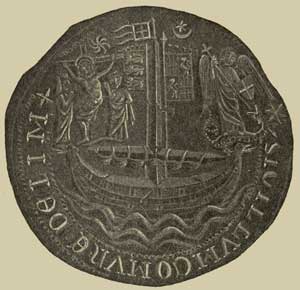
From this last date (1274) onward the St. George's cross and the legend of "St. George and the Dragon" in England are, at all events, in plain evidence. An early instance is that found in the borough of Lyme[Pg 47] Regis, in Dorset, to which Edward I., in 1284, granted its first charter of incorporation and its official seal. A photo reproduction of a wax impression of this borough seal (9), taken from an old "Toll lease" is here given. The flag of St. George is seen at the mast-head, and below it the Royal Standard of Richard I., with its three lions for England, carried by Edward in Palestine during the lifetime of his father. At the bow of the ship is the figure of the Saint represented in the act of slaying the dragon, and having on his shield the St. George's cross.
The religious and Christian attributes of St. George are commemorated on the seal by the representation of the Crucifixion and by the Saint, the head of whose spear is a St. George's cross, being shown as in angel form. The sea tradition of his adoption is also sustained by the characteristic introduction of the "galley" into the design.
Around the edge of the seal is the rude lettering of the inscription in Latin: "Sigillum: Comune: De: Lim" ("The common seal of Lyme"). Near the top may be seen the "star and crescent" badge[Pg 48] of Richard I., adopted by him as a record of his naval victory, and which is still used as an "admiralty badge" upon the epaulettes of admirals of the British navy.
This seal of Lyme Regis is said to be the earliest representation of St. George and the dragon known in England.
The same form of cross was placed by Edward I., in 1294, upon the monumental crosses which he raised at Cheapside, Charing Cross and other places, in memory of his loved Queen Eleanor, to mark the spots at which her body rested during the funeral procession when her remains were carried from Lincoln through Northampton to London.
Another instance of a later date is found on a "sepulchral brass" (10), placed to the memory of Sir Hugh Hastings in Elsing Church, Norfolk, and dated 1347.
These plates of engraved brass, inserted in the stone coverings of so many graves in the interior of the churches in England, are most interesting examples of early memorial art. The figure of the deceased is usually drawn in full length upon them in lines cut deeply into the metal, and is accompanied by an inscription setting forth his deeds and his name.
In the upper part of the architectural tracery surrounding the figure on the brass in question is a circle 8-1/4 inches in diameter, in which the figure of St. George is as shown. The Saint here appears as a knight, clad in full armour and mounted upon horseback, representing him in his character as the leader of chivalry and knightly manhood. A further de[Pg 49]velopment of the attribute of manly vigour will be noted in that, instead of being shown as piercing, as previously, the fiery dragon of the ancient legend, he is now represented as slaying the equally typical two-legged demon of vice. This representation still further exemplifies the teaching and allegory of the emblem of "St. George and the Dragon."
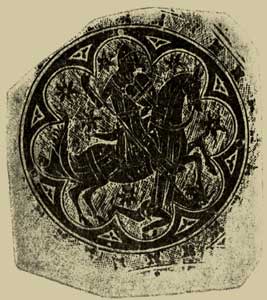
St. George represents the Principle of Good, the Dragon the Principle of Evil. It is the contest be[Pg 50]tween virtue and vice, in which the knight by his virtues prevails—a splendid emblem for a Christian people.
This photo reproduction is from a "rubbing" in black lead recently taken from the brass, and shows, so far as the reduced scale will permit, the St. George's crosses upon the surcoat and shield of the knight and the trappings of his horse.
In 1350, on St. George's Day, the "most noble Order of the Garter" was instituted by Edward III., with magnificent ceremony in the St. George's Chapel, Windsor Castle. This is the highest order of knighthood in the kingdom. Its jewel, called "The George," is a representation of St. George and the Dragon, and in the centre of the "Star" of the Order is the red cross of St. George.
So onward through all the centuries, and now St. George is the acclaimed patron saint of England and all Englishmen.
It was under this red cross banner of St. George that Richard I., the Lion-hearted, after proving their seamanship in victory and giving his men their battle-cry, "Saint George—forward!"[24] showed the mettle of his English Crusaders in the battles of the Holy Land, and led them to the walls of Jerusalem. With it the fleets of Edward I. claimed and maintained the "lordship of the Narrow Seas." Under this single red cross flag the ships of England won the epochal naval victory of Sluys, where the English bowman shot his feathered shafts from shipboard as blithely as when afterwards on land the[Pg 51] French battlefields resounded to the cry of "England and St. George," when the undying glories of Cressy and Poictiers were achieved, and again at Agincourt when Henry V. led on his men to victory. Under it, too, Cabot discovered Cape Breton, Drake sailed around the world, Frobisher sought the Northwest passage, Raleigh founded Virginia, and the navy of Elizabeth carried confusion into the ill-fated Spanish Armada.
This is a "glory roll" which justifies the name of England as "Mistress of the Seas." Her patron saint was won as a record of naval victory. With this red cross flag of St. George flying above them, her English sailors swept the seas around their white-cliffed coasts, and made the ships of all other nations do obeisance to it. With it they penetrated distant oceans, and planted it on previously unknown lands as signs of the sovereignty of their king, making the power of England and England's flag known throughout the circle of the world.
All this was done before the time when the sister-nations had joined their flags with hers, and it is a just tribute to the seafaring prowess of the English people, and to the victories won by the English Jack, that the single St. George's cross is in the British fleets the Admiral's Flag, and flies as his badge of rank; that it is in the Command Pennant of all captains and officers in command of ships, and that the English red cross flag is the groundwork of the White Ensign of the British navy (Pl. VIII., fig. 2). This is the "distinction flag" of the British navy, allowed to be carried only by His Majesty's ships-of-war, and[Pg 52] restricted, except by special grant, solely to those bearing the Royal commission.[25]
Thus has the memory of Richard I. and his men been preserved, and all honour done to the "Mariners of England," the sons of St. George, whose single red cross flag, the English Jack, has worthily won the poet's praise:
THE SUPREMACY OF THE ENGLISH JACK.
A.D. 871-1606.
While it is true that flags and banners had grown up on land from the necessity of having some means of identifying the knights and nobles, whose faces were encased and hidden from sight within their helmets, yet it was at sea that they attained to their greatest estimation. There the flag upon the mast became the ensign of the nation to which the vessel belonged, and formed the very embodiment of its power. To fly the flag was an act of defiance, to lower it an evidence of submission, and thus the motions of these little coloured cloths at sea became of highest importance.
The supremacy of one nation over another was measured most readily by the precedence which its flag received from the ships of other nationalities. National pride, therefore, became involved in the question of the supremacy of the flag at sea, and in this contest the English were not behindhand in taking their share, for the supremacy of the sea meant to England something more than the mere precedence of her flag. It meant that no other power should be allowed to surpass her as a naval power; not that she desired to carry strife against their coun[Pg 54]tries, but esteemed it more for the protection of her own shores at home, and the preservation of peace along the confines of her island seas.
This faith in the maintenance of the Supremacy of the Seas remains potent to this present day, as is shown by the demand of the British people that their navy shall be maintained at a two-power standard, and so be equal in strength to the navies of any other two of the nations which sail the oceans. It is no new ardour, nor the outcome of any modern development or exigency, but is the outgrowth of the determination of the nation from its earliest days to maintain the supremacy of its flag, and is strengthened by the lessons learned in those centuries.
Alfred the Great of England (871-901) was the first to establish any supremacy for the English flag, and to him is attributed the first gathering together of a Royal navy, the creation of an efficient force at sea being a portion of that sea-policy which he so early declared, and which has ever since been the ruling guide of the English people. The true defence of England lay, Alfred considered, in maintaining a fleet at sea of sufficient power to stretch out afar, rather than in trusting to fortifications for effective land resistance when the enemy had reached her shores; that it was better to beat the enemy at sea before he has a chance to land, and thus to forestall invasion before it came too near—a policy which in these days of steam is simply being reproduced by the creation of "Dreadnoughts," swift and strong, to hit hard on distant seas. The bulwarks of England were considered in his time, as they are still considered, to[Pg 55] be her ships at sea rather than the parapets of her forts on land.
Introducing galleys longer and faster than those of the Danes,[28] Alfred kept his enemies at a respectful distance, and, dwelling secure under the protection of his fleet, was thus enabled to devote himself with untrammelled energy to the establishment of the internal government of his kingdom.
His successors followed up his ideas, and under Athelstane (901) the creation of an English merchant navy was also developed. Every inducement was offered to merchants who should engage in maritime ventures. Among other decrees then made was one that, "if a merchant so thrives that he pass thrice over the wide seas in his own craft he was henceforth a Thane righte worthie."[29] Thus honours were to be won as well as wealth, and in pursuit of both the merchants of England extended their energies to wider traffic on the seas.
King Edgar (973-75), by virtue of his navy, won and assumed the title of "Supreme Lord and Governor of the Ocean lying around about Britain." Thus did the English flag, carried by its navies, sail the seas. But Harold, the last of the Saxon kings, instead of maintaining his ships in equipment and fitness to protect his shores, allowed them, for want of adequate[Pg 56] provisions, to be dispersed from their station behind the Isle of Wight, and so, forgetting the teachings of Alfred, left his southern coasts unguarded and let the Norman invader have opportunity to land, an opportunity which was promptly seized.
The Norman monarchs of England held in their turn to the supremacy which the early Saxon kings had claimed for her flag at sea.
When the conquest of England, in 1066, had been completely effected by the Norman forces, the shores on each side of the "narrow seas" between England and Normandy were combined under the rule of William the Conqueror, communication by water increased between the two portions of his realm, and the maritime interests of the people were greatly extended and established.
Richard I. showed England to the other nations, during the Crusades, as a strong maritime power. King John followed in his footsteps, and in 1200, the second year of his reign, issued his declaration directing that ships of all other nations must honour his Royal flag:
"If any lieutenant of the King's fleet in any naval expedition, do meet with on the sea any ship or vessels, laden or unladen, that will not vail and lower their sails at the command of the Lieutenant of the King or the King's Admiral, but shall fight with them of the fleet, such, if taken, shall be reported as enemies, and the vessels and goods shall be seized and forfeited as the goods of enemies."
The supremacy which King John thus claimed, his successors afterwards maintained and extended, so that under Edward I., Spain, Germany, Holland, Denmark, and Norway, being all the other nations, except France, which bordered on the adjacent seas, joined in according to England "possession of the sovereignty of the English seas and the Isles therein,"[30] together with admission of the right which the English had of maintaining sovereign guard over these seas, and over all the ships of other Dominions, as well as their own, which might be passing through them.
Edward II. was given, in 1320, the title of "Lord of the Seas."[31]
Edward III., himself a sailor-king and commander of his fleets, was fully imbued with the force of the Alfred maxim, so that when invasion threatened England he said, "he deemed it better with a strong hand to go seek the enemy in his own country than wait ignobly at home for the threatened danger."[32] Putting his maxim into action he led his fleet across the Channel, and his victory over the French fleet at Sluys, off Flanders, on the 24th June, 1340, was the Trafalgar of its day, and the resulting supremacy of the English Jack on the narrow seas enabled him to land his forces on the foreign shores, when he subsequently invaded France to establish his claim to the French throne.
The prowess of himself and of his seamen in their[Pg 58] victory over the French and Spanish fleets won for Edward the proud title of "King of the Seas," in token of which he was represented upon his gold coinage standing in a ship "full royally apparelled."[33]
During the Wars of the Roses less attention was given by the nation to maritime matters, and while the English were so busily engaged in fighting amongst themselves, the Dutch of the Netherlands, under the Duke of Burgundy, developed a large carrying trade, and so increased their fleets that, in 1485, at the accession of Henry VII., they had become a formidable shipping rival of England, and were a thorn in the side of France. Over the ships of the French the Dutch so lorded it on the narrow seas that, to quote Philip de Commines, their
"navy was so mighty and strong, that no man durst stir in these narrow seas for fear of it making war upon the King of France's subjects and threatening them everywhere."
Two flags, the striped standard of the Dutch and the red cross Jack of the English, were now rivalling each other on the adjacent seas and on the Atlantic. The contest for the supremacy which had begun was continued for nearly two hundred years thereafter.
In the time of Henry VII. more attention was given to merchant shipping and foreign adventure. Cabot carried the English flag across the Atlantic under the license which he and his associates received from Henry VII., empowering them
"to seek out and find whatsoever isles, countries, regions, or provinces of the heathen and infidels, whatsoever they might be; and set up his banner on every isle or mainland by them newly found."
With this authority for its exploits the red cross of St. George was planted, in 1497, on the shores of Newfoundland and Florida, and the English Jack thus first carried into America formed the foundation for the subsequent British claim to sovereignty over all the intervening coasts along the Atlantic.
Under Henry VIII. England began to bestir herself in making provision for a regular navy. A drawing in the Pepysian Library gives the details of the Henri Grace à Dieu (11), built in 1515 by order of Henry VIII., which was the greatest warship up to that time built in England, and has been termed the "parent of the British Navy." At the four mastheads fly St. George's ensigns, and from the bowsprit end and from each of the round tops upon the lower masts are long streamers with the St. George's cross, very similar in form to the naval pennants of the present day. The castellated building at the bow, and the hooks with which the yards are armed, tell of the derivation of the nautical terms "forecastle" and "yard arm" still in use.
With such improved armament the cross of St. George continued to ruffle its way on the narrow seas, and widened the scope of its domain.
The supremacy claimed for the English Jack never lost anything at the hands of its bearers, and an event which occurred in the reign of Queen Mary gives a[Pg 60] vivid picture of the boldness of the sea-dogs by whom it was carried, and of how they held their own over any rival craft:
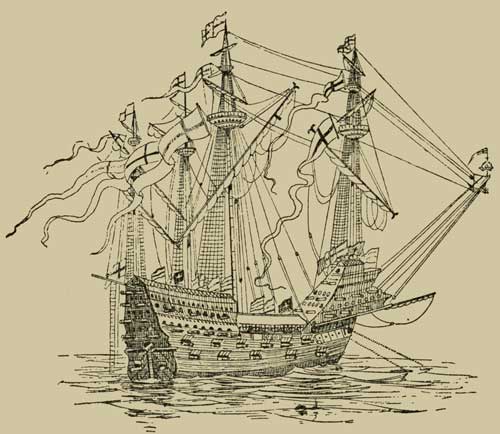
(From the Pepysian collection.)
The Spanish fleet, of one hundred and sixty sail, was escorting Philip II., of Spain, when coming to his marriage with the English Queen, in 1554. It was met off Southampton by the English fleet, of twenty-eight sail, under Lord William Howard, who was then "Lord High Admiral in the narrow seas." The Spanish fleet, with their King on board, was fly[Pg 61]ing the Royal flag of Spain, and was proceeding to pass the English ships without paying the customary honours. The English admiral promptly fired a shot into the Spanish admiral's ship, and the whole fleet was obliged to strike their colours and lower their topsails in homage to the English flag. Not until this salute had been properly done would Howard permit his own squadron to salute the Spanish King.[34]
Under Elizabeth seamanship mightily increased. Her merchant fleets, from being mere coasters, extended their ventures to far distant voyages, in some of which the Queen herself was said to have had an interest; and while before her time soldiers had exceeded seamen in numbers, the positions were now reversed.
The defeat of the Spanish Armada, in 1588, was one of the crowning achievements of the supremacy of the English Jack, yet it would almost seem as though the glorious flag had, in the never-to-be-forgotten action of the undaunted Revenge, kept for the closing years of its single cross period the grandest of all the many strifes in which it had been engaged.
England and Spain were then at open war. The English fleet, consisting of six Queen's ships, six victuallers of London, and two or three pinnaces, was riding at anchor near the island of Flores, in the Azores, waiting for the coming of the Spanish fleet, which was expected to pass on its way from the West Indies, where it had wintered the preceding year. On the 1st September, 1591, the enemy came in sight,[Pg 62] numbering fifty-three sail, "the first time since the great Armada that the King of Spain had shown himself so strong at sea."[35]
The English had been refitting their equipment, the sick had all been sent on shore, and their ships were not in readiness to meet so overwhelming an armament. On the approach of the Spaniards, and to save the fleet from being penned in by them along the coast, five of the English ships slipped their cables, and together with the consorts sailed out to sea. Sir Richard Grenville, in the Revenge, was left behind to collect the men on shore and bring off the sick, and so, after having done this duty, came out alone to meet the enemy, which was marshalled in long extended line outside the port. He might have sailed around their wing, but this would have been an admission of inferiority, and, bold to recklessness, he thrust his little ship right through the centre of their line. Rather than strike his flag, he withstood the onset of all the Spanish fleet, which closed in succession around him, and thus this century of the red cross Jack closed with a sea-fight worthy of its story, and one which has been preserved by a Poet Laureate in undying verse, whose lines ought to be known by every British boy:
In such way, audacious in victory and unconquered in defeat, the English sailors, beneath their English Jack, held for the mastery of the oceans from Alfred to Elizabeth, and laid the foundations of that maritime spirit which still holds for Great Britain the proud supremacy of the seas.
THE SCOTTISH JACK.
From a very early period St. Andrew has been esteemed as the patron saint of Scotland, and held in veneration quite as strong as that entertained in England for St. George. The "saltire," or diagonal cross of St. Andrew (12), shaped like the letter X is attributed to the tradition that the saint, considering himself unworthy to be crucified on a cross of the same shape as that on which his Saviour had suffered, had, by his own choice, been crucified with legs and arms extended upon a cross of this shape, and, therefore, it has been accepted as the emblem of his martyrdom.
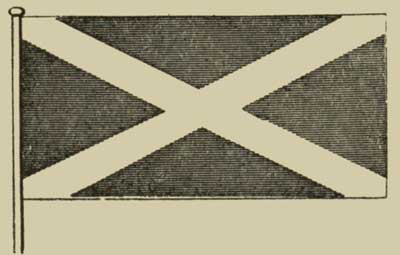
The "Scottish Jack" (Pl I., fig. 2) is a white oblong cross upon a blue ground. This is the banner of St. Andrew (12), and in heraldic language is described as "Azure, a saltire argent" (on azure blue, a silver-white saltire).
How St. Andrew came to be adopted as the patron saint of Scotland is a subject of much varying conjecture. It is said that in the early centuries, about A.D. 370, some relics of the apostle St. Andrew were[Pg 65] being brought to Scotland by some Greek monks, and although the vessel carrying them was wrecked and became a total loss, the sacred bones were brought safe to shore at the port in the County of Fife, still called St. Andrews, where a church was erected to his memory.
The most favoured tradition as to the date of his authorized adoption as a patron saint is that it occurred in A.D. 987, when Hungus, king of the Picts, was being attacked by Athelstane, the king of the West Saxons,[37] Achaius, king of the Scots, with 10,000 of his Scottish subjects, came to the relief of Hungus, and the two kings joined their forces to repel the Southern invaders. The Scottish leaders, face to face with so formidable a foe, were passing the night in prayer to God and St. Andrew, when upon the background of the blue sky there appeared, formed in white clouds, the figure of the white cross of the martyr saint. Reanimated by this answering sign, the Scottish soldiers entered the fray with enthusiastic valour, and beset the English with such ardour as to drive them in confusion from the field, leaving their king, Athelstane, behind them dead among the slain. Since that time the white saltire cross, upon a blue ground, the banner of St. Andrew, has been carried by the Scots as their national ensign.
This was the flag carried by the great Scottish national hero, Robert-the-Bruce, whose valour won for him the crown of Scotland, and whose descendants, the earls of Elgin, still bear his banner on their coat[Pg 66]of-arms. At Bannockburn, in 1314, this emblem of Bruce rose victorious over Edward II. and his stolid Englishmen. Its use was continued in 1385, when the Scots, stirred up and aided by Charles VI. of France, invaded and despoiled the border counties of England, in which expeditions both they and their French auxiliaries wore a white St. Andrew's cross upon their jacques, both before and behind, in order that they might distinguish the soldiers of their combined companies from the forces of the foe.[38]
But St. Andrew's flag was not always victorious. At Chevy Chase and Flodden Field it suffered defeat, but only in such wise as to prove the truth of the warning motto of the prickly Scotch thistle, "Nemo me impune lacessit"—(No one may touch me with impunity).
The Scottish Jack in all these early centuries, unlike its English compeer, does not appear to have been carried by Scotsmen far afield, nor in expeditions across the seas. On land, the Scots used it mainly as a sign of recognition during the forays which they kept up with unceasing vigour on the neighbouring kingdoms of England and Ireland; and at sea its scene of action was kept measurably near to their own shores.
Scotland, being so far removed from the fleets of the southern nations of Europe, did not need a regular navy, and never had one of any size,[39] but her far[Pg 67] northern coasts, indented with deep bays and bordered by wild fastnesses, adapted themselves admirably to the use to which they were mainly put, of being the lair from which hardy, venturesome freebooters, in those times called "sea rovers," sailed forth in their "talle shippes" (13), and pounced down upon the[Pg 68] vessels of the passersby. The exploits of some of these sailors, under the St. Andrew's Jack, crop out from time to time with splendid audacity in the history of the centuries. One "Mercer, a Scottish rover," during the reign of Richard II. of England, so harried the merchant shipping of England that, in 1378, Alderman John Philpot, "a worshipful citizen of London," equipped an expedition at his own expense to cramp the energies of the marauder, and meeting Mercer and fifteen Spanish ships, which were acting with him, brought the whole fleet, "besides great riches which were found on board," in triumph into port at Scarborough in Yorkshire. Philpot was haled before the English royal authorities for having dared "to set forth a navy of men-of-war without the advice of the King's Council," but the end was considered to have justified the means, and the bold citizen, who by his own action had put down the annoyance with which the officers of the realm should have dealt, was, after having himself stoutly berated the Council for their sluggishness, let go free.
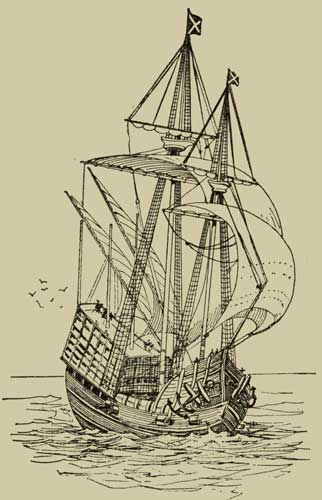
(From a painting by Vandyck.)
Sir Andrew Wood, of Leith, who for a long time pillaged the English ships and set the navy of Henry VII. at defiance, was another doughty champion of the St. Andrew's cross.
Growing bolder in his defiance, he challenged the English Royal Navy to a contest. The challenge was accepted, and three chosen ships were sent to meet him. These he overmastered, and carried off his prizes and their crews to Dundee, from where, after the wounded had been cared for, and the damages of the vessels repaired, James IV. of Scotland returned[Pg 69] the ships and their men to Henry, saying, "the contest had been for honour, not for booty."[40]
But the greatest hero of them all, the one whose deeds have woven themselves into the folklore of the Scottish race, was Sir Andrew Barton, who in the time of Henry VIII. not only plundered his English neighbours, but also took toll of the ships of all other nations without regard to their flag, making himself the terror of the North Seas. An old ballad tells in quaint style what an English merchant of Newcastle, whose ships had fallen into the hands of Barton, is said to have reported to the English Admiral, who was in charge of the "Narrow Seas":
Sir Andrew was the last of the freebooters, as the rise of the navy of Henry VIII., and the union of the two kingdoms of England and Scotland by James I. under one crown, put an end to these reprisals by the subjects of the one nation on the other; yet, as we shall see, it was the remnants of these very rivalries thus engendered between the single cross flags of St. Andrew and St. George which led to these national Jacks of the two nations being afterwards joined together to form one flag.
St. Andrew is also venerated by the Russians as a national saint, their tradition being that it was through the Apostle St. Andrew that the gospel of Christianity had been brought to their people. Their highest order of knighthood, created by Peter the Great, in 1698, is the Order of St. Andrew, and the national flag of Russia, borne by all their people and on their imperial navy, is the St. Andrew's cross. It is also used on the masthead of their war vessels to indicate the rank of an admiral.
It will be remembered that the Russians have transposed the colours of the banner of St. George from a red cross on a white ground, as on the English Jack, to be on theirs a white cross on a red ground. So also they have transposed the colours on their St. Andrew's flag to be a blue cross on a white ground instead of a white cross on a blue ground as on the Scottish flag.
THE "ADDITIONAL" UNION JACK OF JAMES I.
A.D. 1606-1648.
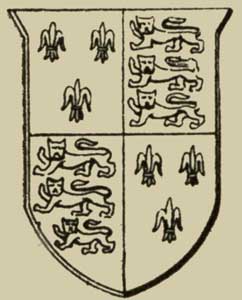
The kingdoms of England and Scotland had passed through their centuries of dissension and conflict when at length, in March, 1603, upon the death of his second cousin, Elizabeth, Queen of England, James VI., King of Scotland, succeeded to her throne, and became also King James I. of England. Before entering upon the subject of the joining of the two national Jacks in one flag, it may be well to consider the changes then made in the Royal Standard in consequence of this union of the crowns. The Royal Standard is the special personal flag of the Sovereign, and wears upon it his Royal arms emblazoned with "devise" or insignia of the kingdoms over which he rules. James, upon ascending the throne of England, immediately issued a proclamation instructing a change to be made in its then existing form (14). Richard I., Cœur de Lion, had displayed on his Royal Standard the three golden[Pg 72] lions on a red ground, the sign of England. To these Henry V. had added three golden fleur-de-lis on a blue ground, typifying his right to the throne of France. This standard was used thereafter by all his successors, the sovereigns of England, and by Elizabeth. A change was now made by James to represent his additional sovereignties. To the standard of Elizabeth he added the lion rampant of Scotland and also the harp of Ireland, which had not previously been included in the Royal Arms (15), thus placing the three lions for England and three fleurs-de-lis for France in the first and fourth quarters; the lion rampant for Scotland in the second, and the harp for Ireland in the third quarter.
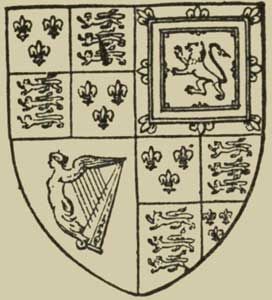
While he changed the English Royal Standard, no change was instructed to be made, nor was evidently considered to be necessary, in the English national flag of St. George, which continued to be used as previously on the English ships by his new subjects. Thus in the early years of the reign of James, the English and Scotch ships continued to use their respective "red crosse" and "white crosse" Jacks, exactly as they had done prior to his accession to the English throne.
The nations had now been brought into closer contact, and the movement of shipping along their shores much increased as each was relieved from any fear of attack by the other.
Each nation, no doubt, retained a predilection for its own national flag—a preference which its adherents expressed each in their own way, and most probably in terms not untinged by caustic references to controversies and contentions of previous days.
When James had ascended the throne of England, it was his great desire to be styled King of "Great Britain," as well as of "France and Ireland." He had caused himself at the outset to be so proclaimed, and afterwards used the phrase in his proclamations, but without due authority. During the first year of his reign opinions on the point were asked of the Judges of the courts, and also of the Lords and Commons of England, but the replies of all were unanimously against his right to the assumption of any such title, as being one which might seem to indicate a fusion of the two kingdoms.
The fact was, that although the two kingdoms of Scotland and England had been joined in allegiance to the same sovereign, who was equally king of each, yet as each kingdom still retained its own separate parliament, their union had not been made adequately complete. The King had particularly desired to complete this union. In a proclamation he issued, he states he had found among the "better disposed" of his subjects
"a most earnest desire that the sayd happy union should be perfected, the memory of all preterite discontentments abolished, and all the inhabitants of both the realms to be the subjects of one kingdom."
He says he will himself use every diligence to have it perfected,
"with the advice of the states and parliament of both the kingdoms, and in the meantime till the said union be established with due solemnite aforesaid, His Majesty doth repute, hold and esteem both the two realms as presently united, and as one realm and kingdome, and the subjects of both the realms as one people, brethren and members of one body."
But charm he never so wisely, the King could not get his subjects to see matters in the same light as himself, nor was he able to get their Parliaments to unite.
Thus it occurred that in 1606, in the fourth year after the joining of the two thrones, the King, finding that difficulties kept arising about their flags between the subjects of his two adjacent kingdoms, considered it advisable to issue a proclamation declaring the manner in which they were in future to display their national Jacks, and also authorizing a new flag, which was to be used by each in addition to their own national flag. This flag was the "additional" Jack of James I. (16).
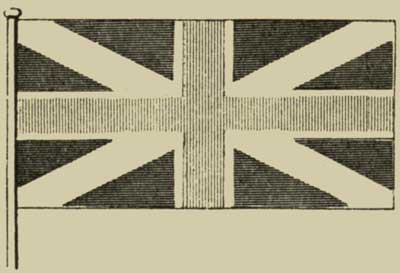
It is probable that the English sailor had objected to seeing the Scottish cross raised on the mast above[Pg 75] his English flag, and the Scotsman, on his part, too, did not like to see St. Andrew below St. George. The additional flag was designed for the purpose of meeting this difficulty, and was ordered to be raised by itself upon the mainmast. It is evident that some ships had been flying both the national flags, for, as a further precaution, particular instruction was given that each ship should fly only one national cross, and this was to be only the cross of its own nationality. All controversy as to the precedence of the respective Jacks was thus intended to be brought to an end.
This proclamation of 1606, as copied from an original issue in the British Museum, reads as follows:
"A proclamation declaring what Flagges South and North Britaines shall beare at Sea.
"BY THE KING:
"Whereas, some difference hath arisen between our subjects of South and North Britaine travelling by Seas, about the bearing of their Flagges: For the avoiding of all such contentions hereafter wee have, with the advice of Our Councell, ordered: That from henceforth all our subjects of this Isle and Kingdome of Great Britaine, and all our members thereof, shall beare in their maine toppe the Red Crosse, commonly called St. George's Crosse, and the White Crosse, commonly called St. Andrew's Crosse, joyned together according to the forme made by our heralds, and sent by us[Pg 76] to our Admerell to be published to our subjects; and in their fore-toppe our Subjects of South Britaine shall weare the Red Crosse onely as they were wont, and our Subjects of North Britaine in their fore-toppe the White Crosse onely as they were accustomed.
"Wherefore wee will and command all our Subjects to be conformable and obedient to this our Order, and that from henceforth they do not use to beare their flagges in any other sort, as they will answere to contrary at their peril.
"Given at our Palace of Westminster, the twelfth day of April, in the fourth yere of our Reine of Great Britaine, France and Ireland, etc. God save the King."
This King's Jack, which subsequently came to be commonly known as the "Union Flagge," was, it will be noted, not intended to supersede the existing national Jacks, for it was directed to be displayed in addition to, and at the same time with, the Jack of each nation. The new flag of the King was to be raised by itself on the mainmast, and the old national flag on the foremast, so that each of these flags should be kept separate from one another.
The reason for this separate use of two flags is evident, one which is fully confirmed in the creation of the Union Jacks which succeeded one another in subsequent reigns.
The reason was that the two Parliaments of the nations had not been united in one, and, therefore, it was that each nation continued to retain its own[Pg 77] distinctive national cross, which it flew on the flagstaff as the sign of its own particular nationality, and which was, therefore, not displaced by the King's newly created flag.
PLATE III.
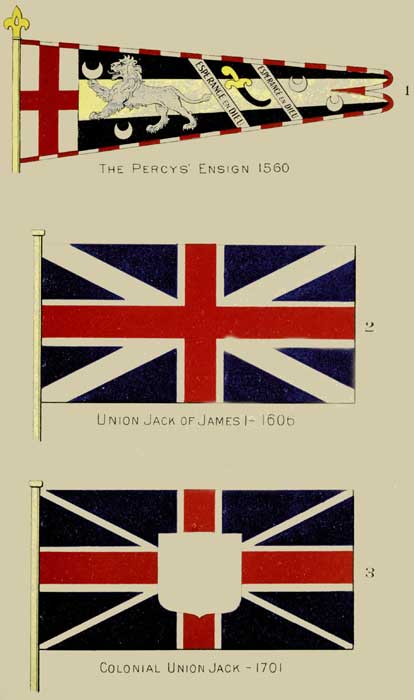
| 1 The Percys' Ensign 1560 |
| 2 Union Jack of James I-1606 |
| 3 Colonial Union Jack-17011 |
The position of the flag was, in 1606, regulated to be:
| A.D., 1606. | |
| Royal Navy— | Maintop, King's Jack. |
| Merchantmen— | |
| English Subjects— | Maintop, "additional" King's Jack.Foretop, English Jack. |
| Scottish Subjects— | Maintop, "additional" King's Jack.Foretop, Scottish Jack. |
The construction of the new flag presents some peculiarities.
In this "additional" Jack of James I. (Pl. III., fig. 2), the red cross of St. George and its white ground, being the "St. George's crosse," had been ordered by the proclamation to be united with the white cross of St. Andrew and its blue ground, being the "St. Andrewe's crosse," the two flags being "joyned together according to the forme made by our heralds." In this "joining" the white ground of St. George's flag was reduced almost to a nullity.
As the form was the creation of heralds, it was made according to the strict heraldic rules of their highly technical craft. In heraldry, a narrow border of white or gold, termed a "fimbriation," is always introduced where colour would otherwise touch on colour for the purpose of keeping the colours separate,[Pg 78] the technical statement of the rule being, "metal cannot be placed upon metal, nor colour upon colour." The heralds, therefore, in conformity with their tendencies, reduced the white ground of the St. George flag until it became only a narrow margin of white, just sufficient to keep the red of the cross of St. George from touching the blue ground of St. Andrew's flag upon which it was laid, or so that the white ground became simply "a fimbriation to the red cross of St. George."
The union of the two flags resulted in the Scotsman getting a good share of all that was going. It is true the crosses of the two flags were given equal display, but the white ground of the St. George's English Jack had entirely disappeared, while the blue ground of the St. Andrew's had been left in occupation of all the remaining space. No wonder that an English admiral of the "narrow seas," hankering after his old St. George Jack, says, a few years afterwards, of this new flag: "Though it may be more honour to both the kingdoms to be thus linked and united together, yet, in view of the spectators, it makes not so fair a show, if it would please His Majesty."[41]
The Scotsmen also raised objection to the cross of St. George having been placed over and in front of that of St. Andrew.[42] With, what appears to us now, much quaintness of language, the Scottish Privy Council made its formal complaint to His Majesty in a letter of 7th August, 1606, saying that,
"the forme and patrone of the flagges of schippis sent down heir and commandit to be ressavit and used be the subjectis of both kingdomes is vereie prejudicial to the fredome and dignitie of this Estate, and wil gif occasion to reprotche—becaus as your Sacred Majestie may persave, the Scottis Croce, callit Sanctandrois Croce, is troyse dividit, and the English Croce, called Sanct George, drawne through the Scottis Croce, which is thereby obscurit."
Either one or the other of the crosses had to be in front, but as the whole of their blue ground had been retained, while the Englishman had lost all the white ground of his flag, the objection was not entertained.
This two-crossed Jack of James I., 1606, continued in use in the Royal Navy for over a century, with the exception of its retirement during the changes which, as we shall hereafter note, were made under Cromwell. During its term the British kingdom, which had already under the English Jack colonized the mainland of America from Massachusetts to Virginia, became more than ever an American power; for, under this new Jack, the islands which surrounded the coast, namely, the West Indies, Barbadoes, Bermuda, the Bahamas, Antigua and Jamaica, were added to the British Crown. On the continent of Europe as well, the victorious movements of the flag did not slacken, for under it Gibraltar was pounced upon and taken by Admiral Rooke, and Blenheim, the master victory of the great Marlborough, was won. This was a record and "glory roll" on both the con[Pg 80]tinents worthy of the two races, whose forces had been joined at its creation.
Its position was, however, not throughout continuous, for successive changes were introduced in the regulations regarding its use during the century within which it achieved its varied career. All these changes, its alternating disappearances and reappearances, show that this King's Jack of James I. was not a flag which denoted a completed union, although by habit it came to be called the "Union Flagge," and subsequently the "Union Jack," of the nations, but was one which was introduced for another purpose, and carried a different signification, being that of the union of the thrones in one sovereign. Usage has, however, so long attached the name to this two-crossed flag of James I., that it may be well to consider it our first Union Jack.
THE ENGLISH JACK RESTORED.
As a Single Jack 1648-1660
In the corner of the Ensign Red 1648-1707
The new two-crossed flag of King James had, in 1606, been authorized to be used by the ships of all his subjects, by the merchantmen as well as on the men-of-war. This order caused many heart-burnings among the admirals of the Royal Navy, and especially to the Admiral of the Narrow Seas, whose particular right it was to fly His Majesty's ensign on these much-frequented waters, and whose principal prerogative it was to see that the ships of other nations observed the courtesies and accorded the privileges due to the British flag in its claim to the Sovereignty of the Seas. Under this new arrangement other ships, as well as the ships of the Royal Navy, were carrying the King's Jack at the main, and the officers of the navy felt that their official prominence was thereby much diminished, for, as they said, how were foreigners to distinguish a merchantman from a man-of-war? Sir John Penington, Narrow Seas Admiral, in 1633, sent in his remonstrances, and pressed for the
"altering the Coullers, whereby His Majestie's own ships may be known from the subjectes."
It will be remembered that the ships of foreign nations were required, when meeting any of the Royal ships of the King of England, to dip their colours and topsails. This change the Admiral, therefore, considered,
"to bee very materiale and much for His Majestie's honour; and, beside, will free dispute with strangers; for when they omitt doing theyr respects to His Majestie's shippes till they be shott att, they alledge they did not know it to be ye King's shippe."
The Royal Navy kept up a constant agitation for the repeal of the order, until at length, in 1634, being the thirty-eighth year of the flag from its first establishment by James I., their claim was acceded to by Charles I., and a proclamation was duly issued:
"BY THE KING:
"A Proclamation appointing the flags as well for our Navie Royall as for the ships of our subjects of South and North Britaine.
"We taking into our Royal Consideration it is Meete for the honour of Oure Shipps in our Navie Royall and of such other shipps as are or shall be employed in Our immediate service that the same bee, by their flags distinguished from the shipps of any other of Our Subjects doe herebye straitly prohibite and forbid that none of[Pg 83] our Subjects of any of our Nations and Kingdoms shall from henceforth presume to carry the Union Flagge in the maintoppe or other part of any of their shipps that is the St. George's Crosse and the St. Andrew's Crosse joyned together upon pain of Our High displeasure; but that the same Union Flagge be still reserved as an ornament proper for Our Owne Shipps and shipps in our immediate service and pay and none other. And likewise Our further will and pleasure is that all the other shipps of Our subjects of England or South Britaine bearing flags, shall from henceforth Carry the Red Crosse commonly called St. George his Crosse as of olde time hath been used; and also that all the other shipps of Our Subjects of Scotland or North Britaine shall from Henceforth carry the White Crosse commonly called St. Andrew's Crosse. Whereby the several shippes may be distinguished, and wee thereby better discerne the number and goodness of the same; Wherefore wee will and straitly command all Our Subjects foorthwith to be conformable and obedient to this Our Order, as they will answer the contrary at their perill.
"Given at our Court at Greenwich this 5th day of May in the tenth yeare of Oure Reigne of England, Scotland, France and Ireland, Defender of the Faith, etc. God Save the King."
Imprinted at London by Robert Barker, printer to the King's Most Excellent Majestie, and by the Assignee's of John Bill, 1634.
This proclamation of Charles I. made a very great change in the position of the "Union Flagge" of James, by restricting its use to one class of ships. That it had never been intended at that time to serve as a "national" flag is again clearly evidenced by the renewed declaration that it was the special signal of the Sovereign, to be used exclusively on the ships of the Royal Navy. Further, the merchant vessels owned by "subjects of any of our Nations and Kingdoms," which had thus lost the "additional" Jack, were ordered to continue to use, as of "olde time hath been used," their distinctive national flags. For the continued preservation of the peace, it was again required that each ship should display only the flag of the nation to which it belonged, namely, the St. George's crosse, or old English Jack, on English merchant ships, and St. Andrew's crosse, or Scotch Jack, on the Scotch merchant ships.
The position of the three flags at this time was thus clearly distinguished:
| A.D., 1634. | |
| The Royal Navy | The two-crossed Jack. |
| English Merchantmen | The St. George crosse. |
| Scotch Merchantmen | The St. Andrew crosse. |
This first change in the position in the using of this first two-crossed Jack is shown in a drawing given of the "King's ships."
The battleship Sovereign of the Seas, which was built in 1637, was the glory of the fleet of Charles I., and proved herself, during her sixty years of active service, one of the best men-of-war of the time, and[Pg 85] "so formidable to her enemies that none of the most daring among them would willingly lie by her side."[43]
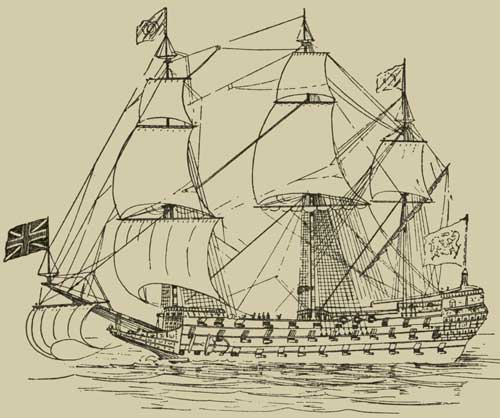
(From a painting by Vandervelt.)
The drawing (17) here shown of this ship is copied from a contemporary painting by Vandervelt. At the stern is the Royal Standard of Charles I.; on the two masts ensigns with royal ciphers; and the two-crossed "Union Flagge," which from 1634 was to be the "ornament proper for our owne shipps," is flying on[Pg 86] the "Jack staff" at the bow. It was the "King's Flag" calling for the obeisance of foreign vessels.
But another change was yet to come, and after fourteen more years had passed away another Jack was flying at the bow, and the Royal Standard of the King had disappeared from the stern of the gallant vessels. Premonitory symptoms of this impending change had been given even so early as January, 1645, when the headings of the official lists of the ships of the navy had been altered by order of Parliament, so that the ships were officially entered as "The Parliament's Ships," instead of being described, as previously, "His Majesty's Ships."[44]
In February, 1648, the Revolutionary Parliament of England abolished the office of King, and by this and the subsequent execution of King Charles they cancelled the allegiance of Scotland and dissolved the connection between the kingdoms. A change was made in the Jacks which were to be worn on the men-of-war. The Parliament did not consider the Stuart kingdom of Scotland to be a portion of their State, and ordered that its recognition should be removed from the flags then used on their ships. An order of the Council was therefore passed, February 23rd, 1648, signed by John Bradshaw, "in ye name of ye Counsell of State," which was communicated in a letter to the Commissioners of the Navy, directing the change and ordering that "the ships that are in the service of the State shall beare the Red Crosse only in a white flagg, quite through the flagg." Up to that time carvings of the royal arms had been car[Pg 87]ried on the stern of all royal ships, so the order further directed that these also should be altered, and that "upon the Sterne of the Shippes there shall be the Red Crosse in one Escotcheon and the Harpe in one other, being the Armes of England and Ireland, both Escotcheons joined according to the pattern herewith sent unto you."
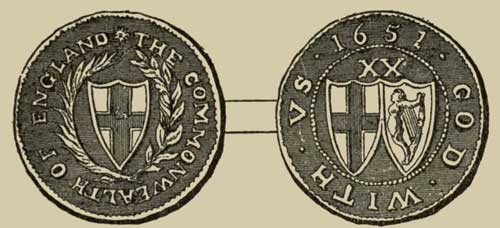
The form of these escutcheons is well shown in the twenty-shilling piece (18) issued during the Commonwealth, and also on a Parliamentary flag (19) then in use which had on the fly the same two emblems. One of these flags is still preserved in the house of the Admiralty Superintendent at Chatham, the colour of the ground of the flag being red.[45]
Thus the two-crossed Union Jack of James ceased to be used and disappeared from the navy, as it already had from the merchantmen, and the single red cross Jack of England was restored to its position as the only Jack carried on the men-of-war of the State, or on any English ship sailing the seas.
The merchant vessels of the two nationalities continued to use their English and Scottish national Jacks as before, but the Scottish ships were especially warned that they must not carry either the King's arms or the red cross of St. George, and in case any of these Scottish ships should be met so doing, the State's colonel-admirals were ordered to "admonish them not to do it in future."
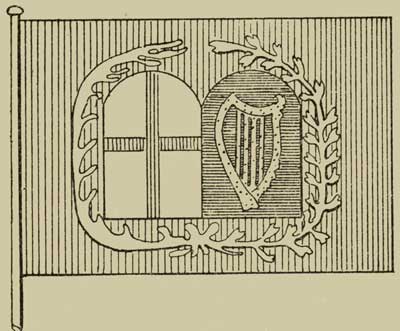
The position of the Jacks was now:
| A.D., 1648. | |
| The State Ships | The St. George crosse. |
| English Merchantmen | The St. George crosse. |
| Scotch Merchantmen | The St. Andrew crosse. |
This position the English St. George Jack continued to hold on the ships of the State navy until 1660, when another change took place, and, at the "Restoration" of Charles II., the two-crossed "Union Flagge" returned, without any proclamation, to the places where it had been displayed before the change made by the Commonwealth Parliament.
On the Naseby (20) it will be noticed that the two-crossed Jack is flying at the bow and on the[Pg 89] mizzen, instead of the single red cross flag ordered by Parliament. How this came about is told in the next chapter.
Here, then, ended the period during which the English Jack, having been restored as a single flag, had continued to be, from 1648 to 1660, the only Jack authorized to be used on the men-of-war.
After the return of the King his subjects evidently began, in their enthusiasm, to make such indiscriminate use of this "King's Jack" instead of the single St. George Jack that they needed, a few years afterwards, to be reminded of the special instructions respecting the flag which had been given in the previous reign. In consequence of this, in 1663, another proclamation was issued, under Charles II., from which the following extract is made:
"A proclamation for the regulating the colours to be worn on merchant ships.—Charles R.
"Whereas by ancient usage no merchants' ships ought to bear the Jack, which is for distinction appointed for His Majesty's ships:
"His Majesty strictly charges and commands all his subjects, that from henceforth they do not presume to wear His Majesty's Jack, commonly called the Union Jack, on any of their ships or vessels, without particular warrant for their so doing from His Majesty, or the Lord High Admiral of England. And His Majesty doth further command all his loving subjects without such[Pg 90] warrant they presume not to wear on board their ships or vessels any Jacks made in imitation of His Majesty's, or any other flags, Jacks or ensigns whatsoever, than those usually heretofore worn on merchants' ships, viz., the flag and Jack white, with a red cross, commonly called St. George's cross, passing quite through the same, and the Ensign red with the like cross in a canton white at the upper corner thereof next to the staff."
The distinctive order of the flags was this time arranged to be:
| A.D., 1663. | |
| The Royal Navy—"His Majesty's Jack," commonly called "The Union Jack." | |
| All Merchantmen— | |
| I. The "Jack White," or plain St. George Jack. | |
| II. The "Ensign Red," or red flag, with the "Jack White" in the upper corner. |
From the time of this proclamation of Charles II. the Jack of King James regained its officially authorized position, but only as a single flag, and even then was ordered to be used only on the royal men-of-war. The merchant ships, however, began again so frequently to fly this Jack instead of their single-cross Jacks, that in the reign of William III., and again in the reign of Queen Anne (prior to the creation of her own two-crossed Jack), it was found necessary to issue special proclamations reiterating the official restriction of this two-crossed Jack of James to the[Pg 91] ships of the Royal Navy, and forbidding any other ships to use it.
Although the merchantmen were not always using the single St. George Jack, which had been restored to them, and it had given way in the Royal Navy to the two-crossed Jack, yet it had always continued to be used in the Ensign Red referred to in the proclamation. The creation of this Ensign Flag, in 1648, is told in the next chapter, and in this form the restoration of the English Jack was extended for a further period to 1707, and reserved for a special further honour in later times.
In the British Navy of the present day the St. George Jack has become, and is ordered to be, the distinctive flag of an Admiral. According to the mast upon which it is raised his rank is indicated, and the ship on which it is carried is termed the "Flag Ship." These flags are displayed as follows:
| Admiral | St. George at main. |
| Vice-Admiral | St. George at fore. |
| Rear-Admiral | St. George at mizzen. |
Thus has the English Jack been once more restored, and being the signal of command in the British Navy, it is a continuing memorial of the prowess of the seamen of England, whose ships so early won the sea command for the united empire.
THE EVOLUTION OF THE RED ENSIGN.
The history of the Jacks as single flags having been traced through these periods, we may revert to the changes brought about by their being made part of a larger flag, and note how the exalted position at the stern of the ships was transferred to a new flag, a National Ensign, in the upper corner of which the English Jack was placed alone, when this flag was first created.
Under James I. and Charles I., as also under the previous sovereigns of England, the flag flown at the stern of the men-of-war had been the Royal Standard of the Sovereign, of which an example is given in the drawing of the Sovereign of the Seas (17).
The Royal Standard bearing upon it then, as it does now, the armorial bearings or "arms" of the Sovereign, was the banner of the King, and, as then placed at the stern of the ships, signified his direct management and control of the royal fleet.
Before the close of the reign of Charles I. the money control of the Royal Navy had been jealously assumed by Parliament, and the ships had been enrolled as "the Parliament ships." With the advent[Pg 93] of the Commonwealth the ships of the navy were no longer the ships of the King, but became the ships of the State.
PLATE IV
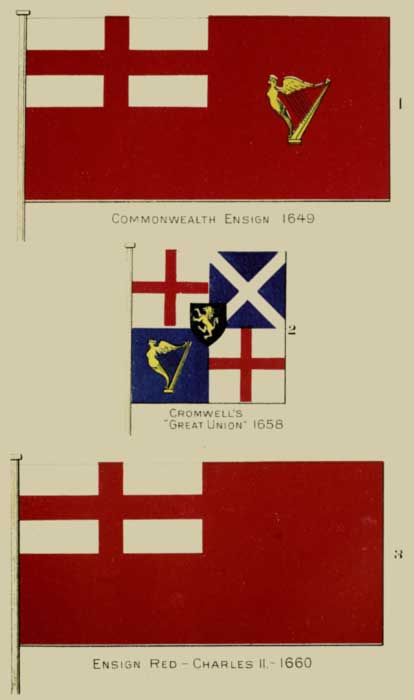
| 1 Commonwealth Ensign 1649 |
| 2 Cromwell's "Great Union" 1658 |
| 3 Ensign Red—Charles II.—1660 |
It was to take the place of the King's Standard at the stern that the Commonwealth Parliament created a flag, called the Commonwealth Ensign (Pl. IV., fig. 1), to be carried on their men-of-war. This was a red flag, having in the fly a yellow Irish harp, and in the upper corner next the staff the St. George cross upon a white ground. Ireland had early been overrun by the Commonwealth armies, so her emblem was included in the flag, but Scotland had warmly espoused the cause of the Stuarts, and was, therefore, not recognized.
Cromwell, after he had been raised to the position of Protector, and had dragooned Scotland into submission, put out, in 1658, another flag as the "Great Union," or banner of the Commonwealth (Pl. IV. , fig. 2), in which the crosses of St. George and St. Andrew were shown for England and Scotland, and the harp, on a blue ground, for Ireland; but they were each placed in separate quarters of the flag, instead of being joined together in one union, and on a black shield in the centre he caused to be displayed a lion rampant, as representing his own coat-of-arms and himself.
This "Great Union" of Cromwell does not appear to have entered into much use, although it certainly was displayed at his funeral.
The fleets of the navy were then flying ensigns of three different colours—red, blue and white—according to the rank of the admirals who were in command,[Pg 94] red being the colour of the admirals of highest rank and the typical colour of England.[46]
Contemporary paintings also show that red, blue and white ensigns were in use under the Commonwealth, with a single harp in the fly, and a Dutch medal, struck to commemorate the death of Admiral Tromp, also shows the same design of flag.
The "Commonwealth Ensign," now having the Irish harp inserted in the flag, was the official flag flown at the stern of the ships of the States Navy during the period of the Commonwealth.
The rule of the Commonwealth party having, shortly after the death of Cromwell, come to its sudden termination, the Royalist supporters of the absent King did not take time or wait for any formal proclamation authorizing a change in flags which had come into existence under the order of the Commonwealth Council.
Pepys tells in his "Diary" of how this change was begun. Being "Clerk of the Acts of the Navy," he had been deputed to read the proclamation of Parliament declaring the restoration of the King to the crews on board those ships of the Navy which had been appointed to cross over to The Hague and bring Charles II. to England.
Under the Commonwealth successful generals and officers on land had been appointed to commands as admirals and officers in the navy, and the military titles were still retained, the official title of the officers[Pg 95] in highest command in the navy of the Commonwealth being "Admirals and Generals at Sea."
While lying at anchor in the Downs, waiting for the high officials who were to accompany the fleet, Pepys records how the "General of the fleet" went from ship to ship in a small boat, telling them to "alter their Arms and flagges."
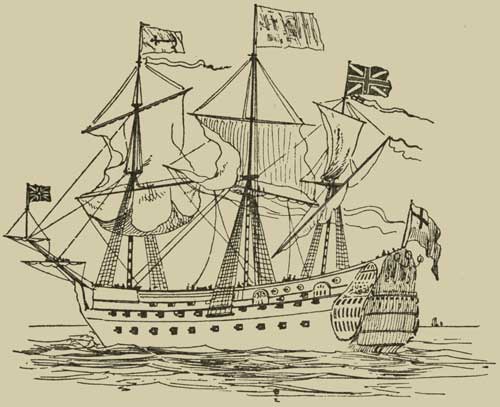
(From a painting by Vandervelt.)
On 13th May, 1660, being on board the London, one of the ships of this squadron, he makes the following entries of his day's doings, and tells of the making of these changes: "To their quarterdeck, at[Pg 96] which the taylers and painters were at work, cutting out some pieces of yellow cloth in the fashion of a crown and 'C.R.' to be put up instead of the State's arms." He also records that meetings of the officers were held, and that he had attended "in the afternoon a council of war only to acquaint them that the harp must be taken out of all their flags, it being very offensive to the King."
When, therefore, the harp had been removed from their flags, there remained the simple "Ensign Red," having the St. George cross in the upper white canton.
The Naseby (20)—afterwards re-named the Royal Charles—was one of the ships of the squadron which crossed to The Hague, and the actual ship on which Charles II. came over to England. The drawing shows the Ensign Red flying at the stern. There had not been sufficient opportunity for the obtaining of new flags, and, therefore, those which they had in use were altered on board the ships, as Pepys has told, and this flag is a Commonwealth "Ensign Red," with the Irish harp cut out (Pl. IV., fig. 3).
A very great deal of dependence cannot, as a rule, be placed on the form of the flags introduced into their pictures by artists even of the highest rank. When painting flags more attention is frequently given by them to the colour effect desired to be produced than to the accurate drawing of the details.
Some instances of unworthy errors in the drawing of national flags may be mentioned. In a painting by Leutze, now in the Metropolitan Museum of Art, New York, a representation is shown of "Washington crossing the Delaware, on December 25th, 1776."[Pg 97] In this a flag with the stars and stripes is prominently shown, although no such flag had any existence until a year and a half afterwards,[47] an error which has been perpetuated by a copy of this painting on a series of the national bank-notes issued by the United States Government. In the Capitol of the United States at Washington there is a picture of the "Battle of Lake Erie," fought in 1814, in which the flag on Commodore Perry's boat has only thirteen stars and thirteen stripes, although the United States ensign had been changed twenty years before, in 1794, to have fifteen stars and fifteen stripes. On the walls of the Commons Corridor in the British Houses of Parliament at Westminster is a fresco representing the landing of Charles II., in 1660, in which the Union Jack is depicted as having three crosses, the red cross of St. Patrick being included, although it was not entered in the flag until 1801, or 140 years afterwards.
In each of these instances the artist was painting from his imagination, but Vandervelt, who painted the picture from which our illustration of the Naseby is taken, was himself present on the occa[Pg 98]sion he recorded, and, seeing that he was the most celebrated marine artist of his day, the details of the flags can be taken to be correct.
The subsequent proclamation of Charles II., in 1663 (page 89), shows that this flag not only continued to be used on the royal ships, but that also all the merchant ships had adopted it and were flying the "Ensign Red" at the stern in the same way as on the Naseby, and thus it was that this flag, having become established by usage as the national ensign, was then confirmed in its position by the proclamation of the King.
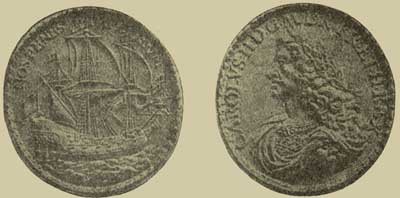
Further confirmation of its use is given by the medals issued in 1665 by Charles II., which he granted to his followers in recognition of service. One of these is given in fig. 21. On the reverse is a ship in full sail. On the flag at the mainmast head are the letters "C.R.," being the abbreviation of CAROLUS REX, and intended to indicate that the flag was the Royal Standard; at the bow the two-[Pg 99]crossed Jack, and at the stern the Red Ensign with the St. George Jack in the upper corner.
The place of distinction at the stern had been occupied, as under Charles I., by the Royal Standard of the reigning kings. To this position the Commonwealth ensign had been installed as being the ensign of the State, and then by the unpremeditated transition at the "Restoration" the Red Ensign succeeded to the post of honour as the ensign of the nation.
The story of this flag again exemplifies its harmony with the peculiar genius of the British constitution, for it attained to its position, not by a single verbal enactment, but by force of unwritten usage, and its gradual acceptance by the will of the people, after which it was confirmed by the Act of the sovereign.
It will also be noted in the drawing of the Naseby, and on the medal, that the Royal Standard of Charles II. is shown flying at the main. This was the position at which it had, under previous sovereigns, been displayed by the Lord High Admiral of the Navy to indicate his rank. The Earl of Warwick, who was Lord High Admiral under Charles I., continued to fly it at the main even after the death of the King; but when Warwick was dismissed from his post by the Commonwealth, the Royal Standard was no longer used as the distinction flag of the Royal High Admiral. When the Commonwealth ended and a new King returned, it was again raised to the place where it had been displayed by the last Royalist admiral.
At the present day the Royal Standard, being the personal flag of the Sovereign, is only shown to indicate the royal presence or that of some member of the[Pg 100] Royal Family, or raised in recognition of some special royal day. On shipboard it is raised on the mainmast immediately the royal personages come alongside, and is lowered the moment that they leave, the national ensign being still displayed at the stern.
It was the St. George cross which had been placed in the upper corner of the Commonwealth ensign; from here it had passed into the Ensign Red of Charles II., thereafter borne at the stern on both merchantmen and men-of-war. In the paramount ensign of the nation the single-cross English Jack was thus carried from 1648 to 1707, when its place in the national ensign was taken for the first time by a two-crossed Jack, and then only by the first real Union Jack, the Jack of Queen Anne.
In all the series of changes mentioned in this and the previous chapter direct evidence is given that the "commonly called Union Jack" of James was only an "additional" flag; that having been considered the "King's Jack," it had not officially displaced the local national Jacks, and that, although it had superseded them as a single flag on the Royal Navy, it had never been introduced into the paramount and national ensign of the nation.
Such, then, was the origin and evolution of the Ensign Red, the national ensign of the British people, and which formed, with the changes made in the Jack in the subsequent reigns of Queen Anne and George III., the basis of the present "Red Ensign" of the British Empire.
Our national ensign tells us how from its very origin it signified the progress of constitutional rule.[Pg 101] The Royal Standard of Charles I. at the stern was the expression of absolute rule by the King without the control of Parliament; the Commonwealth Ensign told of the absolute rule of Parliament without the King; the Ensign Red at the stern recorded the coming of constitutional government by both King and Parliament; and so our Red Ensign still tells the story of British constitutional rule by sovereign and people, represented in their united power by this Union Ensign flying at the stern of all British ships and over all the British lands which bear it united allegiance.
THE SOVEREIGNTY OF THE SEAS.
THE FIGHT FOR THE FLAG.
At the close of the first historic period of the St. George Jack we saw it reigning supreme upon the seas around the shores of England. The great Armada had, in 1588, been met and shattered, and its squadrons so relentlessly pursued around the British Isles that but a remnant remained to struggle back to Spain and tell the story of their defeat.
After such a victory as this the red cross flag of the "Navie Royall" sailed the Narrow Seas with more assurance than ever, claiming and receiving the obeisance of all vessels that were passing by. The ancient policy of Alfred and of John had been as much esteemed during this Elizabethan period, and its principles adhered to as earnestly and for the same reason as in the earliest days; but the increase of merchant shipping and the rise of the business fleets of England now gave a new reason for its being maintained beyond the old one of self-defence. With the advent of long-distance voyages riches were now to be found beyond the confines of the Narrow Seas. Sir Walter Raleigh stated the new reason with a terseness which four centuries of phrase-making has[Pg 103] not since excelled. Said he: "Whosoever commands the sea commands the trade; whosoever commands the trade of the world commands the riches of the world, and consequently the world itself."
The sovereignty of the seas had in this way developed a trade value; yet, whatever may have been the real and underlying causes, the contests for the supremacy which for the next hundred years kept simmering between the nations, bursting out at times into blasts of open war, arose ostensibly from disputes between the guardians of the rival fleets regarding the honourable precedence to be accorded to their respective flags.
The sea-rovers of Elizabeth had developed into something very like "gentleman-buccaneers." They ranged the oceans, preying upon the Spanish and Portuguese ships wherever they were to be found, and returned in joyousness, bringing home their booty. The maritime eagerness of the people was whetted by these prizes, and it is said that even the Queen herself was not averse to accepting from her good subjects, Drake and Hawkins, a share of the proceeds of their prowess. The reign of the Jack of James I. had scarce begun when a neighbouring maritime rival arose to assume formidable proportions. Nurtured in the hardy school of their fishing fleets, and practised in distant voyages by traffic with their possessions in the East Indies, the Dutch merchantmen not only copied the English methods of preying abroad on the ships of other nations, but also began to employ themselves actively in carrying the water-borne business of their own merchants, and next,[Pg 104] which was an intrusion much more objectionable, to enter into competition with the English ships in carrying the merchandise for the other nations of Europe. Thus the passage of the Dutch fleets along the coasts of Europe greatly increased. As soon as the Spanish war was over, Sir William Monson, the Admiral of the Narrow Seas, demanded that the ships of all other nations should, as of old, lower their flags in the presence of his own, "a courtesy which could not," he announced, "be challenged by right, but now that the war was ended, His Majesty James I. demanded the full recognition of such rights and duties as belonged to his predecessors."[48]
These old rights the Admiral and his officers accordingly proceeded to enforce.
The spirit of the British sailors under the King's new two-crossed Jack was still the same as under the English Jack, and one is reminded of the old pride in the flag by an instance which is narrated as having occurred under James I. One of the ministers of Henry IV. of France had embarked at Calais to cross to England in a French ship wearing the French flag at the main. The commander of the English despatch boat, which had been sent to escort him, on meeting him in the channel, ordered the French ship to lower her flag. "The Duke of Sully, considering that his quality freed him from such an affront, boldly refused, but this refusal was followed by his receiving three cannon shots which pierced his ships. Might forced him to yield what right forbade, and for all the complaints he made he could get no better reply[Pg 105] from the English captain than this: 'That just as his duty obliged him to honour the ambassador's rank, so it also obliged him to exact the honour due to the flag of his master as Sovereign of the Seas.'"[49]
The "rufflings" increased in frequency, and the contest went merrily on, as the Dutch, increasing in enterprise and volume of shipping, chafed still more under the domination of the English admirals. In this restlessness they were encouraged by the differences which were raging between King Charles I. and his Parliament. The latter thwarted the King's efforts at sea and refused to contribute to the levy of "ship-money," declaring it to be an "insufferable tax"; while he, without their concurrence, was attempting to strengthen the navy, which he had created to assert the King of England's right to the sovereignty of the seas and for the protection of his shores, by the maintenance of the old Alfred policy. The King's sailors felt keenly the increasing insolence of the passing Dutch ships, as wrote one old salt:
"What affront can be greater, or what can make a man valianter, than a dishonour done to prince and country, especially by a people that was wont to know no more than how to catch, pickle, and feed fish."[50]
Notwithstanding the Parliament's objections, an English navy was at one time collected of sufficient strength that, when the Dutch and French fleets joined together in 1635 with the avowed intention of contesting the command of the sea, its simply sailing[Pg 106] out to meet them overawed their forces, as reports Monson:
"It is to be observed that the greatest threateners are the least fighters; and so it fared with them; for they no sooner heard of our readiness to find them, but they plucked in their horns and quitted our coast, never more repairing to it."
The King's opponents averred that the quarrels with the Dutch over the honour due to the flag were fomented only for the purpose of forming an excuse for extorting more money by the objectionable ship-money, whose proceeds, they alleged, were expended for very different purposes than the maintenance of the navy. So the people resisted, while the King persisted. Later on, during the Civil War, English ships, manned by Royalist supporters of the King, were engaged in fighting against English ships manned by supporters of the Parliament, and each party was preying upon the merchant adherents of the other. Meantime, the Dutch maritime power continued to grow. The struggle between the Parliament and the King resulted in the defeat and execution of Charles, and the weakening of the fleet by these dissensions brought on the humiliation of the English flag during the first Dutch war.
Under Cromwell, in 1648, the St. George cross had been restored.
The Council of State took heart, and showed by their actions that once more the homage due the national flag was held by them in as great esteem as[Pg 107] it had been by the King and his party in the royal days. The orders to their naval commanders were explicit:
"And, whereas, the dominion of these seas has, time out of mind, undoubtedly belonged to this nation, and the ships of all other nations, in acknowledgment of that dominion, have used to take down their flags upon sight of the Admiral of England, and not to bear it in his presence, you are, as much as in you lies, to endeavour to preserve the dominion of the sea, and to cause the ships of all other nations to strike their flags and not to bear them up in your presence, and to compel such as are refractory therein by seizing their ships and sending them to be punished, according to the Laws of the Sea, unless they yield obedience and make such repair as you approve."[51]
The Commonwealth of England, in self-defence of their shipping, and as a direct blow against the Dutch, enacted the celebrated Navigation Act of 1651, directing that all goods imported into the Kingdom of Britain, or into her colonies, must be carried either in English ships or in those of the country whence the cargo was obtained.
The Dutch and English navies sailed the seas watching the movements of each other's flags, and minding the welfare of their merchant marine. Bickerings were frequent, but in May, 1652, off[Pg 108] Dover, Tromp brought the right to salute to a crisis. The nations were then at peace, when the Dutch fleet bore down in strength upon the English without lowering their colours. As soon as Tromp was within musket-shot the English Admiral gave orders to fire at his flag. At the third shot Tromp answered by a broadside. In such way, through an episode regarding a flag, the first Dutch War began.[52] Although the Parliament had become alive to the value of a navy, yet the unpreparedness of the previous years now told its tale, for when the season of 1652 had closed, the Dutch had swept the English flag from the Narrow Seas, and Tromp is traditionally reported to have triumphantly carried a broom at his masthead as a sign of his complete success.

Tromp's glory was of but short duration, for the Roundhead dragoon, Blake, nicknamed "The cavalryman at sea," soon clipped his wings. In return for the compliment of the previous year, Blake, after his victory, ran up a pennant on his mast, long and narrow like a whiplash, to show that he had in his turn driven the Dutchman off the seas; and the whiplash masthead pennants, with the St. George cross in the white ground at the head (22), borne on all His[Pg 109] Majesty's ships in commission, serve as reminders of the story of this exploit to the present day.[53]
Peace followed in 1654. In this treaty of peace the Dutch agreed that:
"The ships of the Dutch—as well in ships of war as others—meeting any of the ships of war of the English Commonwealth in the British Seas, shall strike their flags and lower their topsail in such manner as hath ever been at any time heretofore practised under any form of government."
Thus had the old sea supremacy of the nation of England, claimed by King John, been again acknowledged; but on this occasion it was for the first time accorded to England by the terms of a formal treaty.
It was the red cross Jack of St. George, introduced by Richard I., and raised as his "Royal Flag" by King John, which had in previous times received the honour of the "Sovereign Lordship of the seas." We have seen how for a while its place had been shared by the additional two-crossed Jack of James: but now, by the incident of the temporary dissolution with Scotland under the Commonwealth, the English Jack was once more reigning in sole possession of the flag-staff, to receive by the terms of this treaty the renewal of that proud homage which its single red cross had received four centuries before. It was a[Pg 110] happy coincidence which the flag of the seafaring Englishman most fully deserved.
Afterwards when the Jack of Queen Anne had taken its place in the Union Ensign, the same claim of supremacy was upheld. Under George III. the instructions issued to the British navy for salutes to be given and received stated:
"When any of His Majesty's ships shall meet with any ship belonging to any Foreign Prince or State within His Majesty's seas (which extend to Cape Finisterre), it is expected that the said Foreign ships do strike their topsail, and take in their flag in acknowledgment of His Majesty's Sovereignty in those seas."[54]
This sovereignty so valiantly for so many centuries maintained was again gloriously achieved when Nelson at Trafalgar swept the combined forces of the French and Spanish navies from the seas, and made his nation the dominant power on the oceans—a dominance since maintained, not by conflict in attack, but by power and preparation for defence, in which the parent kingdom is now being joined by the daughter dominions in the outer Empire for maintaining inviolate the supremacy of the seas.
THE SOVEREIGNTY OF THE SEAS.
THE FIGHT FOR THE TRADE.
Notwithstanding the check which they had received in their career, the marine power—both naval and merchant—of the Dutch kept on increasing. The hostilities against Spain, conducted under Cromwell, had transferred the Spanish carrying trade to the Dutch from the English ships, which had previously enjoyed it. The Dutch had also challenged the English merchantman in his own carrying trade, as well as becoming general carriers for all Europe; so much so that they were termed "The wagoners of all the seas."
It was the contest for the money value of the "command" of the seas which was really being waged, and the commerce of distant continents was the prize which would fall to the victor's share. Vessels of the Dutch and other nations were ordered to heave to, or were stopped by a shot across their bows, not only to compel observance of the supremacy of the flag, but also for opportunity to search their holds for the goods which the searchers might consider should have been carried in English ships.
The Dutch had agreed to acknowledge the English flag in the British seas, but the English claimed it should be saluted on all. In 1663, De Ruyter and Admiral Lawson had almost come to cannon shots in the Mediterranean over salutes claimed for the flag, and recriminations and searchings had extended to the waters of the far East Indies, where the Dutch, who had taken the Cape of Good Hope from the Portuguese, were competing with the English ships for the merchant trade.
Soon, under Charles II., another Dutch war (1665-67) blazed out, during which De Ruyter sailed up the Thames to Gravesend and destroyed the ships at Chatham and in the Medway, and London was for the first time startled by the sound of an enemy's guns. Again the success was but temporary, for at the close of the war New Amsterdam in America, and with it the command of the Hudson River, was ceded to the English. The name of the new territory then obtained was changed to New York, in honour of the Duke of York, the King's brother, which English and royal name it still retains, although now forming the principal maritime city of the Republic of the United States. With the booty came, in the articles of peace, the old-time ascription of sovereignty to the British flag. It was again agreed by one of the articles of the treaty:
"That the ships and vessels of the so United Provinces, as well men-of-war as others, meeting any man-of-war of the said King of Great Britain in the British seas, shall strike their flag and lore the topsail in[Pg 113] such manner as the same hath been formerly observed in any times whatsoever."[55]
But the rivalry was too intense to continue much longer without coming to a definite climax. The "command" foreseen by Raleigh was at stake. Both nations had the maritime instinct, and both the genius of colonizing power, so that one or the other of them must give place and leave to the survivor the supreme possession of all that this command implied.
Formal negotiations between the governments had been rife, but the vital test was the supremacy due to the flag. An English royal yacht was ordered to sail through the Dutch men-of-war in the channel and to fire on them if they did not strike their flags. An ultimatum was sent summoning Holland to acknowledge the right of the English crown to the sovereignty of the British seas and to order its fleets to lower their flags to the smallest English man-of-war.[56]
Thus the third and final war came on in 1672 and continued until 1674.
The plain red fighting flag of the English navy of the day was flying at the fore on the men-of-war as the signal to "engage the enemy," and the ensign red was at the stern of both men-of-war and merchantmen as the national ensign. War immediately commenced, and while the Royal Navy was battling with its guns, the merchant navy of England was cutting into the carrying trade of the Dutch, so much so that at its close the British merchant ships had captured[Pg 114] the greater part of the foreign business of the enemy, and by thus exhausting their earnings, and reducing the fighting resources of the Dutch, contributed to the final victory almost equally with the exploits of the men-of-war.
The contest, though short, was very sharp. The strife had been for the merchant carrying trade of the world, and when it was won, whole colonies were transferred with it to the victorious English.
During the interval which had followed since the previous war the English had returned to the Dutch their newly-acquired possession of New York in exchange for the Dutch possessions in Guiana, the boundaries of whose territories then transferred formed the subject of the Venezuela excitement of 1896; but now they took both these countries back, while the Island of St. Helena, which, in the beginning of the war had been captured by the Dutch by an expedition sent from their colony at the Cape of Good Hope, was again recovered to the British flag. These possessions formed only a portion of the victor's spoil. Above all of these and other great money results, the old sea spirit again asserted itself, and setting into inferior position the additions to the realm, or the compensations exacted for the expenses of the war, the final treaty declares among its first clauses the lordly renewal of the centuries-old right of the respect and salute due to the nation's flag:
"In due acknowledgment on their part of the King of Great Britain's right to have his flag respected in the seas hereafter mentioned, shall and do declare and agree, that[Pg 115] whatever ship or vessels belonging to the said United Provinces, whether vessels of war or others, or whether single or in fleets, shall meet in any of the seas from Cape Finisterre to the middle point of the land Van Staten, in Norway, with any ships or vessels belonging to His Majesty of Great Britain, whether these ships be single or in great number, if they carry His Majesty's of Great Britain flag or Jack, the aforesaid Dutch vessels or ships shall strike their flag and lower their topsail in the same manner and with as much respect as hath at any time, or in any place, been formerly practised towards any ships of His Majesty of Great Britain or his predecessors, by any ships of the States General or their predecessors."[57]
The "Jack" of His Majesty Charles II., which was the sign of His Majesty's ships, was the two-crossed "additional" Jack of his father, which had been restored to the navy at the Restoration, and as shown on the Naseby (20).
This Jack was flying at the bow and on the mizzen of the ships of war, and at the stern was the sign of nationality, the "ensign red" with the St. George cross.
The ensign red which the ships of that royal navy bore when they thus won the final supremacy of the sea from the navy of Holland, was the flag worn also by the British merchantmen of the time, and on them[Pg 116] witnessed the obtaining of that other command, then won from the Dutch, "the command of the trade, which is the command of the riches of the world." To this victory the merchant mariner, by his seamanship and energy, had done his full share, and had won his right to wear it as his own. Worthily, therefore, at this present day do the merchant ships of Britain wear the red ensign on every sea, in every clime, in rightful acknowledgment of the part their predecessors played in the gaining of the supremacy of the sea.
This supremacy, and still more the spirit of sea supremacy, has ever remained dominant in the souls of British seamen.
When in March, 1889, the harbour of Apia, in Samoa, was devastated by a terrific cyclone, and all the ships of other nations dragged their anchors and were driven ashore, it was with this native spirit that the British sailors slipped their cables and set out for their ocean home on the open sea. As the British man-of-war breasted the hurricane and battled through the breakers at the harbour mouth, the American sailors on their flagship Rodney, sinking with fires extinguished[58] inside the bar, cheered her as she passed, a cheer which rang round the world, and the bold Calliope, with her British ensign above her, and her "hearts of oak" within, won her way to safety far out in the wildest storm.
With such widespread venture in her people, such spirit in her ships and record in her flag, no wonder[Pg 117] is it that the British Navy and the British merchant marine exceed in number and in power those of any other nation on the globe. Well, therefore, with lusty throats and cheerful hearts, Britannia's children sing:
THE UNION JACK OF QUEEN ANNE, 1707.
THE SECOND UNION JACK.
The story of the flag now brings us to the creation of the second two-crossed Jack, being the first real "Union Jack" (23).
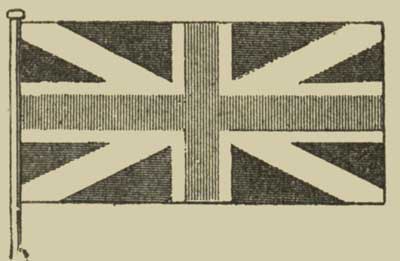
In the year 1707, being the sixth year of the reign of Queen Anne, the Parliaments of England and Scotland were at length brought into Union in one Parliament. Up to this time there had not been one distinctive "Union Jack" to represent both the kingdoms—no one flag taking the place of the separate national Jacks of St. George and St. Andrew, which the English and Scotch subjects of the Sovereign had each been instructed and continued to use, according to their nationality.
In Acts of Parliament which had been passed in the Parliaments of England and Scotland, prior to their ceasing to act and becoming merged in the one[Pg 119] "Union Parliament of Great Britain," authority had been given to the Queen to create a flag, in which the two national flags, the "Crosse of St. George" and the "Crosse of St. Andrew," should be joined together to form a Union Flag.
PLATE V
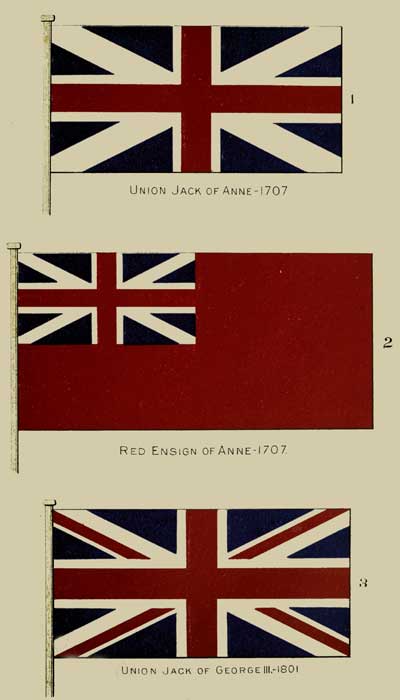
| 1 Union Jack of Anne—1707 |
| 2 Red Ensign of Anne—1707. |
| 3 Union Jack of George III.—1801 |
The Queen accordingly called her councillors together, and a Committee of the Lords of the Privy Council was appointed "to consider of several matters in Execution of the Act lately pass'd for the uniting of the two Kingdoms of England and Scotland."
Instructions were given by this Committee to the Right Honourable the Earl of Bindon, Deputy Earl Marshal of England,
"to give Direction to the Kings of Arms and ye Heralds to consider of the Alterations to be made in the Ensigns Armorial and the Conjoyning the Crosses of St. George and St. Andrew to be used in all Flags, Banners, Standards and Ensigns at Sea and Land, and that they lay before the Committee Drafts of the present Flags of England and of Scotland, and of such alterations as they propose for the Flags of the United Kingdom."[59]
These directions were carried out and various designs prepared by the Heralds and the Committee were thereafter presented for final adjudication and authority at a meeting of the Privy Council, as recorded in the Minutes:
"At the Court at Kensington, the 17 day of April, 1707.
"Present:
"The Queen's Most Excellent Majesty in Council:
"Whereas upon a Report from the Lords of Her Majesty's most Honourable Privy Council appointed to consider of divers matters in execution of the late Act for Uniting the Two Kingdoms, who were attended by the Kings of Arms and Heralds with divers Drafts proposed by them relating to the Ensigns Armorial for the United Kingdom and for adjoining the Crosses of St. George and St. Andrew pursuant to the said Act, Her Majesty is pleased to approve of the following particulars, viz.:
"That the Draft marked A be made use of for the manner of bearing Arms for the said United Kingdom.
* * * * * * * *
"That the Flaggs be according to the Draft marked C, wherein the Crosses of St. George and St. Andrew are Conjoyned."[60]
Copies of the minute and of the drafts were transmitted under seal to the College of Arms, London. A careful copy of the drawing of Draft C, as attested by a certificate of the York Herald, is given (fig. 24).
Formal and important promulgation of the Orders[Pg 121] and Flags was ordered by another paragraph of this same minute of April:
"And Her Majesty is pleased to Order, That these Minutes be put into the Hands of Her Majesty's Principal Secretarys of State, who are to Receive Her Majesty's Pleasure thereupon, And to signify the same within the United Kingdom of great Britain and in Ireland, Her Majesty's Plantations in America, the Islands of Jersey and Guernsey and all other Her Majesty's Dominions."[61]
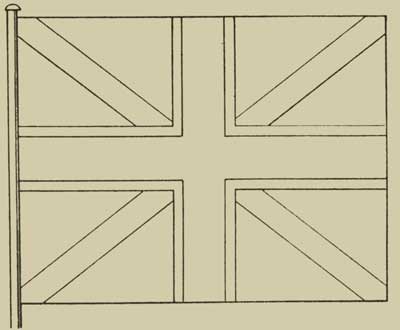
This Draft C, so prepared by the Committee and Heralds, and selected and approved by Her Majesty the Queen and Her Privy Council, was duly transmitted to be the form of the new "Flagg," which was to be used on all "Flags and Ensigns at sea and on[Pg 122] land," and not only by Her Majesty's subjects in the Home Kingdoms, but in all the Islands and Dominions beyond the seas.
Thus was formed the "Union Jack" of Queen Anne, which, taking the place of the Jack of James I., "commonly called the Union Jack," was the second two-crossed Jack, and the first fully authorized "Union Jack."
In the July following, the Queen issued a proclamation regarding "Our Jack" and the "Ensign" of the now completely United Kingdom, and defining more particularly how these flags were to be used at sea:
Royal Arms.
Three lions for England, red lion for Scotland, harp for Ireland, three fleurs-de-lis for France, and the motto, "Semper Eadem."
"BY THE QUEEN.
"A Proclamation—Declaring what ensign or colours shall be worn at sea in merchant ships or vessels belonging to any of Her Majesty's subjects of Great Britain and the Dominions thereunto belonging.—Anne R.
"Whereas, by the first article of the Treaty of Union, as the same hath been ratified and approved by several Acts of Parliament, the one made in our Parliament of England, and the other in our Parliament of Scotland, it was provided and agreed that the ensigns armorial of our Kingdom of[Pg 123] Great Britain be such as we should appoint, and the crosses of Saint George and Saint Andrew conjoyned in such manners as we should think fit, and used in all flags, banners, standards and ensigns both at sea and land; we have, therefore, thought fit, by and with the advice of our Privy Council, to order and appoint the ensign described on the side or margent hereof, to be worn on board all ships or vessels belonging to any of our subjects whatsoever; and to issue this, our Royal Proclamation, to notifie the same to all our loving subjects, hereby strictly charging and commanding the masters of all merchant ships and vessels belonging to our subjects, whether employed in our service or otherwise, and all other persons whom it may concern, to wear the said ensign on board the ships or vessels."
After creating the Ensign, which was to be used by all ships, warning was given, so that Her Majesty's ships might be the more easily distinguished, against the using of the single Jack, or of any of the distinctive flags of the Royal Navy, without permission.
"And whereas, divers of our subjects have presumed on board their ships to wear our flag, Jacks and pendants, which, according to ancient usage, have been appointed as a distinction for our ships, and have worn flags, Jacks and pendants in shape and mixture of colours so little different from ours as not without difficulty to be dis[Pg 124]tinguished therefrom. We do, therefore, with the advice of our Privy Council, hereby strictly charge and command all our subjects whatsoever, that they do not presume to wear in any of their ships Our Jack, commonly called the 'Union Jack,' nor any pendants, nor any such colours as are usually worn by our ships without particular warrant for their so doing from us."
The proclamation then stated that no other ensign was to be used, and that it was to take the place of the ensign red up to that time used by merchant ships:
"And to hereby further command all our loving subjects that without such warrant as aforesaid they presume not to wear on board their ships any other ensign than the ensign described on the side or Margent hereof, which shall be worn instead of the ensign before this time usually worn on merchant ships.
"Given at our Court at Windsor, the 28th day of July, in the sixth year of our reign.
"God Save the Queen."
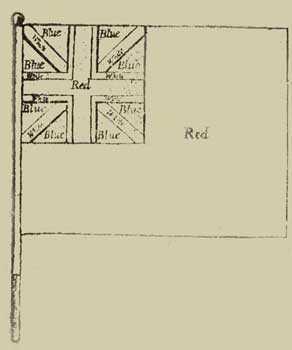
Here, then, we have the establishment of a new flag in accordance with the intention of the Treaty of Union. In this flag the "crosses" of St. George and St. Andrew were conjoined; the new flag was called "Our Jack" (Pl. V., fig. 1), which in its simple form, as a single Jack, was not to be used afloat on[Pg 125] any other ships than Her Majesty's Royal Navy without particular warrant. A notable change was now made in the Ensign. We have seen how, in 1660, the English St. George cross had remained alone in[Pg 126] possession of the upper corner of the "ensign red." Although the St. George cross continued, as it still does, in the "command pennant" of all officers of the Royal Navy, its place in the Ensign was now taken by the new "Union Jack," in the form as shown "in the margent" (25).
The "Red Ensign," thus formed, was authorized to be worn thereafter on all ships, both merchantmen and those in Her Majesty's service; and, further, that no other Ensign was to be worn except this "Red Ensign," with the new Union Jack in the upper corner, which was to take the place of the separate national Jacks and of the "Ensign Red" previously used on the merchant ships of the subjects of the Sovereign.
Here, then, ceased the official authority on ships as national flags of the separate crosse-flags of St. George and St. Andrew, and began the reign of the first "Union Jack" of the United Kingdoms. Then, too, was first raised the British Union Ensign, the "meteor flag" of the realm, to be worn by all subjects of Britain's Queen, whether on land or on sea, at home or abroad, on merchant ships or on men-of-war, so that wherever the blood-red flag should fly the world would know the nation to which its bearers belonged. In this red ensign (Pl. V., fig. 2), the paramount flag of the nation, the new "Union Jack" was placed; a position which, although so long enjoyed by the "English Jack," had never been occupied by the "additional" Jack of James I., whose term was now brought to a close.
The proclamation and drawing of the ensign, as[Pg 127] shown (25), are taken by photo reproduction from the upper corner of an original in the British Museum, London, and verified with the copy of the flag in the College of Arms.
A very noticeable difference will be seen to exist between "our" new Jack of Queen Anne, of 1707, and the "additional" Jack of James, of 1606, as usually given.
The white border surrounding the St. George cross has been enlarged, and is no longer a mere margin or "fimbriation," but has become a broad white border, distinctive in size and appearance.
In the King James I. flag the crosses were "joyned according to the forme made by our heralds";[62] in the Queen Anne flag they are to be "conjoyned in such manners as we should think fit",[63] in accordance with the request of the Parliaments of the two kingdoms. This time the designers of the "drafts," to whom the two then "present flags of England and of Scotland"[64] had been committed, were not thinking so much of heraldry as of making, as they were instructed, a union flag, and, while combining the two crosses, of making the two flags into one.
We have seen with what carefulness the combined Committee of the Privy Council and of the Heralds had proceeded, and when the new flagmakers thus broadened the white, they did it, it has been considered, for the purpose of representing in the Union flag a part of the white ground of the St. George Jack, which had previously been entirely effaced, but[Pg 128] which by the broad white border was now given its place in the new "Union," as well as, and in company with, that of the blue ground of the St. Andrew flag.
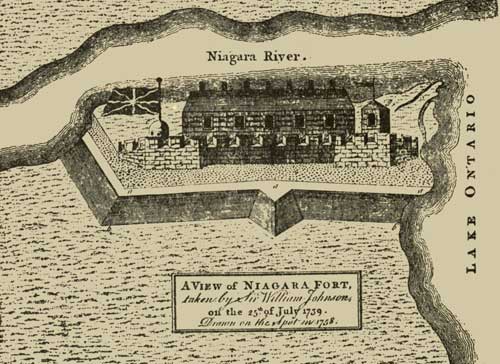
(Reproduced from an old print.)
A confirmation of this intention will be found in the annals of the next change in the Union Jack, which was made almost a century later. It is possible, too, that the views of the designers were affected by the relative proportions of some of the King James Jacks, which were in official use and will be referred to later.
It may have been that some of the Queen's advisers[Pg 129] and designers were sailors, who had carried the red cross of St. George, and now that it was being withdrawn from the Ensign of the nation in favour of the newcomer, felt, like the admiral of old, that it was but due to its centuries of glorious service that evidence of the whole English Jack—its white ground as well as its red cross—should be displayed in the new national emblem.
There the broad white band appeared in this two-crossed Jack, and has ever since remained, showing the red cross and white ground of St. George's Jack, combined, with the white cross and blue ground of St. Andrew's Jack, into one "Union Jack," which was hereafter to be the "sole ensign" of British rule.
It was this two-crossed Union Jack of Queen Anne which was raised at Plassey, when Clive won India, and at Pondicherry and at Seringapatam. Nova Scotia and Newfoundland were early (1713) transferred to it from the fleur-de-lis, and Sir William Johnson raised it in Canada above the old Fort Niagara, on the shores of Lake Ontario[65] (26), when
Under it Wolfe stormed Louisbourg, the key[Pg 130][Pg 131] fortress of Cape Breton, and, following up his victory, climbed the Heights, and died victorious on the Plains of Abraham (27), when, in 1759, Quebec was gained and all Canada came under the realm of British law.
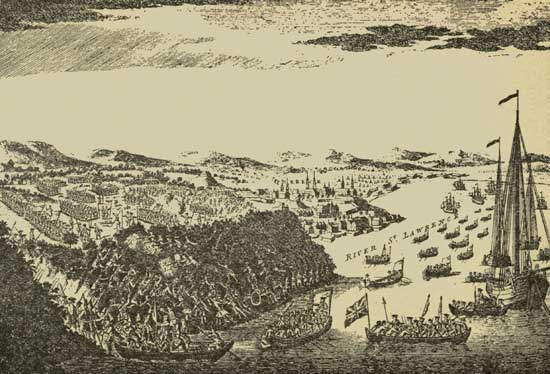
(From an old print published in London, 1760.)
The youthful Nelson saw it fly aloft when he served as captain's coxswain on a British man-of-war searching for the North Pole, and twenty-five years later when in glorious action he won his title as Baron Nelson of the Nile.
The Cape Colony was first acquired, and the West Coast of Africa, New South Wales and Vancouver Island were all added under its display, showing how the mariners of Britain were carrying it far across the distant seas, more distant then than now, for those sea-dogs of the "sceptred isles," boldly raising their new Union Jack upon the mast, braved the unknown oceans, and sailed their ships wherever billows rolled or winds could waft them.
So it came that, as its "glory roll" so vividly tells, it was under this second Union Jack the colonial possessions which dot the world around were either occupied by doughty Britons or were wrested from the flags of other nations to form the foundation of that Greater Britain which, from these beginnings, has since grown up in all the regions beyond the seas.
THE TWO-CROSSED JACK IN CANADA.
Although the Union Jack has been built up on the local Jacks of the three island kingdoms, its greatest glories have been won in expeditions sent far across the seas to other lands. The people of the parent isles have never needed to raise it as their signal in driving invaders from their own shores, and in this way it does not bear that added vitality to them which it bears to the resident Canadian, that of being associated with brave defence of home and native land. To the Englishman, Irishman or Scotsman, in his own island home, it is an emblem of foreign conquest; to the immigrant and to the Canadian-born it is much more, as being the patriot signal of his national defence.
After the events of 1759 and of 1760, when Levis at St. Foy nearly won back Quebec, and the cession of the rule of France in Canada had been agreed upon, Canada had settled down into the paths of peace; soldier and habitant vied in binding up one another's wounds, and evidencing all the pleasantries of reconciliation.[67]
A memorial, the like of which has never been known elsewhere, either in history or the world, has been erected in the square of "The Governor's Garden," at Quebec, to the two heroes, Montcalm and Wolfe, equal in valour, equal in fame. A united sentiment raised this single monument to their united memory, bearing upon it the noble inscription:
MORTEM, VIRTUS, COMMUNEMFAMAM, HISTORIAMONUMENTUM, POSTERITAS DEDIT.
"Valour gave them a common death, history a common fame, posterity a common monument."
As the glory of their champions was thus intertwined, so the patriotism of the old French occupants and of the newcomers to Canada began from this splendid example to blend more closely in fraternal union.
The Treaty of Paris, in 1763, confirmed the Union Jack in its position of being the successor to the fleur-de-lis of France and the three castles of Castile of Spain over all the territory on the continent of America, stretching from Labrador along the Atlantic coast southward to Florida, and inland westward as far as the waters of the Mississippi from their highest[Pg 134] sources to its mouth on the shores of the Gulf of Mexico.[68]
In pursuance of this treaty, King George III. issued his proclamation (October, 1763) creating four provinces and governments, named Quebec, East Florida, West Florida, and Granada, this last consisting of the islands of the West Indies. Of these four the Province of Quebec comprised the territory lying adjacent to the St. Lawrence River system, along its whole length to the head waters on the watersheds of the farthest inland lakes.
By this proclamation French Canada ceased to be a conquered country, and became a fully established colony of the British King. It was to be governed by a governor and an assembly, entitled to arrange its own taxation, have control of its own internal welfare and local government, and empowered to institute its own courts of law; but to every subject, new or old, of the King, there was reserved the right of appeal to the foot of the throne itself in the Privy Council of Great Britain, should any person think himself aggrieved by the decision of his own locally appointed courts.[69]
The French Canadian subject soon began to find for himself the beneficent character of British rule. He was no longer harried by an irresponsible governor nor a grasping "intendant" for the enrichment of a far-distant court, but was assisted in every way in the local development of his country. His personal property was assured, and he soon became sensible of the certainty of English law.
An Act of Parliament followed, formally and still further guaranteeing to the French-speaking subjects the quiet continuance of their most cherished customs.[70]
The Quebec Act of 1774 confirmed the habitant in the free exercise of his Roman Catholic religion, and restored to him his old French civil law (Code Civile), but provided that in all criminal matters the law of England, which had been found so satisfactory, was to remain in force.
Content with his lot, secure in his home, and sure that good faith would ever be kept with him and his descendants, the French Canadian proved loyal to the trust which was now confided to him.
After having been for sixteen years an English colony, Canada was invaded in 1775 by the forces of the thirteen older English colonies to the south, which, after a series of altercations and misunderstandings, due largely to their refusal in the past days to contribute toward the expense of the military forces which had been maintained on their frontiers "at England's cost to defend her American children[Pg 136] against the French and their Indian allies",[71] had consorted together in revolution against their parent State. After entering Montreal, which had been abandoned to them, the Revolutionary forces concentrated around the walls of Quebec for an assault upon the citadel. Below were the rebels against the British crown; above, upon the King's bastion on Cape Diamond, flew the two-crossed Union Jack, and within the fortress, under Sir Guy Carleton, the friend and fellow-soldier of Wolfe, was a garrison of 1,800 men, one-third of whom were French Canadian militia, headed by Colonel Lecompte Dupré. The invaders from New York were, however, reckoning without their host. They had expected to find the French Canadians dissatisfied with their lot; but, instead, they found them standing side by side with their British friends, and joining with them in common defence of their native Canadian land.
The assault commenced on the night of December 31st, 1775. At the point of attack at Près-de-Ville, in lower town, the guard was under the command of Captain Chabot and Lieutenant Picard, of the French Canadian militia, and the guns were served by sailors from the British ships, with Sergeant Hugh McQuarters, of the Royal Artillery, in charge. The attack was boldly met. General Montgomery, the leader of the United States forces, was killed; General Arnold, his second in command, wounded, and the whole invading force was put to rout.
Thus were the historic heights and ramparts of old Quebec again crowned with a British victory, but[Pg 137] this time with one in which the French Canadians were themselves the brave defenders of the Union Jack.
No wonder the French-speaking Canadian looks upon his British flag with pride, and, as one of his compatriots, Sir Adolphe Chapleau, the Lieutenant-Governor of Quebec in 1897, has so well said, "is French in nationality, but British in patriotism"—for beneath the Union Jack he dwells secure in possession of his dearest rights, and under it has victoriously driven the United States invaders back each time they have ventured to attack his loved Canadian soil.
While such loyalty to the national flag was shown in Eastern Canada, so was it also displayed later on in Nova Scotia and New Brunswick, and in the country of Canada yet farther to the West.
The thirteen southern colonies had completed their revolution in 1783. Immediately thereafter the "coming of the Loyalists" had commenced to the districts of Nova Scotia and New Brunswick, but was principally directed to the Western Province of Upper Canada, all three of these Provinces being now in the Dominion, or Union, of Canada.
These western lands were then uninhabited save by the native Indian tribes and a few white settlers who had been attracted to the districts by the chances of trapping for furs or of trading with the Indians.
The gallantry of the French-speaking Britons at Quebec, in 1775, had kept the Union Jack flying above Canadian soil, and to Canada's unbroken forests the English-speaking Loyalists therefore came,[Pg 138] leaving the old colonies because they would have their loved flag once more float above them.
Never does history relate such devoted loyalty to a flag as was shown by this migration of the U. E. Loyalists[72]—men giving up homes, farms, companionship and wealth, and with their wives and little ones following a flag for conscience' sake into an undeveloped and almost unknown land.
It was enough for them that the Union Jack was the flag of Canada; so they followed it to the far north. Here they lived out the balance of their days, and, dying, have been buried in the sacred soil beneath its folds. Certain it is that their descendants will ever prove true to their loyal faith, that no other realm shall possess their bones nor other nation's flag fly above their graves.
Such, then, was the esteem in which Canadians of both races held the two-crossed Union Jack. Before the century of 1800 had commenced, the French-speaking Loyalist of Quebec had laid down his life[Pg 139] in its defence; and having, by this loyalty, preserved it to the country, the English-speaking Loyalist here sought a new home in the far-off forests of Canada, so that he and his loved ones might continue to live again beneath its sway.
Truly was this two-crossed Union Jack the flag of Canada and the Canadians, and as truly is its three-crossed successor, our present Union Jack, the native birthright of the sons of its defenders and the successors of those patriot pioneers.
THE IRISH JACK.
The lineage of the Irish Jack is not so clearly defined as is that of the other Jacks. Although "Paddy" has always been so ready for a shindy that fighting has come to be considered his "natural diversion," he has never found himself particularly at home on the sea. It is on land that he has found play for his fierce delight in mingling where the fray is thickest. It is as a soldier that the Irishman has always excelled. Wellington, Wolseley and Roberts attest his power in command, and in many a forlorn hope the wild energy of the Irish blood in the ranks has scaled the breach and carried the stormers past the anxious moments of the onset, displaying that same "eager, fierce, impetuous valour" with which, in the charge of the Heavy Brigade at Balaclava, the "Inniskillings went into the massive Russian column with a cheer."[74]
It may be that as Ireland was at no time distinguished as a maritime nation, and its local shipping not developed to any great extent, the display of her[Pg 141] national Jack had not been so much in evidence among the sailors of the early days as were the Jacks of the two sister nations.
The banner of St. Patrick (28), which is the "Irish Jack," is a white flag, having on it a red cross of the same saltire or diagonal shape as St. Andrew's cross, the heraldic description being, "Argent, a saltire gules," red saltire cross on a white ground (Pl. I., fig. 3).
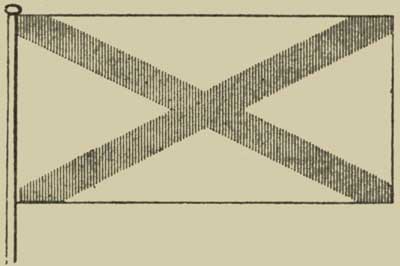
St. Patrick was the Christian apostle of the Irish, and thus became their traditional patron saint. The story of his life is that he was born in Scotland, at Kilpatrick, near Dunbarton on the Clyde, and being taken prisoner by pirates when a child, was carried into Ireland and sold there as a serf. Having acquired the native language, he escaped to the continent, and afterwards becoming a Christian and having been ordained to service in the Church, returned to Ireland for the purpose of converting the people. The British name said to have been given him in his youth was Succeath (valiant in war), a temperament which he certainly impressed upon the Irish. This name was afterwards, when he returned to Ireland, changed to Patricius, in evidence of his noble family descent, and to add importance to his mission.[75]
The legends of the saint date back to A.D. 411, when he is reported to have commenced his mission, and to have afterwards devoted his life to the increase of the well-being of the people and the spread of Christianity throughout Ireland. Tradition reports, although some do not put much faith in it, that the saint suffered martyrdom upon a cross of the shape of this red cross, and thus, when he became the patron saint of Ireland, it was held in recognition as his emblem, and for that reason was adopted as the Irish cross.
On the other hand, some people declare that the cross of the saltire shape is sacred only to St. Andrew.
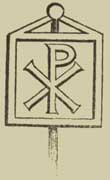
Another suggestion is that the shape of the saltire cross, both of the Irish and the Scotch, is derived from the Labarum (29), or Sacred Standard, which was raised by Constantine the Great, the first Christian emperor of Rome, as the imperial standard of his armies. On this he had placed a monogram composed of the first two letters, ΧΡ (ChR), of the Greek form of the sacred name of Christ (ΧΡΙΣΤΟΣ), and the saltire cross is reputed to be the repetition of the Χ of the lower part of the Christian emblem.
The Labarum was the official standard of the Emperor of Rome, and upon it were displayed the "insignia" of the emperor of the day. Constantine, after his conversion to Christianity, had changed his previous insignia to the Christian emblem.
Should this latter suggestion of the origin of the[Pg 143] cross of the saltire shape be accepted as the preferable one, this saltire cross has yet a most interesting and particular connection with the early history of Ireland.
The Roman Governor of Britain, under the Emperor Diocletian, when, in A.D. 301, the pacification of IBERNIA (Ireland) had been completed, was Constantius Chlorus, the father of Constantine.
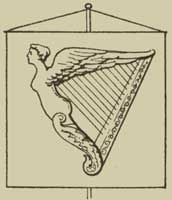
The goddess of the pagan islanders was the Goddess Hibernia, whose emblem was a harp, and this Hibernian Irish harp (30) Constantius had in testimony of his success adopted as the insignia for his standard.
After the resignation of Diocletian, Constantius Chlorus and Galerius were created joint emperors of Rome, and, dividing the empire between them, Galerius took the East and Constantius the West.
The death of Constantius occurred soon afterwards in England, at the city of York (Eboracum), and there he was succeeded as Emperor of Rome by his son Constantine.
Constantius had in some degree restrained the persecution of the Christians in Britain, which had raged under Diocletian, but it was now completely suppressed by the new emperor. Carrying with him his faith in Christianity, which he had learned in Britain, Constantine removed to the continent to engage in the contest for the com[Pg 144]mand of the empire to which he had fallen heir, and in the battle of the Milvian Bridge, near Rome, in A.D. 312, he defeated the opposing eastern forces under Maxentius, and entered into undisputed possession of his position as sole emperor. It was just before this engagement that Constantine is reported to have seen a cross shining in the heavens at midday, having on it the inscription, ΕΝ ΤΟΥΤΩ ΝΙΚΑ ("In this conquer"—"In hoc signo vinces"), and, therefore, recognizing the Christian emblem, he adopted the Christian cross as his standard and placed the sacred monogram upon his Labarum. This victory resulted in the official recognition of the Christian religion, and the attaching to it of all the political power of the Emperor of Rome.
Constantius had lived, and Constantine the Great had been born and brought up, in the north of England, which, during the Roman occupation, had been converted to Christianity by missionaries from Scotland, whence St. Patrick afterwards also went to Ireland; and as it was to Constantine that the Christians owed their rescue from persecution, his insignia would, therefore, be heartily received. The early Christians, through this source, may have adopted the X cross, the lower part of Constantino's Christian monogram, as their emblem, and thus it had become associated in Ireland with the Christian labours of St. Patrick, their apostle and patron saint. In this "story of the Irish Jack," it is a notable transition that the harp emblem of Hibernia, carried by Constantius, and transmitted by him to his son, and by Constantine changed to the[Pg 145] Christian Labarum, should in this diagonal cross of St. Patrick have been returned to become the emblem of Ireland.
Whichever may have been the source of its origin, the saltire cross, in its form of the red cross of St. Patrick, is by both lines of descent intimately associated with the history of Ireland, and is rightfully claimed as one of its national emblems.
The harp, too, has its story much later than that of St. Patrick's cross, but yet bringing an interesting connection with the patron saint.
The ancient arms of Ireland, from the time of Henry II., in 1172, had been three golden crowns set upon a blue ground.[76]
These ancient arms of Ireland are the arms of the Province of Munster, and are now worn on the helmet plate and glengarry of the Royal Munster Fusiliers regiment of the British army.
Henry VIII. was the first English king who used an Irish emblem. When he was proclaimed King of Ireland, he placed the harp of Hibernia upon the coinage which he then issued, instead of the "three crowns" which had been used under his predecessors, but he did not introduce the harp into his royal arms, nor place the red cross of St. Patrick upon his banner.
The first English monarch to insert an Irish emblem in the official insignia of the sovereign was Queen Elizabeth, who introduced one in the design of her "Great Seal." Instead of using the three Irish[Pg 146] crowns, she inserted a harp as the emblem of the Irish nation, and among the banners displayed at her funeral Ireland was represented by a blue flag having upon it a golden harp surmounted by a crown.[77] James I., her successor, was the first king to introduce an Irish emblem into the "royal standard," and from that time onward the golden harp of Hibernia, on the ancient blue ground of the three Irish crowns, has been shown in one of the quarters of the British standard as the emblem of Ireland. In the arms of all the sovereigns, from James I., 1603 (15), to and including William IV., 1837, the front of the harp was formed by the female figure representing the goddess Hibernia. During the Victorian period a change was introduced in the shape of the harp, which has been altered to that of the ancient Irish harp, connected in form and legend with King Brian Boru (Boroimhe).
The exploits of this most noted of the early kings of Ireland had been mainly devoted to the defence of his kingdom against the invasions of the Danes during the period when, under Canute, they had well-nigh conquered all England.
Although in the main successful, he was slain in battle, according to some, in 1039,[78] or, as others report, in the hour of victory over the Danes at Clontarf, near Dublin, in 1014.[79]
The king, having accepted Christianity, presented, in 1004, a golden votive offering upon the altar of[Pg 147] the church at Armagh, and here, in accordance with his dying request, his body was buried after the battle of Clontarf.[80]
This city of Armagh is reputed to have been founded about A.D. 445, by St. Patrick, and to this account is accredited the ecclesiastical pre-eminence which has always enshrined the city, for the Bishop of Armagh is the "Archbishop and Primate of all Ireland" of the Protestant Church, and it is the See city also of the "Primate of Ireland" of the Roman Catholic Church.
Of all the traditional patrons of Irish music, King Brian Boru was the most renowned, and thus in poetry and song his name became identified with the Irish harp.
The minstrelsy of the Irish harper has held sway and been cherished through all the ages by the Irish people, whose temperament may have been affected, or else has been most touchingly expressed, by its strange and mystic cadences. The sweet pathos of these ancient melodies has given tone and inspiration to most of the Irish songs, markedly to those of the sweet singer Moore, whose music has installed in affectionate memory,
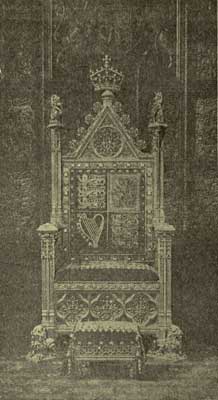
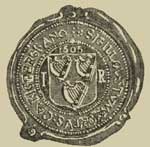
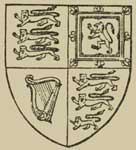
In the old seal of Carrickfergus (31), granted by James I., the form of this ancient harp of Brian Boru is excellently displayed.
Within the circle are the initials of the King, I.R. (Jacobus Rex), and the date 1605, and on the shield in the centre are three Irish harps, having the rounded front pillar and the curious upper sweep of the neck, termed the "harmonic curve," of the type known as the Irish harp of Brian Boru.
Although this Irish harp was introduced in the seal of the Irish city during his reign, the emblem which had been placed in his royal arms by James I. as the emblem of Ireland was the angelic harp of Hibernia, and in this form it remained on the royal standards of all the succeeding sovereigns until Queen Victoria, in whose royal arms (32) the Irish harp was displayed.
In 1849, when Queen Victoria first visited Ireland, being the first occasion upon which a British Queen had ever visited the Island, a medal was struck to commemorate the event. On this are the profiles of Her Majesty the Queen and the Prince Consort, and on the reverse (33) is the old Irish harp surmounted by the royal crown.
It is true that the angelic harp is frequently to be seen upon the flags flown as royal standards, but the Irish harp is most beautifully shown in the coat-of-[Pg 149]arms upon the back of Her Majesty's royal throne in the House of Lords at Westminster (34).
As the harp of the pagan goddess Hibernia had been changed to the Christian cross of St. Patrick, so now again it had been followed by the Irish harp of the Christian King, Brian Boru, and through his grave at St. Patrick's ancient city of Armagh is again connected with Ireland's patron saint. Thus, whether it be cross or harp, both the official emblems of Ireland are associated with St. Patrick.
During only one period in the early story of our Flag had Ireland been represented on its folds, as is shown in Cromwell's Jacks and in the Commonwealth Ensign (Pl. IV., figs. 1 and 2), but it had not been by a cross, as were the other nationalities, but by a golden harp on a blue ground.
Another emblem of Ireland, the green shamrock, is also connected in legend with St. Patrick, as having been used by him, through the lesson of its three leaves joined in one, in explaining the doctrine of the Trinity. Thus both the shamrock and the red saltire cross form the salient features of the insignia of the "Most Illustrious Order of St. Patrick," the Irish order of knighthood.
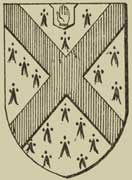
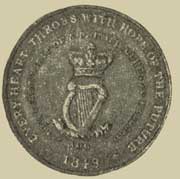
The Irish red cross on a white ground had been[Pg 150][Pg 151] the ancient banner of the Irish family of the Fitzgeralds before the time of the conquest of Ireland under Henry II., and it still appears in the arms of their descendants (35). It appears to have been used as a flag at Cromwell's funeral, but notwithstanding its still earlier associations the red cross of St. Patrick does not seem to have been formally recognized as the general national emblem for Ireland until about the close of the seventeenth century. Its entrance into the Union Jack had long been delayed for reasons which will be pointed out.
Though the kings of England had, since Henry II., in 1172, been "lords paramount," and since Henry VIII. been "kings of Ireland," the national Jack of Ireland had not been joined with the other Jacks. When the crosses of St. George and St. Andrew were combined in the "additional" Jack of James, in 1606, it was not included, nor was it afterwards, in the first Union Jack of Queen Anne, in 1707; so that for all these centuries the red cross of St. Patrick had continued alone. At length, the time was coming when another change was to be made in the Union Jack, and it was in 1801, under George III., that the red saltire cross of Ireland first joined the two sister crosses. For the immediately previous two hundred years the Irishman had gallantly contributed his prowess to the glories won under[Pg 152] the two-crossed Jack, in which his nation had not been represented; but from this time onward his own Irish cross entered into its proper place in the national Union Jack, and received its acknowledged position as the emblem of the Irish kingdom.
THE JACKS IN THE THIRTEEN COLONIES OF NORTH AMERICA.
We now turn to the history of the Jacks in the country to the south of Canada, where immigration from England had been building up the thirteen English colonies which subsequently became the United States of America. The Spanish flag had been planted in 1492 by Columbus upon San Salvador in the Bahamas. In 1497, Cabot had placed the St. George cross, the English Jack of Henry VII., on the North Atlantic shores, and the English claim by right of first discovery was thereafter laid to Newfoundland, Labrador, and the coast of America, from Cape Breton to Maine. Under Elizabeth, Raleigh, in 1584, expanded the claim of the St. George cross in Virginia far to the south, and in 1602, under the same flag, Bartholomew Gosnold, sailing out for the merchant adventurers of Bristol, exploited the shores of Nantucket, Martha's Vineyard, and Elizabeth, which still retain the names he then gave them. Other adventurers, too, there were, who were searching the unknown resources of the new continent. Jacques Cartier, in his second voyage, had, in 1535, occupied Stadacona (Quebec), and the French flag had been established on the shores of the St. Lawrence, the per[Pg 154]manent settlement at Quebec being founded by Champlain, in 1608. For more than two hundred years the cross of St. George had been prospecting along the Atlantic coasts and laying claim to their possession, but no settlements were permanently established on these shores by any except the Frenchman, De Monts, who raised the white flag of France at Port Royal, on the Bay of Fundy, and laid the foundations of the town in 1605, and from this time on began the contest for their final ownership.
The sovereigns of France and England had with profuse liberality given royal grants of American territory to their venturesome merchant seamen, and in this manner James I., in 1605, partitioned off the larger part of these shores to the two merchant-adventurer companies of London and Plymouth.
The Plymouth Company was granted the country between what is now known as New Brunswick and Long Island, to be called Northern Virginia, and the London Company from the Potomac to Cape Fear in Carolina, to be called Southern Virginia—the two hundred miles intervening between them being left unoccupied in order to separate their boundaries, and so ensure peace between the rival companies, each company being warned not to make any occupation beyond the limits of the territory so allotted to them.
The London Company in 1607 established themselves in Virginia, where their Capt. Newport, after a weary and wave-tossed voyage, named their first shelter and landing place "Point Comfort," and the river the "James," and their settlement "Jamestown," in honour of his King.
It was into this interval between the two English companies that Hendrick Hudson sailed in 1609, and planted the Dutch flag, with its three lengthwise stripes of orange, white and blue, the orange being the uppermost, over New Amsterdam (now New York).
To these English colonists fell the honour of the first contest for the flag.
The French had occupied Acadia, and were quietly extending southward, when, in 1613, Commander Samuel Argall, of Southern Virginia,[81] finding them trading off Mount Desert, in what is now Maine, captured and destroyed their new shore settlement of St. Sauveur, and next year, heading an expedition sent out by his Colony, advanced farther northward, and destroyed their headquarters at Port Royal. Thus the colonists of Virginia, acting for their nation, defended the English claim, and repelled the interference made with the cross of St. George in its rights of prior discovery under Cabot.
The Plymouth Company had not been so energetic as were the London Company in the occupying of their "plantations," but, in 1614, Captain John Smith, on their behalf, settled a port which he called "New Plymouth," and gave the name of "New England" to the surrounding country.
While these things were going on in America the migration of the Puritans from England to Holland had taken place. These non-conforming Independents left their homes in England, in 1609, not from any disloyalty to their native land, but because[Pg 156] their religious views forbade them to bend to what they considered were the unbiblical Church requirements of James I. To his ritual regulations they would not conform, so they removed themselves and their families to Holland. Strong in their English nationality they remained for ten years at Leyden, an isolated and unsettled colony in a foreign land. To England they could not return, no place in Europe was open to them for settlement without losing their language and changing their flag, and they must, therefore, leave Holland and seek the New World lands across the ocean. The Dutch offered them assistance and favourable arrangements for colonization in their Dutch possessions in America. They were also offered inducements by the London Company to settle on the Delaware, in their colony of Virginia. As it was considered that complications might arise if an English colony were to proceed across the seas under the Dutch flag, they declined the offer of Holland and accepted the English proposition, and the consent of King James was obtained to their repatriation in the English territory in America without conforming to the religious conditions to which they had so devotedly objected in the Old Land.
Thus they sought the new land, not as rebels, but as loyalists returning in gladness to their nation's flag.
Forming the "Pilgrim Company," in which they all took shares, a vessel named the Speedwell was purchased at Delft-Haven in Holland, and another named the Mayflower in London. The two parties joined at Southampton. After leaving the shores of[Pg 157] England the Speedwell was found to be unseaworthy, and the two vessels, therefore, returned to England, when it was determined that the Mayflower should proceed alone. There not being sufficient accommodation on the one ship for the combined expeditions, a number were left behind. The Mayflower, a vessel of only 180 tons, sailed from Plymouth with about 100 of the "Pilgrims" crowded on board. On reaching the shores of America in November, 1620, after a voyage of two months and five days, they found that they were far to the north of the Virginia Colony to which they had been commissioned. Tired of the sea, but being hopeful that they would receive, as they subsequently did, a grant of land from the Plymouth Company, and being without a charter for the territory on which they were about to land, it became necessary to make a new agreement between themselves for the government of their colony. A "compact" was accordingly drawn up on board the Mayflower "off Cap-Codd," and signed by all the heads of families. In this document they described themselves as
" ... the loyall subjects of our dread Soveraigne Lord King James by the grace of God of Gt. Britaine, France and Ireland, King-defender of ye faith, &c., having undertaken for the glory of God, and advancement of ye Christian faith and honour of our King & Countrie a voyage to plant ye first colonie in ye Northerne parts of Virginia,"[Pg 158]
and the date of the year is given as
"the eighteenth of 'Our Soveraigne Lord King James.'"[82]
As the Mayflower was an English ship she would carry the St. George cross flag on the foremast, and as they declared themselves to be loyal subjects of King James it is most probable that the "additional" Union Jack of James I. was also displayed at the main.
Such was the beginning of the migration of the Puritans from England, which, following this first colony, continued during the remainder of the century.
That the Pilgrims carried the English Jack is plainly shown by the controversies which arose from time to time in this "New England" district upon the subject of the use of the cross of St. George, not for want of any loyalty to it, but from their strict religious views.
John Endicott, and the Puritans who subsequently settled at Salem, objected to the cross in the flag as being an "idolatrous emblem," and, in 1634, "defaced the ensign by taking out one part of the red cross."[83]
Much discussion ensued upon these conscientious scruples, and the offenders were summoned to appear before the Court of Assistants, but decision was deferred for several meetings, "because the Court could[Pg 159] not agree about the thing, whether the ensigns should be laid by, in regard that many refused to follow them." It was, however, ordered by the Commissioners for military affairs that all the ensigns should in the meantime be laid aside.
Endicott was finally tried at a general court held at Newtown, and "his offence found great; he judging the cross to be a sin, did not content himself to have it reformed at Salem, not taking care that others might be brought out of it; also laying a blemish on the other magistrates, as if they would suffer idolatry, and giving occasion to England to think ill of us." He was, however, lightly sentenced by suspension for one year of right to hold civil office, because "he did it out of tenderness of conscience and not of any evil intent."[84]
A suggestion was made that red and white roses should be inserted in the flag, instead of the cross, as being English emblems, and the ministers were "to write to England and consult the most wise and godly;" but nothing came of this suggestion.
Opinions must have continued strong in the controversy, for at the close of the year the commissioners appointed colours for the military companies, but left out the cross in them all, leaving the space blank, but they ordered that the King's arms were to be inserted in the flag which was to be used on the fort on Castle Island, at Boston.[85]
In the following year (1636) much heart-burning was occasioned by the masters of several ships trading[Pg 160] to Boston declaring that because the King's colours were not displayed at the fort the colonists were all traitors and rebels. This imputation was most warmly resented by the people, and the captains were promptly tried by the Massachusetts court for this defamation of the loyalty of the colony.
The offenders acknowledged their error and made humble apology in open court, but in doing so suggested that the King's colours ought to be shown on the fort. To this answer was made, "that 'we had not the King's colours'; thereupon two of them did offer them freely to us. We replied that, for our part, we were fully persuaded that the cross in the ensign was idolatrous, and, therefore, might not set it in our ensign, but because the fort was the King's and maintained in his name, we thought that his own colours might be spread there."[86]
The King's own colours would be the two-crossed Jack of James, which Charles I. had, in 1634, declared as His Majesty's Jack to be the "ornament proper for our owne ships." This Jack was ordered to be thereafter displayed at the fort, lest it might again be thought that the colony had abated its allegiance.
In 1643, the colonies of Plymouth, Massachusetts Bay and Connecticut formed themselves for defence against the French and the Dutch into an alliance as the "United Colonies of New England."
That their forces had continued to use the two-crossed "King's Jack" of Charles I. is proved by the fact that they found it necessary, owing to the change[Pg 161] of sovereignty in the Mother Country, to pass an order authorizing a change in their own flag. The Commonwealth of England had, in 1648, abolished the use of the two-crossed Jack. In 1651, the fleet of Cromwell which crossed the Atlantic was to be seen flying the single English Jack of St. George and the new Commonwealth Ensign at Barbadoes and in Virginia. Following the action of the Home Government, the General Court of Massachusetts overcame their local scruples and passed an order adopting the English ensign:
"Forasmuch as this Court conceives the old English colours now used by the Parliament of England to be a necessary badge of distinction between the English and other nations in all places in the world, till the State of England shall alter the same, which we much desire, we being of the same nation, have therefore ordered that the Captain of the Castle shall presently advance the aforesaid colours of England upon the Castle upon all necessary occasions."[87]
So the English Jack took the place of the Jack of James in America.
Under this St. George Jack, with its red cross and white ground, the colonists not only organized and defended their own territories, but also carried on active operations against the French. As in its earlier years, so also throughout the century, the extensions southward of the French settlements in Cape Breton[Pg 162] and Acadia had been a menace to the colonies. The colony of Massachusetts itself took the matter in hand, and organized an expedition which it sent out under the leadership of Major Sedgwick, in 1654, when Port Royal was taken from the French, but, much to the chagrin of the colony, only to be restored to France, in 1667, by the peace of Breda.
The old controversy about the cross in the flag had by no means been settled by the decision of the General Court of Massachusetts, in 1651, and although it was so displayed officially, yet many individuals still held to the original religious objections.
In 1663, the "Ensign Red," with the plain red cross of St. George in the upper corner, had been ordered by Charles II. to be used.
Thomas Singleton, master of the ship Charles, notes (when off Boston) in his diary of a voyage to the American coast in 1679-80: "I observed that while the English flag or colour has a red ground with a small white field in the uppermost corner where there is a red cross, they have here dispensed with this cross in their colours and preserved the rest."[88]
The New England colonists were evidently flying the Ensign Red, but had taken the red cross out of the Jack in its upper corner, leaving only the white ground. It was in this it had been suggested that the roses of England should be introduced, and in which the "pine-tree" emblem was afterwards placed.
The importance of the particular flags which were to be used along these Atlantic coasts, where the nationalities were constantly coming into contact, was eminently increased by the terms of a treaty, made in 1686, between James II. and Louis XIV., providing "for rights and pre-eminences in the American seas." Under this it was agreed that,
"the British shall not trade nor fish in the havens, bays, creeks, roads, shoals or places of the French in Canada,"
and vice versa, the French were not to interfere with the British; and further,
"that whensoever the subjects of either king shall be forced to enter with their ships into the other's ports, they shall be obliged at their coming in to hang out their flag or colours of their nation, and give notice of their coming by thrice firing a cannon, and if they have no cannon by thrice firing a musket, which if they shall omit to do, and, however, send their boat on shore, they shall be liable to confiscation."[89]
Governor Andros brought out with him from England, in 1686, his official flag as Governor of New England. A drawing of this in the British State papers office[90] shows it to have been a large St. George Jack, having on the centre of the red cross a royal crown, and underneath the initials of the King, I.R. (Jacobus Rex), in gold. This Governor's flag was[Pg 164] officially used by Governor Andros in the colonies of Massachusetts and Connecticut.
The united colonies of New England, moved, no doubt, by the necessities of the Treaty of Whitehall, passed an Order-in-Council, in 1686, directing the cross to be restored to their Colours. In this way the red cross of St. George came back into the blank white space which had been left in the upper corner of the Ensign Red.
We get some glimpse of the mental difficulties of the times from the diary of Samuel Sewall, an officer in the colonial forces. On August 20th, 1686, he writes:
"I was and am in great exercise about the cross to be put into the colours, and afraid that if I should have a hand in it whether it may not hinder my entrance into the Holy Land."
He even contemplated the necessity of retiring from the service, and enters:
"In the evening seriously discoursed with Captain Eliot and Frary signifying my inability to hold, and reading Mr. Cotton Mather's arguments to them about the cross, and say'd that to introduce it into Boston at this time was much, seeing that it had been kept out more than my lifetime, and now the cross much set by in England and here; and it scarce could be put in, but I must have a hand in it. I fetch home the silk Elizur Holyoke had of me to make the cross, last Friday morn, and went and dis[Pg 165]course Mr. Mather. He judged it sin to have it put in, but the captain not in fault, but I could hardly understand how the command of others could wholly excuse them, at least me who had spoken so much against it in April, 1681, and that summer and forward, upon occasion of Captain Walley's putting the cross in his colours."[91]
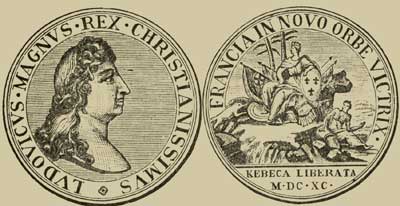
But the crosses were restored, and it was under this single cross Ensign Red that, during the war between William III. and Mary and Louis XIV., the nine colonies[92] united together, and, in 1690, of their own motion and at their own expense,[93] sent out a naval expedition from Boston, under Admiral William[Pg 166] Phips, against the French in Canada. The fleet successfully attacked and again captured Port Royal,[94] but arriving before Quebec, above whose ramparts was flying the white flag and fleur-de-lis of France, was repulsed by the redoubtable Count Frontenac. The records of the expedition, and of the episode of the capture of the flag of the Admiral, which, being shot away from its halliards and falling into the water, was swum after and brought to shore by the venturesome French,[95] attest that this fleet of the United Colonies was sailing under the cross of St. George. A copy of the medal (36), issued by Louis XIV. of France in commemoration of the event, is given in the narrative,[96] showing three fleur-de-lis of France, and the cross of St. George on a flag reversed.
While the forces of the United Colonies thus used, in common, the English ensign, some of the colonies had distinctive flags. Massachusetts at times displayed the red ensign with a "pine-tree" on the white ground in the upper[Pg 167] corner instead of the cross to which so much objection had been made. The flag of New England (37) was the English red ensign with the pine-tree, or else a globe signifying the New World, in the upper corner of the white canton bearing the cross of St. George. The instance given is taken from the old Dutch publication of 1711.[97]
This New England ensign was in continuous local use from 1686 to 1775.
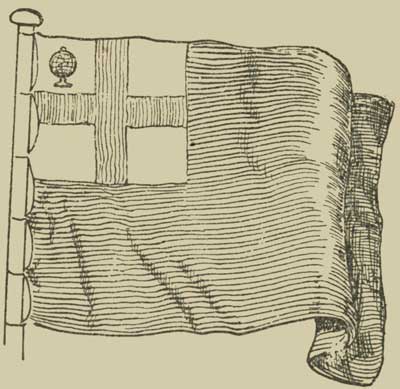
(From a Dutch publication of 1711.)
The change in the English flag, made under Queen Anne, from the cross of St. George to the two-crossed Jack, brought a corresponding change in the union flag in America.
The narrative of the change in Massachusetts, in 1701, is given in Chapter XXVII. (page 280). In 1709, similar instructions were sent out to Governor Hunter for the Province of New York, and the drawing of the flag[98] which is attached to the documents is the same in 1709 as in the instructions of 1701.
Under this Queen Anne Union Jack, Port Royal was once more taken by the forces of the United Colonies, sent out from Boston under General Nicholson, in 1710, and its name changed in honour of their Queen to Annapolis, where both Royal name and British ensign have ever since remained.
The colonists had in all these expeditions stoutly proved their share in the prowess of the British Jacks. Acadia,[99] by the Treaty of Utrecht (1713), had been ceded to Britain, but Cape Breton had remained in[Pg 168] the hands of the French, and Louisbourg having been created by them the strongest fortress in the New World, the British colonists determined upon its reduction.
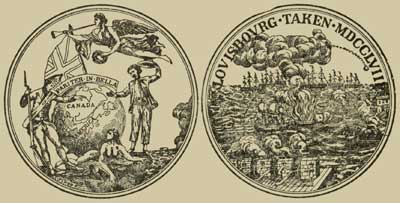
In 1745, an expedition, entirely colonial, organized by General Shirley, of Massachusetts, and William Vaughan, of New Hampshire, sailed from Boston under General Pepperell. After a siege of forty days Louisbourg surrendered. In 1748, the fortress was again restored to the fleur-de-lis by the Treaty of Aix-la-Chapelle, but only to be retaken by Wolfe, in 1758, and the Queen Anne Jack, which the United Colonies had before placed above it, was restored and is shown again in the Louisbourg medal,[100] used to commemorate Wolfe's victory (38).
On yet another field the United Colonists carried the Union Jack. In 1762, when Havana was captured from the Spanish by Lord Albemarle, there[Pg 169] were in his fleet of 203 vessels, and among his land forces of 12,000 men, alongside the men from across the sea, colonial contingents sent by the colonies of Connecticut, New York, Rhode Island, New Jersey and Maine.[101]
When Cuba was thus gained for the Union Jack the colonists of America were joined with their British brothers from the Old Land in lowering the flag of Spain, but the island was restored to Spain by the Treaty of Paris, February 10th, 1763.[102]
Thus for over two and a half centuries (1497-1762) had the English Jacks wrestled with the forests and battled along the shores of America, carried first by the merchant adventurers, and afterwards by the several and the United Colonies, as sign of their origin and allegiance. For yet another long period was the two-crossed Jack to be carried by those who had so manfully won competence and glory beneath it, so that at length, even when joining for contest with their parent realm, the Thirteen Colonies held its past and record in such esteem that they placed the Union Jack of Queen Anne in their new Union Ensign as a sign and remembrance of their common history.
THE UNION FLAGS OF THE UNITED STATES.
The thirteen English colonies which in succession had been planted in North America, along the shores of the Atlantic from the French possessions in Acadia to the Spanish possessions in Florida, had each its own "colony flag"; the "United Colonies of New England" had devised the New England flag to distinguish their particular union; but the national flag which declared the union of all the colonies with one another, and with the Motherland beyond the seas, was the "Union Jack" of Great Britain.
It was under the Union Jack that the forces of the colonies of Massachusetts, New York, Pennsylvania and Virginia had marshalled in 1755, and with the English regulars had advanced, under the leadership of Braddock and Washington, to drive the French out of the Ohio Valley, but to meet with such signal disaster on the banks of the Monongahela.
In the same year, under the cross of St. George in their United Colonies flag, the colonists of New England joined in the victories over the French, and changed the name of the lake, by whose shores they fought, from "St. Sacrament" to "Lake George."
Under the successive Jacks the colonies had grown into commonwealths, had expanded their territories, and their sons had written their names in British history by gallant deed and notable achievement.
Thus the crosses in the Union Jack had a vivid meaning, and their local historic record had won for them the attachment of the people in the colonies.
The occupation of Quebec by Wolfe in 1759 and the subsequent retirement of French rule from Canada and the valley of the North Mississippi had freed the colonies from conflict with the power which had hitherto opposed their expansion beyond the Alleghanies. They were now free to exploit the West, which this victory of the parent realm had gained for them, and which was to be the wide field for their subsequent expansion. Combining together for these adventures had brought the separate colonies more into contact with each other and created points of internal union. At length the time came when rifts in the methods of government on this continent began to show themselves.
Troubles had been brewing between the colonies and the Home Government ever since the passing of the obnoxious Stamp Act of 1765, but, although the friction had at times been great, there was no intention on the part of the colonists of severing their allegiance from the parent realm. The cause of the colonists in America was largely espoused among the English people. Lord Effingham, upon his regiment (the 22nd) being ordered to America, resigned his commission in the British army, "rather than con[Pg 172]sent to bear arms against my fellow-subjects in America."[103]
No more ardent adherents or outspoken advocates for the self-government of the colonies were to be found in America than were Chatham, Burke, and Charles James Fox in the Parliament of England, and under the later and better conditions which have since governed the relations between Great Britain and her outlying colonies there would, in all probability, have been no breaking of the old home ties.
Engaged in the throes of a great European war, Britain had poured her men into Spain and could spare but few of her own for service in America. Forces, consisting largely of hired Hanoverian and Hessian soldiers, had been sent across the sea to enforce the objectionable enactments, and hostilities had broken out in June, 1775, between the resident citizens and these imported "regulars"; but even after this entanglement, the flag, which was introduced for the "United Colonies," was raised, not for the purpose of indicating any alteration in allegiance, but to evidence the local union of the still loyal colonies against the dictation of the impracticable home ministry.
That these were their views towards Great Britain they most plainly stated in the address they sent to the King immediately after their armies had been placed in the field:
"We not only most ardently desire that the former harmony between her and these[Pg 173] Colonies may be restored, but that a concord may be established between them as to perpetuate its blessings uninterrupted to succeeding generations in both countries."[104]
As in previous wars of defence or of adventure, the separate colonial forces were again brought together into one army. On their assembling at Cambridge, in July, 1775, they were mustered into one service under General Washington. As was recorded in a local paper, "None of the men who have been raised by this (Massachusetts) and several other colonies are in future to be distinguished as the troops of any particular colony, but as the forces of 'The United Colonies of North America,' into whose joint service they have been taken by the Continental Congress."[105]
As early as October, Washington found the necessity of having some "continental flag" which should identify the whole of the forces of "The United Colonies of North America" thus assembled together under his command, instead of having the military detachment from each colony continuing to use its own individual flag.
An existing ensign used by the Colony of Pennsylvania was at first proposed by him for this purpose, having a white ground with a tree in the middle, and the motto, "Appeal to Heaven."[106]
This was succeeded by a new design, devised for[Pg 174] the Continental Union flag (39), which, to the accompanying salute of thirteen guns, was raised by Washington over the camp of his army at Cambridge, Massachusetts, on the 1st January, 1776, being the occasion of its first appearance.
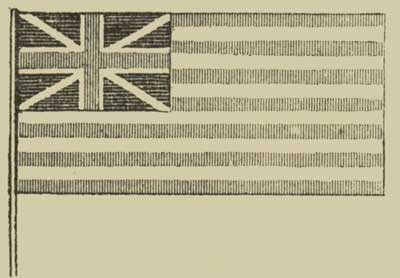
This flag was called "The Grand Union" (Pl. VI., fig. 1). It was composed of thirteen stripes of alternate white and red—one for each colony—and in the upper corner was the British Union Jack of that period, displaying the two crosses of St. George and St. Andrew, as introduced in 1707.
There existed at the time a flag which had been carried by the English East India Company over their British possessions in India since 1704. This was composed of thirteen stripes, red and white alternately, and had the single red cross of St. George upon a white ground (the old English Jack) in the upper corner. This flag might have been seen on the vessels trading to America and exchanging products between the English East Indian and the American colonies, and thus being recognized as a "colonial flag" it may, with the change of form of the Union Jack, have suggested the new ensign.
PLATE VI.
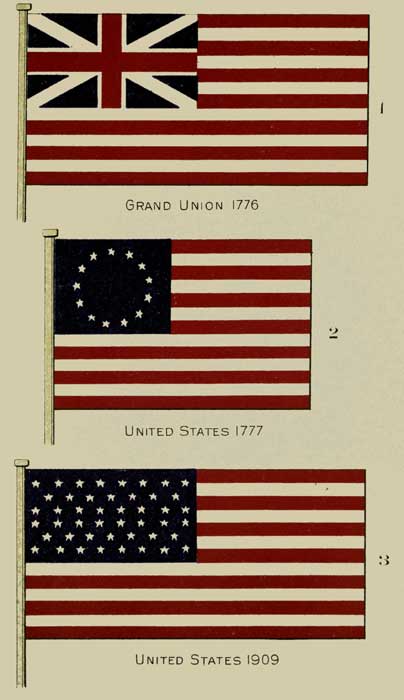
| 1 Grand Union 1776 |
| 2 United States 1777 |
| 3 United States 1909 |
There is no direct evidence as to the flag which had been raised by General Putnam at the outbreak of hostilities at Bunker Hill, June 17th, 1775, but[Pg 175] tradition reports[107] that it was the ensign of the colony of New England (37), which, like the East India ensign, had the St. George's cross on a white ground in the upper corner; but the whole fly of the flag was red.
In the selection of a new flag for the combined forces of the united colonies, what design could be more reasonable or more appropriate than the selection of that Union Jack under which their united armies had so often fought, together with the addition of thirteen stripes to indicate the number of colonies then assembled together?
This retention of the Union Jack in the new flag was designedly intended to signify that the American colonies retained their allegiance to their Motherland of Great Britain, although they were contesting the methods of taxation promulgated by its Government.
By this flag the thirteen colonies testified that, though in arms, they still claimed to be Britons, and were demanding for themselves all the rights of citizenship which such relation conferred.
It was, as one of their orators has well said, "the flag of the British colonies in arms to secure the rights and liberties of British subjects."[108]
The first Union flag raised by Washington over the armies of the united colonies thus displayed the British Union Jack.
Another flag (40) bearing the Union Jack is still[Pg 176] extant.[109] It is a crimson red flag, having a rattlesnake painted upon it, and in the upper corner is the Union Jack of 1707. This was carried by a regiment of the colony of Pennsylvania, and was used at the Battle of Trenton, December 26th, 1776, and in subsequent engagements with the British regular forces.
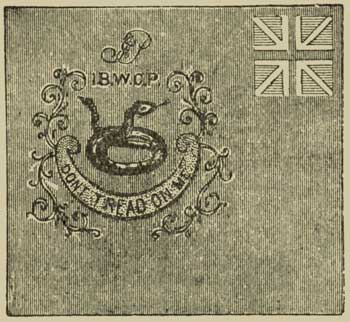
The intention to cure the troubles by constitutional means had become unhappily merged in the appeal to arms.[110] As the hostilities proceeded rancour grew, and then a new flag was sought for, which should typify the changed conditions. The source from which arose the idea of this final design we shall presently see.
On July 4th, 1776, the Declaration of Independence followed,[111] but the "Grand Union" still continued to be used by the thirteen colonies, which had now become thirteen States. It was not until[Pg 177] June 14th, 1777, or almost a year after the Declaration, that a new national flag was fully developed.
The Congress of the United States, then in session at Philadelphia, approved of a report made by a committee[112] which had been appointed to consider the selection of a Union flag, and enacted,
"That the flag of the thirteen United States be thirteen stripes, alternate red and white; that the Union be thirteen stars, white in a blue field, representing a new constellation."
The new enactment was not at once put in force and a still further delay ensued, but at length, on September 3rd, 1777, this flag was officially proclaimed as the Union Ensign of the United States (Pl. VI., fig. 2), and was the first national flag which was officially adopted by the authority of Congress.
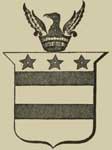
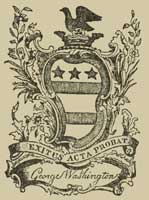
As Washington himself suggested the first design, and had introduced the second, it is not improbable, and, indeed, it is recorded that he actually had somewhat to do with the designing of the final one.[113] However this last report may be, his friends and admirers most certainly had, and the similarity between the design of the final flag and the coat-of-[Pg 178]arms of the Washington family points to the source from which they deduced the completed design.
Upon the tombstones of the family in Sulgrave Church, Northamptonshire, England, and upon the old manor house occupied by them in the time of Henry VIII., is to be seen the shield (41) of the Weshyntons,[114] or Washingtons, an old English county family, who traced their lineage back into the fifteenth century.
John Washington, a descendant of this family, had been a loyal cavalier, standing staunchly by his King, Charles I. When Cromwell and the Roundheads came into power, the Royalist Washington emigrated, in 1657, to Virginia, bringing out his family, and with them his family shield, on which are shown three stars, above alternate stripes of red and white. Having settled upon considerable estates, he and his descendants kept up the old ways, and maintained the style and country standards of their English forefathers.
George Washington, the subsequent President, was the great-grandson of the old loyalist colonist. He, too, served in the forces of his sovereign, King George III., and maintained the old family traditions[Pg 179] and habits in the same way as did all the "first families" of Virginia.
On the panels of his carriage were painted his family coat-of-arms. It appeared on the book-plate (42) of the books in his library, and the first commissions which, as commander-in-chief, he issued to the officers of the Continental army were sealed with his family seal (43).
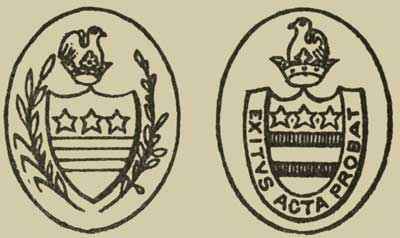
Thus the suggestion for the further alteration was ready to hand. The similarity of one portion of the design already existing could not fail to have been noticed, for the stripes on the Washington coat-of-arms were alternately red and white, as were also those on the Grand Union.
It had been suggested that the idea of the "new" constellation was derived from the analogy of the "old" constellation of Orion containing thirteen stars, and that the form of the stars was taken from a seal said to have belonged to John Adams, one of the committee for designing the flag.[115]
Reference to the details of this seal shows an eagle bearing in its claws the lyre of Orion, both being surrounded by a circle of thirteen stars; but the stars on the seal are all shown as sidereal six-pointed stars, and not five-pointed as are the Washington stars.
The stars which were inserted in the flag when the Union Jack was withdrawn were not the six-pointed stars which would be used heraldically if representing a "sidereal constellation," but are the five-pointed stars of the Washington armorial bearings.
So it happened that the stars and stripes of the coat-of-arms of the old loyalist English family, to which the successful Revolutionary general belonged, and of the seal with which he had attested the commissions which his officers had received from him, formed the basis for the design of the new American flag, and through them the memory of the great leader and first President of the United States is indissolubly connected with the Stars and Stripes, the national ensign (Pl. III., fig. 3) of the nation which he brought into existence.
The American had good right to be proud of that Jack, in whose glories he had so valiantly borne his part, and when as Englishmen battling for the rights of Englishmen the united colonies formed their colonial ensign they had rightly placed the Union Jack in its upper canton as evidence of those glories and of that claim.
Afterwards, when their new nation had been framed, and the Washington stars had marked the new allegiance, the thirteen stripes of the old thirteen English colonies still remained to attest to himself and to the world the Americans' share in the preceding centuries of Anglo-Saxon adventure and their heritage in all the liberties and literature of the English tongue. The rights won by the Barons from John, the works of Chaucer, Shakespeare, Milton, are still[Pg 181] theirs by hereditary right, and the thirteen Anglo-Saxon stripes in his national emblem proclaim this to the American of to-day as they did to his forefathers in the thirteen colonies who first placed them in his union ensign.
The bitternesses arising out of a fratricidal contest fanned by the misrepresentations of fervid orators have for long decades misread the events and obscured the history of that dividing strife, but British law and the English tongue still speak in the flag of the old English colonies which continues to form part of the national ensign of the United States.
THE JACK AND PARLIAMENTARY UNION IN BRITAIN.
The history of the flag, so far as we now have followed it, has been the story of martial or naval prowess and of the extension of its power and command around the world; but there is another story told in its combinations which is even greater in power, and has still deeper meaning in the welfare of the peoples who have come beneath its sway.
The kingdom of England for centuries had its own St. George's Jack, and the kingdom of Scotland its cross of St. Andrew. These red and white crosses had been the accepted symbols of their respective nationalities. Each of the kingdoms had its own separate Parliament, differing, it is true, from that of the other in methods and in many details, but representing the constitutional machinery adopted in each community for consultation between the King and his subjects, who, through their representatives, were advised upon matters connected with the government of their country, whether in its internal laws or in its relations with foreign powers. In course of time the same sovereign, in the person of James I., had by virtue of his birth succeeded to the throne of England, as well as to that of Scotland. The kingly[Pg 183] office in both the kingdoms had thus been merged in the person of one and the same King. A new flag had been created representing the allegiance which had then been joined in the one sovereign. In this the crosses of the two kingdoms had been joined together in one design, but the separate national Jacks of each had been still retained and their use continued in force.
These separate national Jacks were certainly intended to evidence the continued separate national existence of each kingdom, while the new personal Jack or banner of the King would appear to have evidenced the union of the thrones in one person, and to represent the united fealty offered to the one King. Yet it is fairly open to question whether this Union Jack of James I. was at first created to mean as much as this, or whether it was not, after all, introduced more for the purpose of avoiding trouble between the sailors of the two nations, and only intended at first to be a local convenience for the preventing of dissensions.
The new Union Jack certainly did not represent a union of the nations, else why did the two national Jacks still remain? If it had been intended to represent the fealty of his subjects to their King, why was it not introduced immediately upon his accession, and why was not the red cross of the Irish included as well as the crosses of the English and Scots, for the Irish were equally at the time subjects of James I.?
The Irish had, in fact, been subjects of his predecessors for many centuries. In 1171, after the con[Pg 184]quest of the island had been effected by Henry II. of England, the native princes of Ireland had declared fealty to the prince—not in his capacity as king, but in acknowledgment of his position as having become by conquest the "Lord of Ireland." The country had from very early days been governed by its own Parliaments, whose meetings are recorded as having taken place as early as 1295; but it was not until 1522 that Ireland was raised to the rank and designation of a kingdom. In this year an Act was passed by the Parliament of Ireland declaring Henry VIII., the King of England, to be also the King of Ireland, and it was by virtue of this Act that the King of England first assumed the additional title of King of Ireland. The flag of England was at this same time the single St. George Jack; yet, although the crowns were thus formally united, the cross of St. Patrick was not added to the red cross of St. George as a Union Jack in sign of fealty to the one sovereign.
After this, the Kingdom of Ireland owned fealty to three more sovereigns of England in succession;[116] yet under none of them were the crosses of the two national flags joined together. It was not until a Scotch king, the great-grandson of Henry VIII., became King of England, that any of the three national crosses were combined. In 1603, James I. became King of Ireland and England, as well as of Scotland; yet notwithstanding that the three sister kingdoms were thus united in allegiance under his united crown, the three separate crosses of the national Jacks of each were not united in one flag. James I. on his[Pg 185] accession had at once added the Irish harp to the quarterings of his Royal Standard (15), but three more years passed before he entered the red cross of St. George in the "additional" two-crossed Union Jack which he then created. All these incidents point, evidently, to the view that the union of the crosses of St. George and St. Andrew in the new flag of 1606 did not arise as an emblem of the union of thrones, but was mainly devised, as the King's proclamation distinctly stated, for the special and local purpose of keeping the sailors of the two nations most interested in shipping at peace, and thus to prevent their crews from quarrelling with one another as they sailed their ships around the shores of Great Britain.
It required, in fact, something more than a mere union of allegiance to create a real Union Jack, and to entitle the national crosses of the kingdoms to be entered upon its folds; and what this requirement was the history of the entry of the St. Patrick cross into the Union flag enables us to see even yet more clearly.
It will be remembered that a change in the "additional" Jack of James was made in the sixth year of the reign of Queen Anne, and that the occasion of this change was coincident with the union of the separate Parliaments of England and Scotland into one British Parliament.
It was so soon as this occurred, but not until then, that the flag in which the two national crosses were blended was made the sole national ensign.
It was in 1707 that this first Union Jack was created. Queen Anne was at the time Queen of Ireland as well as Queen of England and Scotland.[Pg 186] She had quartered the harp of Ireland in her Royal Standard five years previously, at the time when she had commenced her reign; yet the Queen, when forming the new flag, did not join the cross of St. Patrick in her Union Jack any more than had King James when forming his.
For ninety-four years longer the red cross Irish Jack continued in its separate existence. The reign of Queen Anne had come to its close; three more sovereigns[117] in succession had ascended the united throne of Great Britain and Ireland, and successive changes had been made in the emblazonings on the Royal Standard, yet in all these reigns the Union Jack, which had been declared to be the only flag of the realm to be worn by their subjects, and which was raised over the new dependencies which the united valour of all three nationalities won for the crown, contained only the crosses of St. George and St. Andrew, representing but two of the kingdoms included under its rule (44).
At last, in 1801, during the forty-first year of the reign of George III., the Irish Parliament was united with the Union Parliament of England and Scotland, and then, and not till then, was the red cross of St. Patrick blended with the other two national crosses.
The emblem of Scotland had not been blended with that of England in one Union Jack until their Parliaments had been united; so the emblem of Ireland was not added to the other two until her Parliament had also been joined with theirs. So soon, then, as the three kingdoms were joined in union under one[Pg 187] Parliament, for the first time the three crosses of the three national Jacks were united in one three-crossed Union Jack.
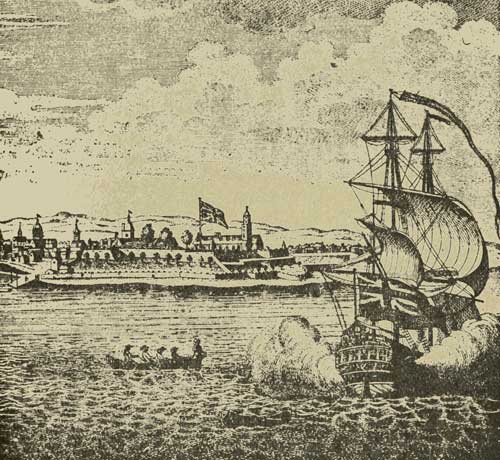
(From an old print.)
We thus have learned what was the necessary qualification to entitle a national cross to be entered in the union ensign.
It needed a union of Parliaments to create a real[Pg 188] Union Jack—a flag in which the national crosses should each continue to retain their national significance, and, when joined together in union, be still accorded the same precedence which had previously attached to each when separately displayed.
The history of these successive blendings shows most plainly that the triune flag arose, not from union under one sovereign, but from legislative union under one Parliament. The Union Jack, therefore, has become the emblem of the British Constitution and the British race. It is now the signal of loyalty to one Sovereign and the existence of Government under British parliamentary union, and, therefore, wherever displayed, it indicates the presence of British liberties and British law.
THE JACK AND PARLIAMENTARY UNION IN CANADA.
In addition to its harmony with the story of the union and the growth of the Constitution in the Motherland, the Union Jack has also an interesting connection with the extension of the powers and advantages of the British Constitution in Canada, and particularly with the establishment of responsible parliamentary government among its people.
In 1759, the seeds of the new nationality had been sown upon the Plains of Abraham, where the blood of Wolfe and Montcalm had mingled to enrich the soil, and the power of European France in Canada became merged in the power of England.
The French forefathers of the new subjects of King George II. had come largely from those very portions of old France, whose people had crossed over to England with William the Conqueror, and given the British their King.
As says one of our French Canadian historians:
"The immigration of the French, extending from 1634 to 1720, was almost entirely[Pg 190] from among the Normans of Dieppe and Rouen, so that the settled portion of Canada was to all intents and purposes a reproduction of a Norman province. The subsequent settlers were mainly selected in Rochelle, Poictou, Paris and Normandy, to the exclusion of persons from the south and east, and coming out single, they married the daughters of the settled Normans. This accounts for the marked absence of any but the Norman accent and form of speech throughout the French-speaking communities of Canada at the present day."[118]
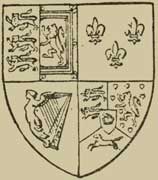
Thus the new French-speaking subjects in Canada were only returning in allegiance to the sovereignty of a king whose ancestors had been placed upon the English throne by their own Norman forefathers; upon whose royal arms (45) were displayed the three fleurs-de-lis as sign of his claim, through his ancestors, to the throne of France (14); upon whose crown was the motto in their own French language, "Dieu et Mon Droit,"[119] and who by the retention of old customs still gave his consent to the laws enacted in his British Parliament in the same old Norman phrase, "Le Roi[Pg 191] le veult" ("The King wills it"), which had been used by his Norman forefathers.[120]
The French habitant felt how easy was the renewal of the old relationship, and accepted the change in the way so well expressed in his Canadian voyageur patois:
There now commenced in Canada an evolution of internal government of the people similar to that which had taken place in the old land of England, but under reversed conditions, beginning here with the incoming of English rule, while there it had commenced with the Norman conquest of England. An eminent French authority[122] has stated his belief that England owed her liberties to her having been conquered by the Normans, and to this we may add the statement of a no less important English author,[123] that "assuredly England was gainer by the conquest." As the advent of Norman rule to England had resulted in such privileges to the English people, so[Pg 192] assuredly the cession of Quebec and the introduction of English government into Canada brought equal blessings to the descendants of those selfsame Normans.
The French Canadian found that under his new Union Jack his property was secure. Under the old régime the French Canadian had practically no voice in the government of his country. There was no system of elective municipal government, no freedom for public meetings, all the legislative and executive power, even to its extremest details, being centralized through the Governor and Intendant in the person of the King of France, who was two thousand miles away. Finding his religious faith untrammelled, his freedom unimpaired, his language preserved, the habitant soon settled down without objection to his new sovereignty.
In 1774, the British Parliament passed the Act known as the "Quebec Act," which granted an increased share of local government to the people of the great province comprising all Canada which was then set apart, and the greater portion of which is now within the present Dominion. This measure of self-government still further assured the French-descended Canadians of the protection of their liberties, so that when the English-descended colonists of the thirteen English state colonies to the south of them revolted from their British allegiance in 1775, French Canada stood firm by the British crown. The descendants of the Normans in Canada were true to the government which their forefathers had helped to create in England.
The march of events now brought an additional set of new subjects to the British Constitution as it had then been established in Canada.
The granting of separation to the thirteen United States, in 1783, was followed by the immigration to Canada of those loyal souls whose hearts revolted at the action of their old colonies in taking down the Union Jack, and who refused to separate themselves from the United Empire, in whose ultimate justice they had unwavering faith.
These "United Empire Loyalists" settled mainly in the parts now known as Nova Scotia, New Brunswick and Ontario. Of the quarter of a million souls who then formed the total population of Canada, about a hundred and forty thousand were of French language and descent, living in the counties adjacent to the St. Lawrence River; and of the forty to fifty thousand Loyalists who, it is estimated, reached the northern colonies during or immediately after the rebellion of 1775, over twenty-five thousand had, by 1786, settled along the western lakes.
Government in Canada had hitherto been conducted by a Governor and a Legislative Council appointed by the Crown, there being no elected representative. A further advance in constitutional self-government was now considered desirable, and the "Constitutional Act of 1791" was passed by the parent Parliament in Great Britain. The ancient Province of Quebec was divided into two provinces, called Lower Canada and Upper Canada, very fairly representing the localities occupied, the one by the older or French-speaking subjects of His Majesty, and the other by the new[Pg 194]coming English-speaking Loyalists, who had followed their old flag into the forests of the northland.
This Act of 1791 gave the right of Parliamentary government to the people of Canada. A Legislative Council and a House of Assembly were created for each Province, the members of the latter house being elected by the votes of people in the counties and towns of each.
The Legislature of Upper Canada held its first session at Newark (now Niagara-on-the-Lake) in 1792, summoned, as said Lieutenant-Governor Simcoe in his opening speech, "Under the authority of an Act of Parliament of Great Britain, passed in the last year, which has established the British Constitution in this distant country." To this he added:
"The wisdom and beneficence of our Most Gracious Sovereign and the British Parliament have been eminently proved not only in imparting to us the same form of government, but in securing the benefit of the many provisions which guard this memorable Act, so that the blessings of our invulnerable constitution, we hope, will be extended to the remotest posterity."
As a sign of this self-government under the British Crown, the King issued his warrant from the Court of St. James on March 4th, 1792, authorizing a "Great Seal for the Province of Upper Canada," to be used in sealing all public instruments. The engraving (46), which is a photo reproduction of the seal attached to the Crown Patent of a grant of one hundred acres of land near Port Hope, Upper Canada, made to a U. E. Loyalist, shows the details of[Pg 195] the design, being, as described in the royal warrant, "an anchor and sword crossed on a calumet of peace, encircled by a wreath of olives, surmounted by an imperial crown and the Union of Great Britain."
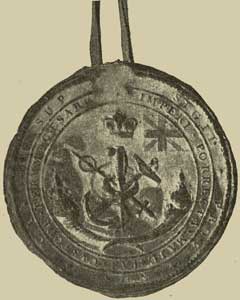
This "Union," which will be seen in the upper right-hand corner of the seal, was the Union Jack of Queen Anne.
The United Empire Loyalists sought their loved two-crossed Union Jack in Canada. They found it not only flying on the flagstaff, but also impressed on the seals of the Grants of land which were made to them in recognition of their loyalty. On these it came to them as a sign of the surety of their legal rights under British law and their full protection under the administration of British justice.
The introduction of this Union Jack had been the result of an Act passed by the British Parliament, that "mother of parliaments," which continues to this day to have vested in it the ultimate political sovereignty of every local Parliament which it has created.
This Union Jack on the Great Seal is in this way the emblem of parliamentary union between Great Britain and Canada, and the sign of the spread of British constitutional government to the continent of America.
But the French Canadian has also an interest in this same Great Seal, for on its reverse side it bore the royal coat-of-arms of the reigning sovereign, and in this were still shown the three lilies of France, in the same way as in the arms of his predecessor, George II. (45). What the Union Jack on the one side was to the English-speaking Canadian, the "fleurs-de-lis" on the other was to the French-Canadian—a visible sign of his own personal connection with the glories of his forefathers, and the evidence[Pg 197] of his glad allegiance to the Sovereign whose connection with the ancient realm of France was represented by these emblems, and with whose realm he was now reunited.
In drawings of the arms of the Province of Ontario (the new name given to the Province of Upper Canada at the time of Confederation, in 1867), the Jack has frequently been shown as containing three crosses. A reference to the impressions made by the seal itself upon the great pieces of white wax, four and a half inches broad by three-quarters of an inch in thickness, which were attached by bands of parchment or of tape to the official documents, shows, as is seen in the photograph, that the "Union" contained two crosses only, namely, the cross of St. George and the cross of St. Andrew.
This Union Jack of 1707 was also shown in the arms of the Department of Education of Upper Canada, from 1844 to 1876, during the régime of Dr. Ryerson as Superintendent. In these the design was the same as on the Great Seal, but the Union Jack was removed from the upper corner and placed upon a shield in the centre, upon which the two crosses of Queen Anne are plainly shown.
In earlier stained glass windows placed in the Normal School, Toronto, the head offices of the Department of Education of Ontario, the three-crossed flag had been shown, but this, on the suggestion of the writer, has been corrected in the new windows placed in the library in 1896.
A further adoption of the national emblem is shown in the design on the early currency, which was[Pg 198] coined for use in the Province. The "penny" of the Bank of Upper Canada (47) shows on the one side St. George and the dragon, and on the other the arms of the Great Seal, having on it the Union Jack,[124] which good national emblem, no doubt, made the money that the Canadian Loyalist earned more acceptable to him. These must have been happy reminders to the patriot, for on the coins which passed current among his people, and on the seal of the deed of the grant of land which his Loyalist father or himself had received for his new home, was the imprint of the old Union Jack, placed there by an Act of the Union Parliament of Great Britain, as the sign of his parliamentary union with that United Empire which ever commanded his allegiance.
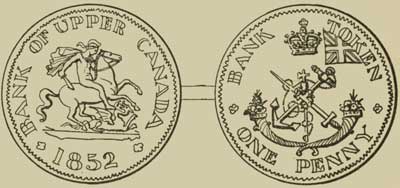
THE UNION JACK OF GEORGE III., 1801.
THE PRESENT UNION JACK.
We come now to the formation of the first, and present, three-crossed Jack, the "Red, White and Blue," of story and of song, being the third Union Jack.
For forty years King George III. had reigned as King of Great Britain and Ireland. The Union Parliament, created under Queen Anne, had administered the affairs of England and of Scotland, but the Parliament of Ireland had continued meeting separately, and the two-crossed Union Jack of 1707 had been the only Union Jack authorized to be raised in the British realm. In the forty-first year of the King's reign an Act was passed in the Parliament of Ireland, whereby it became, as had the Parliaments of the two other kingdoms, incorporated in the one Union Parliament of the United Kingdom of Great Britain and Ireland. As previously, so now again the Parliamentary and completed union of the kingdoms having been arrived at, the Irish Jack was directed to be joined with the Jacks of England and Scotland.
The same deliberate procedure for making an alteration in the Union flag was followed as under[Pg 200] Queen Anne: First, an Act of Parliament creating a further union, the call of the Sovereign as the supreme head of the nations, the appointment of a Committee of the Privy Council to consider the drafts of the changes to be made, then an Order in Council, and, finally, the issue of a proclamation by the King.
The record[125] states: "On the 5th November, 1800, the King in Council was pleased to approve the report of a Committee of the Privy Council, that the Union Flag should be altered according to the draft marked 'C,' in which the cross of St. George is conjoined with the crosses of St. Andrew and St. Patrick."
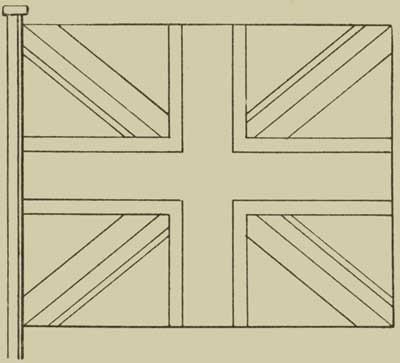
This draft "C" (48) was duly transmitted to the College of Arms, London, and an exact tracing of it as recorded in the books of the college has been made.[126]
The designers of this new Union Jack of 1801 had this time to join three flags together, instead of, as in 1707, only joining two; the problem set before them being the union of the three national Jacks of[Pg 201] the sister nations into one grand Union Jack (Pl. V., fig. 3).
The three flags now to be formed into one Union flag were the incoming Irish Jack, having a red diagonal saltire cross and white ground, to be joined with the "white crosse, commonly called St. Andrew's crosse,"[127] of Scotland, with its blue ground, and the "Jack white with a red cross, commonly called St. George's cross"[128] of England, with its white ground.
The latter two had already been joined in the Union Jack of 1707. The draft "C" (48) gives the method in which the designers proposed the three flags should be combined, and the proportions to be given to each in the new flag, which then received the approval of the King in Council.
Thereafter, on January 1st, 1801, King George III. issued his Royal proclamation from St. James' Palace, declaring His Majesty's pleasure concerning the Royal style and titles appertaining to the Imperial crown of the United Kingdom of Great Britain and Ireland and its dependencies, and also the ensigns armorial, flags and banners thereof.
The clause respecting the Royal coat-of-arms states:
"And that the arms or ensigns armorial of the said United Kingdoms shall be quarterly; first and fourth England, second Scotland, third Ireland; and it is our will[Pg 202] and pleasure that there shall be borne therewith on an escutcheon of pretence the arms of our Dominions in Germany."
The result of this clause was that the lilies of France, which had been quartered in the Royal arms since Edward III., 1327, were altogether removed, and the whole four quarters were appropriated—two quarters to the three golden lions of England, and one quarter each to the red lion of Scotland and the golden harp of Ireland—and upon a shield on the centre was to be placed the arms and white horse of Hanover, to indicate the other countries over which the King also reigned (49).
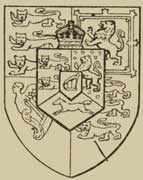
The next clause refers to the Royal Standard or flag of the sovereign:
"... And it is our will and pleasure that the standard of the said united kingdoms shall be the same quarterings as are hereinbefore declared to be the arms or ensigns armorial of the said united kingdoms...."
Although the Royal arms contained a recognition of the King's Hanoverian kingdom, the flag to be used as the "Royal Standard" is ordered to have on it only the arms of the three united kingdoms of England, Scotland and Ireland.
In the clause of this proclamation the Union flag (50), which had already been designed and approved, was described as follows:
"And that the union flag shall be azure, the crosses saltires of St. Andrew and St. Patrick, quarterly per saltire counterchanged, argent and gules; the latter fimbriated of the second, surmounted by the cross of St. George of the third fimbriated as the saltire."
This description defines, with respect to the crosses, that the white cross of Scotland and the red cross of Ireland were joined together quarterly and "counterchanged" and that the red cross of St. George is to "surmount"—that is, to be laid upon the surface of them both. With respect to the grounds of the flag, it is described as being blue, and that the cross of St. George is "fimbriated as the saltire." Much, and almost continuous, controversy early arose upon this heraldic description of the Union flag, particularly with respect to the proportion of the crosses, and specially to the width of the white border to the St. George.
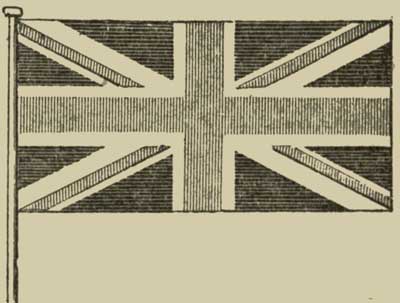
It is to be remembered that heraldry does not, except when specifically given, deal with exact dimensions, but gives the general appearance and particular colourings of the shield or banner. If, as in this case,[Pg 204] the arrangement of the flag selected may have been in the opinion of some of the heraldically inclined, "an extraordinary amalgamation,"[129] and by others not made in accord with the heraldic "blazon" or description given of it in the proclamation, yet this division of its parts is not to be attributed to the "officers of arms" of that day, for it has been expressly put on record that "in this allotment they were not allowed the exercise of their own judgment."[130] Suggestions have constantly since been made that the forms in the flag should be changed, because, as is reiterated, "the guide to all heraldic devices is the verbal blazon of the heralds," and with this, they say, the flag does not agree, for the saltire crosses do not bear the appearance of having been "counterchanged"—that is, alternated, share and share alike; and that the "fimbriation" to the red cross of St. George is wider than an "heraldic fimbriation," which on an heraldic shield is only a very narrow edging or border for the purpose of separating one colour from another.
These are objections arising only from the wording of the "blazon" and not from the flag itself; to the description given of it and not to the design.
We have seen that, both in 1707 and in 1801, the changes made in the "Union Jacks" proceeded by a regular and formal progression of, consideration by Sovereign, Committee of Enquiry, Order in Council and registration of the drafts of design then selected and approved, and the promulgation of the Royal proclamation for its use.
The design of the flags preceded the blazon, or description given of them in the proclamations. We must, therefore, refer to the flags themselves as the guide to their proportions and to the intentions of their designers.
It does not appear that any "draft" of the first flag of James I., 1606, was fyled, but a formal proclamation authorizing it was made by the King "according to the form made by our heralds."
On reference to the "Draft C, 1707," of Queen Anne, for the conjoining of the two flags, it will be noted that the crosses of St. George and St. Andrew are of equal width, and that the white border to the St. George is one-third of the width of either of the crosses. The red and white crosses of the two national flags are thus represented, and the whole of the "crosse-flags" by the blue ground of the Scottish flag in the angles, and the white ground of the English flag in the broad white border.
Queen Anne and her Councillors had in mind the union of the two nations, but there was no "verbal blazon" made or issued, the order being that "the flaggs be according to the 'Draft marked C,'" and as "shown on the margent" of the proclamation.
This authorized Union Jack of 1707 was the basis upon which the designers of George III. began when, in 1800, they were instructed to conjoin the cross of St. Patrick, which was to be added to the union flag.
Comparison of the "Draft marked C, 1800," shows that the broad white border of St. George is retained of the same width as in the "Draft C, 1707," being approximately one-third of the width of the red cross[Pg 206] of St. George and of the saltire cross, both of which remain of the same size as previously. The form authorized by the Order in Council of 1707 was adopted and repeated by the Order in Council of 1800.
In the bringing in of the additional red saltire cross of Ireland, the diagonal space previously allotted in "Draft C, 1707," to a saltire cross is now equally divided between the white and the red saltire crosses of the kingdoms, and to give them equal recognition and honour, the edging of white necessary to separate the red saltire of St. Patrick from the blue ground of the flag is taken from its own half of the diagonal space allotted to it instead of from the Scotland's blue, and this was duly balanced by the retention of the full broad white border space around the St. George, which in the new flag represented both the white grounds of the St. Patrick and the St. George, as the blue ground did that of St. Andrew's flag.
Thus the intentions of the designers of 1707 were followed, confirmed and extended by the designers of 1800. The drafts and orders in Council issued in pursuance of them are the authority which must be recognized in the making of the flag, and not the interpretation of a description or "blazon" given of it in the proclamation issued after the Union Jack had already been approved and adopted.
It has been said that the wording of the blazon, "the cross of St. George fimbriated as the saltire," is to be taken as indicating the "width" as well as the "colour" of the fimbriation, and that, therefore, it should be reduced to a narrow heraldic edging.[Pg 207] Others consider that as heraldry does not deal with sizes as exact dimensions, the wording means simply, "of the same colour as the saltire," and has no reference to the width, and some criticisms have described the "blazon" as being "very obscure."[131]
In consequence of these interpretations, proposals have, at times, been made for altering the Union Jack, "so as to bring it more into accordance with the blazon and with heraldic rules," but as has been well said, "flag making is not pure heraldry; it is affected by considerations of symmetry, proportion and in no small measure of usage and prescription."[132]
Our Union Jack, in its present form, has unquestionably been made as it was ordered to be made in 1707 and in 1800, and proclaimed in 1801, whether the description in the proclamation be correctly expressed or not.
But in addition to the general form of the design, as given in the "Draft C, 1800," there were also detailed regulations issued for the making of the flag, which are the same as the rules prescribed by the Admiralty of the present day[133] for the several proportions of the Union Jack as always and now issued.
From these regulations it is clearly evident that the recognition which the white ground of St. George's Jack had been given in the flag of 1707 was intended to be continued. While the pattern drafts of the Councils were of square form, the Admiralty adopted a longer form, as "the practice has been, in[Pg 208] regard to the dimensions of flags generally, to make the length twice the breadth at the head." This is the usual length adopted for flags which are not square, although the flag of an admiral, which is the old English St. George, still continues to be one and a half times as long as it is broad.
The dimensions are given in full detail in the regulations.
An outline drawing (51) of the flag of the same form as the Admiralty pattern is given for convenience of reference. The proportions of the several crosses and borders are directed in the regulations to be made according to the measurement called the "width of the flag," being the measurement on the "halliard" or "hoist," which is the side next to the flagstaff, and are as follows:
Regulations for the Sizes of the Parts of the Union Jack,
Whether square or oblong, in which latter case the length to be twice as long as the width.
| Red cross of St. George | 1/5 | of width of flag. |
| White border to St. George | 1/3 | of red of St. George. |
| Red cross of St. Patrick | 1/3 | " |
| White border to St. Patrick | 1/6 | " |
| Red cross of St. Patrick | 1/3 | " |
| Broad white of St. Andrew | 1/2 | " |
The paramount cross of St. George is to be one-fifth of the width of the flag on the flagstaff, and its width is made the factor by which the measurements of all the other parts are to be regulated in flags of varying sizes.
The crosses of the two other Jacks, which were to[Pg 209] be joined, are each allotted a proportion of one-third the width of the cross of St. George.
The divisions of the parts for the Irish Jack are stated separately, being one-third for the red cross of St. Patrick, and one-sixth for its white border; the two measurements, when added together, amounting to a proportion of one-half.
The proportion of one-half allotted to the "broad white of St. Andrew" comprises the due share of one-third for the Scotch cross, and one-sixth for its border, being an exact equality to the proportions given to the Irish cross and its border.
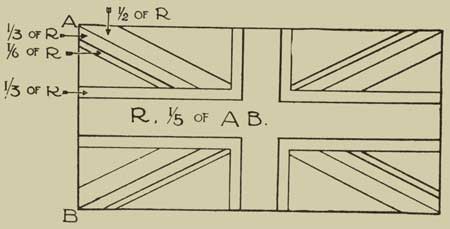
(From a photograph taken at the spot.)
At first sight it would appear that the "broad white of St. Andrew" was given a larger proportion of the flag, but the measurements of the "cross" and its "border" of the Scotch Jack are stated in one figure, because their colours are the same, while those of the Irish Jack are given separately, because the colours are different, the cross being red and its border white.
The saltire space of the Union Jack of Queen Anne has been divided equally, and the national banners of St. Patrick and St. Andrew are thus given each a proportion of one-third for its CROSS and one-sixth for its BORDER or "fimbriation."
The description given in the "blazon" respecting the red cross of St. George, stated that it was "fimbriated as the saltire." The regulations defined this as "for the white border to the cross of St. George," and there was allotted, not simply a one-sixth proportion due a "fimbriation," but the full proportion of one-third, equal to that of a national cross, and in this way the white border to the cross of St. George is as wide as the cross of each of the other nations.
The width of the border cannot this time, as was said of the change of 1707, be the result of the "carelessness of a draughtsman,"[134] for it is made with premeditated carefulness, and, more than that, the measurements are set down in exact figures. Thus the reason for the broadening of the border in the flag of 1707 has been justified by the flag of 1801 and its authority confirmed.
This broad white border, given to surround the red cross of St. George, is not only the formal recognition of the white ground of the English Jack, which had been placed in the flag of 1707, but it is also a recognition of the white ground of the Irish Jack, which was now for the first time entering the Union Jack, so that the broad border in the flag of 1801 represents the grounds of two national Jacks.
The practical proportions of the pattern drafts are[Pg 211] thus fully carried out in the Admiralty pattern. Some twenty years ago the Garter King of Arms had his attention drawn to the Admiralty flag as used in the navy, and he was asked to suggest an alteration. He declined, because, he said, "the flag was made according to the drawing, and it was exhibited in the same way on the colours of the Queen's Infantry Regiments."
It is a serious thing to deface or alter the national flag of a nation, and if any changes have been made in any individual instances they are the result of error, and have not been made with such paramount authority of Sovereign, Parliament and Council, as have been the Union Jacks of Queen Anne and King George III.
In this Union Jack of 1801 we have, then, plainly displayed a complete representation of the three separate crosses, and of the white and blue grounds of the three national Jacks which were then combined together to form our Union Jack.
Since 1801 no change had been made in this Union Jack of George III., which was the first three-crossed Jack of its race, and is our present Union Jack.
From 1801 onward dates this glorious flag, in which all three nations are represented. It was born when the power of Great Britain seemed almost wrecked. Reverses had accumulated upon her. In America many of her possessions among the West Indies and on the surrounding coasts[135] had been[Pg 212] wrested from her flag, and thirteen of her longest established and most populous colonies, becoming the United States, and aided by men, money and fleet from the French in Europe, had revolted from her sway and abandoned their allegiance. In Europe the nations of France, Spain and Holland were united in arms against her, and she was battling almost single-handed against the power of the great Napoleon; yet, undaunted by these trials, the sons of the united nation ran their new Union Jack up aloft, and started out to frame that marvellous career which it has since achieved.
This third Union Jack flew at Aboukir when Abercrombie drove Napoleon out of Egypt; with it were won the triumphs of Wellington, from Assaye in India, through Badajoz and Spain, to the crowning victory at Waterloo. It was the flag which floated in the "white ensign" on all the ships at Trafalgar,[137] and on the Victory when Nelson sent aloft his British watchword:
"England expects every man will do his duty."
The halo of that signal shone around it at Bala[Pg 213]clava, when the heroes of the valley-charge proved it was
and again above the Birkenhead, at sea, when five hundred steadfast men went down beneath its folds, inspired by its duty-call.
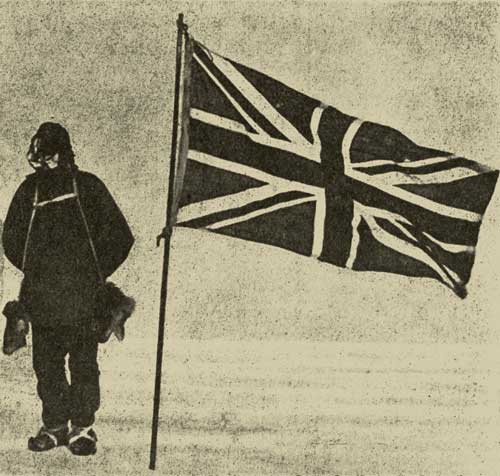
(From a photograph taken at the spot.)
In Africa, Melville and Coghill wrapped it around[Pg 214] their bodies at Isandula, and won death to save it from the foe; for it the forty mounted riflemen of Matabeleland died in their tracks, singing "God Save the Queen," and yet again at the call of the race the sons of the Flag from all around the world hastened to help it to hold its own upon the veldt.
On the continent of America the impetuous Brock, facing enormous odds, and leading his Canadian volunteers in defence of their native land, gave up his life for it on the cedar-clad slopes of Queenston Heights, and beneath it the French Canadians of Beauharnois knelt on the battlefield, and rising, won, with the brave De Salaberry as their leader, the victory of glorious Chateauguay.[138]
It was carried far to the Arctic north by Sir John Franklin, in 1846, and in October, 1908, Shackleton planted this ancient Union Jack, with all its crosses and broad white border,[139] upon the farthest Antarctic south (52).
Such a flag with such a history should be held sacred and inviolable.
THE LESSONS OF THE CROSSES.
The combinations of the Jacks have at length been completed, and the three crosses placed together in the one flag of 1801.
If some of the heralds are not entirely satisfied with the way the divisions are made, due honour has at least been done to each of the Jacks of the three kingdoms, while at the same time the historical value of the "Union" has been greatly enhanced, and its beauty as a flag most certainly increased. If the object of heraldry is the teaching of lessons by the combinations of colour and of forms, then the flag as made is yet more heraldically successful.
In the heraldic and traditional interpretations of colours, red indicates courage, white is the emblem of purity, and blue the emblem of truth.
By this better and more equal division of the colours in the flag much additional emphasis is given to the story which those colours tell.
Lessons are taught which may be deeply impressed upon the minds of our children, so that by reading the history of their nation in its folds they may endeavour to live lives worthy of the ideals of their[Pg 216] national flag, and frame their own characters and the character of their empire by its lofty teachings.
That it is a beautiful and easily distinguished flag is admitted on all hands, but it has the still further quality, of immeasurable value in a national flag, that its parts and colours tell the history of the nation whose emblem it is. To those who have acquainted themselves with the story of the three separate national flags, the Union Jack, with its three crosses, its broad white borders and eight blue triangles, tells the story of the influences under which the present Empire has been built up by the three kingdoms which were combined to make it.
Laid broadly upon the whole combination, and "surmounting" it, and also forming the basis for all its measurements, is the plain red cross of St. George, indicating, in such a way as the simplest mind can understand, the leading part which the English nation has taken in the creation of the Union, and the powerful position which it holds in its councils.
Under this cross, and supporting it, are the white and red crosses of the two junior nations, which are themselves, in their turn, supported on the white and blue grounds, which form the basis foundations of the flag, the whole being embraced and bound together by the broadspread arms of the plain red cross.
Thus clearly does the position of the crosses and their grounds teach the vivid lesson of how the three sister nations, supporting each other, are all united by Courage in building their realm upon the sure foundations of Purity and Truth.
The position of the red cross of St. George, in front[Pg 217] and full view, tells plainly how England was the first of the nations to enter the lists and lead the way in acquiring the glories of the Empire.
Another lesson there is which the crosses also plainly tell respecting the relations between the Scotch and Irish nations themselves.
The flag is divided by the cross of St. George into four quarters, in all of which the saltire crosses of St. Andrew and St. Patrick, as the heraldic blazon of the proclamation says, are "quarterly per saltire counterchanged."
Discussions have arisen between heraldic experts as to whether the descriptive word in the blazon should be "countercharged" or "counterchanged." The latter is the word given in this proclamation, and although at first sight it looks as though the red cross only had been "charged"—that is, been placed upon the original white diagonal cross—it is to be remembered that the saltire cross has been equally divided between the two nations.
It will be noted that the broad white of the cross of Scotland occupies the higher position in the first and third quarters, which are next the flagstaff, and the red cross of Ireland is in the higher position in the second and fourth, which are the quarters at the end or fly of the flag; the relative position of the Irish and Scotch crosses, as they are placed in the first and third quarters, are reversed in the second and fourth quarters; that is to say, the positions of the crosses are alternately changed about, or "counterchanged."
The quarters of the flag next the flagstaff are considered to be of higher importance than the others,[Pg 218] and in these more important quarters the cross of St. Andrew and its border is thus given precedence over the red cross of St. Patrick and its border.
The lesson intended to be taught by the position of the crosses is plain. The kingdom of Scotland had entered into the union with England before the kingdom of Ireland, and, therefore, as being the senior, the white cross of St. Andrew is given the precedence over the red cross of St. Patrick, but this, in its turn, is given the upper position in the remaining quarters.
The utmost care must, therefore, be taken to see that the Union Jack is correctly raised on the flagstaff, with the broad white of the St. Andrew uppermost.
When the Red Ensign, or any similarly quartered flag, is reversed on the flagstaff—that is to say, displayed with the Union down—it becomes a signal of distress. Union Jacks are often seen hoisted upside down (Pl. VII., fig. 1). No more distressing act can be done to the Union Jack than to thus carelessly reverse its crosses by putting the wrong end next the staff, with the broad white saltire down, nor greater indignity be done to its supporters than by thus reversing the correct positions of their national Jacks.
Flags are sometimes to be seen (Pl. VII., fig. 2) in which the white border around the red cross of St. George is reduced to the same narrow size as the border of St. Patrick, and thus the white ground of the Jacks of England and Ireland has been wiped out.
PLATE VII
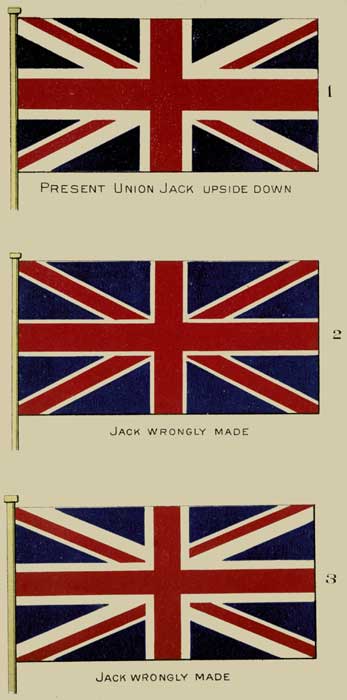
| 1 Present Union Jack upside down |
| 2 Jack wrongly made |
| 3 Jack wrongly made |
Still more often the red cross of St. Patrick is set full in the centre of the diagonal cross, and thus the cross of St. Andrew is completely expunged, for its white is reduced to only two narrow white margins[Pg 219] on both sides of the Irish red cross. The broad white of St. Andrew has thus been entirely lost. (Pl. VII., fig. 2).
Such errors as have been mentioned cannot be too greatly lamented, or be too carefully avoided, for by them dishonour is done to the memory of the nations whose prowess has ennobled their national emblems, and the beautiful story of the Union Jack is utterly marred; for the positions of the crosses and borders cease to tell the consecutive history of the empire nation whose combined union emblem they form.
In Pl. VII., fig. 3, a further error will be noted, that the opposite ends of the combined saltires are not in continuous line with one another, as in the correctly made Jack (Pl. V., fig. 3). This has occurred from the centre lines of the combined saltires having been drawn directly from the inner corners of St. George to the outer corners of the oblong flag.
We have seen that as the space of the one saltire of 1707 was to be divided equally between the two saltires of 1801, the two ends of the saltire should be in line, and the division run equally through the centre.
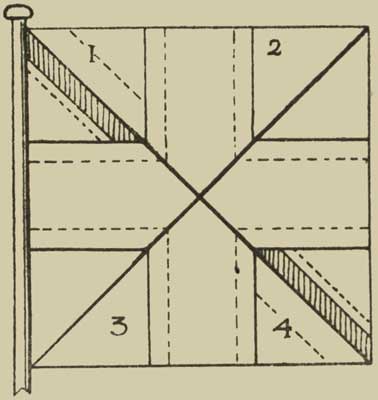
In view of these errors it may be well to give some simple instructions by which the flags may always be[Pg 220] correctly made, and which are in accordance with the Admiralty regulations.
Union Jacks must be made either square (53), or oblong (54), in which latter shape the length must always be twice the width on the staff.
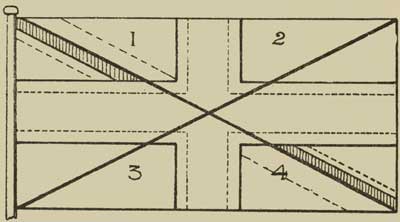
It will be noticed that in the square Jack (53) the diagonal lines drawn from the opposite corners of the flag intersect the corners of the white border of St. George and of the cross, which latter is shown in dotted lines, and that in the oblong Jack (54) they do not. It is this difference which has usually created the difficulty.
Having decided the size, either square or twice as long as wide (1 × 2), then draw two diagonal lines from corner to corner upon the shape of flag selected, then place the St. George cross and its border upon the flag according to the measurements in the "Outline Jack" (51), the red of St. George being one-fifth of the height or width of the flag. The diagonal lines will be the centre and dividing lines of the[Pg 221] saltires, as shown by the dotted lines which are thus in continuous line from one corner to the other. The St. Patrick and St. Andrew saltires and their borders are then to be added according to the proportions shown in (51), the red saltire being placed touching the diagonal, below it in the first and third quarters of the flag, and above it in the second and fourth. The St. Andrew, being in one colour and above the diagonal in the first and third, and below it in the second and fourth, completes the combined saltire.
By following these directions the making of a Union Jack is much simplified.
That the utmost care should be exercised in the making of our flag is beyond all question. It is the record of our history, the flag of our British nation; to display one in incorrect form is to do dishonour to it, to our history and to our nationality. No patriot would do this intentionally, and yet some may do this ignorantly. It would be well for their help and the avoidance of error that they should be taught how to make their flag correctly, and be educated in the lessons which it conveys.
Once these have been learned, the amount of increased interest in our flags is immeasurably advanced. Each flag as it comes before the eye becomes a study and a lesson, an historic reminder and a patriotic inspiration.
If those crosses could themselves but speak, what glories they could tell; and yet the outlines of the flag, when they are properly displayed, signal the stories of their colours and their crosses as plainly and as eloquently as if they voiced it in burning words.
THE PROPORTIONS OF THE CROSSES.
The division of proportions allotted to the crosses and to the white border of St. George in the Union Jack has hitherto been treated solely by inference and also by comparison of the "drafts" selected and regulations which were issued for the construction of the flag. It may be well now to revert to some actual examples showing the details of flags early in use, which will further substantiate the reasons which led to the proportionate division of the spaces when the Union Jack of 1707 was altered in 1801, and our present Union Jack was designed to record the addition of Ireland to the Union.
It has sometimes been stated that the red cross and white border of St. George indicate the presence of two crosses, the impression, formed by those who, as they admit, were "better acquainted with heraldic definitions than historic expression," being that they give the appearance of a red English cross placed over a white French cross.
As reason for this, they point out that King James I. and all his successors until King George III. had been styled "Kings of Great Britain, France and Ireland." The successive Union Jacks had been created during the existence of this royal[Pg 223] title, and, therefore, it is suggested that two crosses had been placed upon this part of the flag, one being the white cross of France, upon the face of which the red cross of St. George had been laid to thus present the ancient and long-past union of the kingdoms of France and England under the one sovereignty.
The white cross of France, however, was not a straight-sided cross, such as that of St. George, but one of Maltese shape, being wider at the ends than at the centre.
An instance of this flag is given in the copy (55) of the flag shown on the mainmast of a French caravel of the sixteenth century, as drawn in an old manuscript illustration.[140]
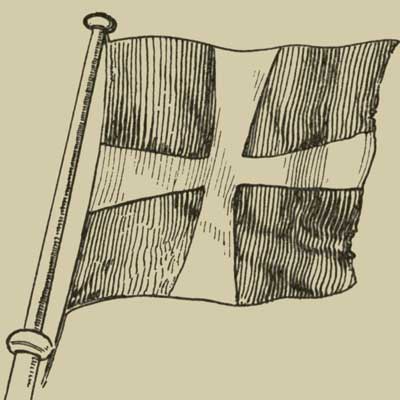
It is quite evident that the rectangular white border to the St. George could not be formed by a cross of this shape, and, therefore, this suggestion for the origin of the white border must be taken as erroneous.
Further, it was not unreasonable, seeing that the Royal Standard is composed of the personal arms of[Pg 224] the sovereign, that the successive kings and queens of England should have continued the fleur-de-lis in one of the quarterings of their royal arms, as a sign of family succession, and as evidence of personal claim by descent to the old sovereignty of France; but the British nations brought into union did not themselves claim any such sovereignty, Calais, the last foothold of England in France, won by Edward III. in his claim to the succession of the throne of France, having been lost in 1558 under Queen Mary. There would, therefore, be no corresponding reason for inserting the French cross in the union flag, nor any historical connection which would justify its being so used.
In the illustrations given of the two-crossed Jack of 1606 (Pl. III., fig. 2, and cut 16), the white saltire of St. Andrew is represented as of the full size of a wide saltire cross; so also in the Jack of Queen Anne, 1707 (Pl. V., fig. 1), in which the broad white of St. George was first given its full width.
This is the proportion of size which is given to it in heraldic drawings, and the way in which it is usually drawn in later representations, the white saltire cross of St. Andrew being thus shown broader than the white border to St. George; but the earlier practice in the actual making of flags appears to have been different.
In the allotment of the proportions in the new three-crossed Jack of 1801, when the cross of St. Patrick was added to the flag, it has been pointed out that the white border to St. George was continued in its full width, as in the previous flag of 1707, and[Pg 225] was given the same width as each of the two national crosses, which were then first placed side by side, and between which the saltire space was then divided.
It will be interesting to show, by reference to early original documents and flags, that this was the same equality as had previously existed between the cross of St. Andrew and the border of St. George in the old two-crossed Jacks of James I. and of Queen Anne.
In the time of William III. it appears that objections had been raised in England to the using of the King's two-crossed Jack by merchant ships of the American colonies, permission to do this having been granted to the colonial ships by the Governors of the colonies.
The English Lords Justices in Council at Whitehall, on 31st July, 1701, considered these objections to the using of what their report termed "the King's Colours," and thereupon issued an order that the ships of the colonies shall
"wear no other Jack than that hereafter mentioned, namely, that worne by His Majesty's ships, with the Distinction of a White Escutcheon in the middle thereof, and that the said Mark of Distinction may extend itself to one-half of the depth of the Jack, and one-third part of the Fly thereof, according to the sample hereunto annexed."
The Lords Commissioners of Trade were accord[Pg 226]ingly instructed to write to the Governors of His Majesty's plantations,
"that they do oblige the commanders of such merchant ships to which they grant commissions to wear no other Jack than according to what is proposed."
An exact tracing of the "sample hereunto annexed," taken from the original manuscript report,[141] which was sent to the then Governor of the colony of Massachusetts, is shown in fig. 56, and in colours in Pl. III., fig. 3.
This flag is the Jack of James I., which is still described in this report of July, 1701, as it had been of old, as the "King's Colours." It will be noted that the white cross of St. Andrew is a narrow cross, and that the white border to St. George is of the same width as the St. Andrew's cross.
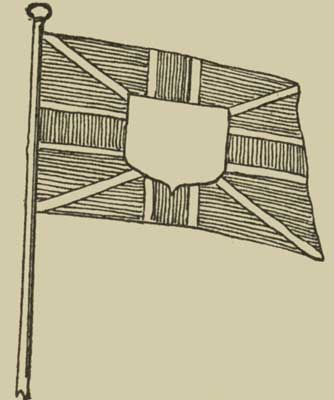
In the centre of the Jack is the "white escutcheon" described in the report, to be used on the colonial flags. This is the first instance of the creation of a special flag for the overseas colonies, and reference to it will be made in a subsequent chapter. Similar[Pg 227] instructions were sent to the Governor of the colony of New York in 1709, and the flag is repeated with an escutcheon in the same form.
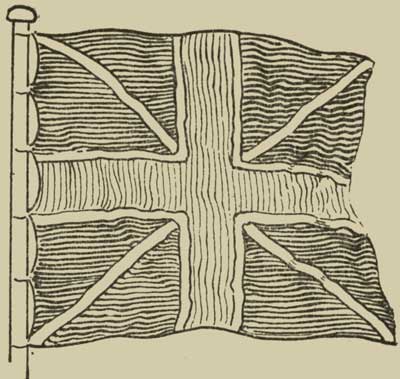
(From an old Dutch sheet of flags.)
A coloured sheet, "Schouw-Cart Aller Scheeps Vlaggen" (Examples of all ships' flags), was published in 1711 by P. Schenk, at Amsterdam, "correcting errors in previous editions." In an old atlas[142] of maps, which were bound together in "old Amsterdam," in 1763, there is included one of these sheets. Among the flags represented on it is the "Jack of England" (57), showing the white of St. George of the same width as the St. Andrew's cross.
References to many drawings of Union Jacks, as used on the American side of the Atlantic, show similar proportions, of which some examples may be given.
Fig. 58 is a copy of the Jack on the bowsprit of a three-masted ship shown in a large three-sheet engraving, entitled "A Prospect of Charleston, Carolina," published by R. Roberts, June 9th, 1739.[143]
On page 187, a view of the port of New York (44)[Pg 228] shows the flag as used in 1770. Both on the ship and on the King's fort is the narrow St. Andrew.
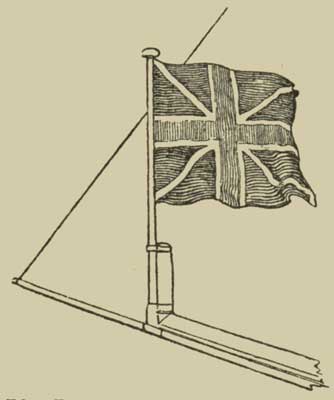
Fig. 59 is a portion of an old engraving of the combat between the French frigate, La Surveillante, and the English frigate, Quebec, 6th October, 1779.[144] This was one of the most gallantly contested actions of the many engagements between single ships during the progress of the war. The two frigates met in the English Channel, and flying at one another at sight they battled hand to hand. All their masts had been carried away, both ships were on fire, more than half of the crew on either side had been killed or wounded. All the boats except one on the French ship had been destroyed, when the Quebec blew up, and Captain Farmer, her commander, went down in her with nearly all who were left alive of his crew. The French captain, de Coudic, who was himself severely wounded, received the forty-three survivors, with a seaman's gallantry, on board the Surveillante, saying that "as their ship had perished with her colours flying, they would be treated, not as prisoners, but as brothers rescued from shipwreck."
The white flag with the fleurs-de-lis is at the stern of the French ship, and at the stern of the English[Pg 229] ship is the red ensign on which the St. Andrew cross and the white border of St. George are still shown of equal width.
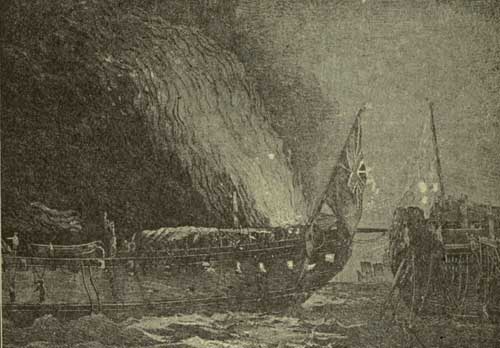
In addition to these instances from illustrations, reference to actual flags of these early periods, and which are still in existence, proves that the Union flags carried by regiments of the British army were made on these same proportions.
The drawing (60) is reproduced from a photograph of the King's colour of the 7th Royal Fusiliers, which is stated to have been obtained at the capture of Fort Chambly, in 1775, and is now deposited in the chapel[Pg 230] of the United States Military Academy at West Point, New York, and shows its present appearance.[145]
A further example is given in the drawing (61) made from a regimental flag[146] surrendered by the British forces at the capitulation of Yorkton, by Lord Cornwallis, on 20th October, 1781. This is the "King's colour" of one of the British regiments. These flags had most probably been given to the regiments at much earlier dates, and had still continued in use. In both the cross of St. Andrew and the border to St. George are of the same width.
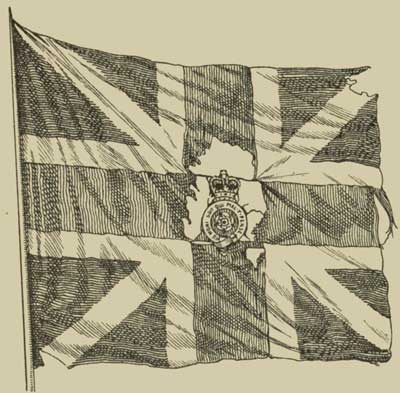
These instances could not all be incorrect, and their similarity shows that the form and proportions of the Union Jack of James I., as given in the Massachusetts document, were those which were subsequently used in the actual flags officially displayed at sea and on shore.
In all these Union Jacks the white of St. George is[Pg 231] of the same width as the cross of St. Andrew, and from these evidences of the form of the flag, derived from such varied sources, we may fairly conclude that the allotment to the white border to St. George in the Union Jack, of a proportion equal to that then given to a national cross, had not only early authority, but also wide usage.
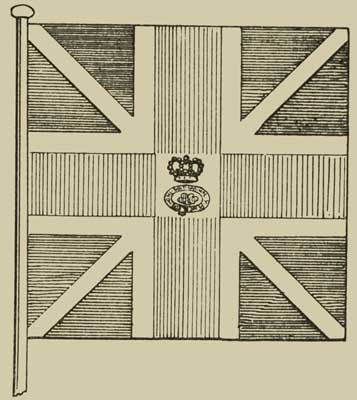
These were two-crossed Jacks. When the time came, in 1800, for the construction of the three-crossed Union Jack, the designers of the "draft" and the committee of selection would have been acquainted with the details of those previous flags. It is, indeed, stated that the various existing flags were submitted for their inspection. When, therefore, they gave the broad white border to St. George the same width as that of each of the crosses of St. Andrew and St. Patrick, namely, as the instructions stated, one-third of the red cross, they were only continuing the width and proportion allotted to it in the Union Jacks which had preceded, and with the actual examples to which they were accustomed.
The broad white of St. George, as we now see it, was not dependent upon any heraldic description, but is an heirloom of national descent, and was evidently continued by the designers of 1801 in its full proportion of the Union flag, not only to represent, as previously, the white ground of the English Jack, but also for the additional reason that it represents the white ground of the Irish Jack, which they were then adding to the Union flag. By this method the proportionate representation of the Jacks of the three kingdoms was intended and justified.
Another objection raised to the proportions of the present flag, by those on the side of the heraldic interpretation of the "blazon," is that the individual crosses are of less width in proportion to the size of the flag than they should be according to heraldic rules, and that, therefore, the dividing of the flag is incorrect.
We need again to be reminded that the flag makers were not simply placing three "crosses" upon a single flag, but were joining three "Jacks" into one Union Jack; yet it may be satisfactory to see that in the doing of this they have really fulfilled the rules of heraldry.
According to the received rules of strict heraldry, in emblazoning a shield or a banner, a cross should be given one-third, and a saltire be given one-fifth of the width. On a shield this measurement of width is taken across the top, and on a banner or a flag it is measured perpendicularly along the flagstaff.
Applying this rule and measurement to our present Union Jack, and taking, as in fact they are, the red[Pg 233] cross of St. George and its two borders as one cross, and the two saltire crosses of St. Andrew and St. Patrick and their two borders as one saltire, we shall find that the heraldic rules have been actually complied with by the official "draft" and by the regulations (Fig. 51), and that the combined cross is one-third, and the combined saltire one-fifth, of the width of the flag.
Sizes of the Crosses according to the Admiralty Regulations.
| One Combined Cross: | ||
| Red cross of St. George, 1/3 of 3/15 | width | 3/15 |
| Upper white border, 1/3 of 3/15 | 1/15 | |
| Lower white border, 1/3 of 3/15 | 1/15 | |
| 3/15=1/3 (one-third.) | ||
| One Combined Saltire: | ||
| Red of St. Patrick, 1/3 of 3/15 | 1/15 | |
| White border of St. Patrick, 1/6 of 3/15 | 1/30 | |
| Broad white of St. Andrew, 1/2 of 3/16 | 3/30 | |
| 6/30=1/5 (one-fifth.) |
It may be convenient to state these proportions as they would be in a Union Jack, of which the width on the flagstaff is 5 feet:
| Red of St. George, 1/5 of 5 feet | 1 ft. 0 in. | |
| Upper white border | 4 in. | |
| Lower white border | 4 in. | |
| ——— | ||
| 1 ft. 8 in. | or 1/3 of 5 ft. | |
| Red of St. Patrick | 4 in. | |
| White of St. Patrick | 2 in. | |
| Broad white of St. Andrew | 6 in. | |
| ——— | ||
| 1 ft. 0 in. | or 1/5 of 5 ft. |
It is possible that this form of compliance with the heraldic rules was fully intended; yet, even were it not so, it is at all events a happy coincidence which might be taken as a conformity to these rules, and thus the flag which has been confirmed in its shape by the usage and glory of centuries should be cheerfully accepted by the heraldically inclined as being completely satisfactory.
It is not to the point for them to say it might look better if it were made some other way, for that would be merely a matter of opinion; or that if the heralds had had the making of it they would have made it differently, but it was not of their making, that having been settled by the Council in the selected draft of which the heralds worded a description, or, as some state, a misdescription; but it cannot fail to be admitted by all, that, as now made, it has been made, in all its parts, in the way ordered by the successive Councils, in whom authority was vested for its designing and issue.
The proportions of the crosses and of the borders of our Union Jack are thus not only technically correct, but, of still higher importance, they also preserve in detailed sequence the historical proportions of the three nations and of the three national Jacks, which were, in 1801, joined together in completed union.
Our noble flag, with its centuries of loyal history, might well, therefore, be held sacred and free from any objections on theoretical proportions.
UNDER THE THREE CROSSES IN CANADA.
In 1801 the "new" three-cross union had entered into the upper corner of the red ensign of British rule. The Canadians, both French and English, had been faithful to its two-crossed predecessor, and now again their patriotism was to be put to the test.
The parent kingdom of Great Britain had for nineteen years been engaged in its mighty struggle with the great Napoleon for the supremacy of Europe, and the time seemed opportune to a section of the people of the United States for gaining an advantage over the nation from which they had separated their allegiance, and also for striking a blow at the neighbouring people who had refused to become absorbed with them, and had so successfully resisted their previous invasion.
The quarrel was none of Canada's making, nor was it one in which she had any share, yet, although the ostensible reason which had been alleged as the cause of offence was repealed before hostilities had been commenced, war was declared at Washington on the 18th of June, 1812.[147]
The population of the United States at that time amounted to no less than eight millions, while in Canada, from end to end, there were but four hundred thousand souls, all told.
The Canadians did not hesitate, though their country was to be the scene of war, and their homes to be the stake for which the nations were to strive. Aid they could not expect from their British friends across the sea, already strained to the utmost in the long conflict with the armies of Europe; their reliance must be upon their own stout hearts and strong right arms. But this was enough, for
"Odds lie not in numbers, but in spirit, too."
So they rallied with eagerness beneath their Country's and Britain's Union flag.
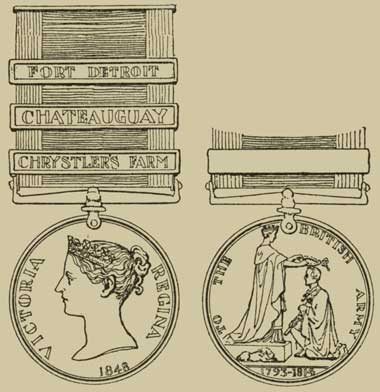
Only four thousand five hundred regular trained soldiers were in Canada in 1812, and in them are included men of the Newfoundland and Glengarry regiments, recruited locally in the colonies; and thus[Pg 237] the brunt of the defence was to fall upon the stalwart but untrained militia of the countryside.
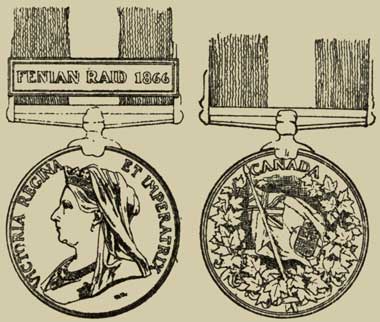
The tide of invasion advanced north against Canada from the United States. For three years, from 1812 to 1815, the contest went on. Our French Canadians again bravely took up their arms, and this time, under the new three-crossed Jack, again drove the United States invaders back, making the names of Chateauguay and Chrystler's Farm ring down through history in token of the victories which they won beneath it in defence of their Canadian liberties and homes. So, too, their English-speaking brothers of Upper Canada won equal victories for this same Union Jack. At Mackinac, Captain Roberts,[148] with his Indians and Canadian voyageurs, raised it above the captured American fort. At the capitulation of Fort Detroit to Brock and Tecumseh, the American soldiers laid down their arms before it, and all Michigan was surrendered. At Queenston Heights, under the glorious Brock, at Stoney Creek and Beaver Dams, Niagara[Pg 238] and Lundy's Lane, the American invader was sent in quick retreat from Canadian soil, and at the conclusion of the three years' war, after all the varying fluctuations in reverse and success between the contending forces, there was, at its end, not a foot of Canada, occupied or sullied by the foot of the foreign foe.
Thus all along their frontier shores, from Mackinac to far St. John, the Canadians stood shoulder to shoulder in one bold, united line, and held the larger half of North America for the British crown.
Again, when Fenian hordes and restless soldiers, who had been disbanded from the armies of the American Civil War, were assembled and drilled under the protection of the United States, and launched in raids against Canadian homes, the Canadian volunteers mustered around their Union Jack, and along the Niagara frontier, in 1866, and at Eccles Hill, in the Province of Quebec, in 1870, again drove the southern invader back, and held their native soil inviolate beneath its three-crossed folds.
Such was the British patriotism of which the flag was the Union signal, and now another parliamentary union is to be included in the career of the Union Jack in Canada.
Up to 1867 the Eastern British Provinces in North America had remained under separate local governments, such as had been established in the previous century; but in this year Nova Scotia, New Brunswick and Upper and Lower Canada were all united in the one "Dominion" of Canada, then extending only as far as Lake Superior. This "Act of Confederation" was passed in London, at Westminster, by the Parliament of Great Britain, and thus again the Union Parliament of the Union Jack was parent to a new Union Parliament established in united Canada. Each Province continues to have its own "Provincial Assembly," in which legislation is conducted on matters pertaining to its own local or home rule, but all general powers are centred in the Dominion Parliament of Canada. Hitherto the spirit of the flag had been solely that of union with the Mother[Pg 240]land; thereafter it had an added and local meaning, for it became also the symbol of Canadian union, the patriot flag of the new daughter nation which had thus been brought into existence in the outer British American realm. Inspired by this union, the older Provinces thus combined began to extend their borders, and soon Manitoba and the Hudson Bay Territories of the central prairies[150] were added, in 1869, and British Columbia joined in 1871, followed by Prince Edward Island in 1873, to make the enlarged Dominion of Canada, now stretching across the continent of America from sea to sea.
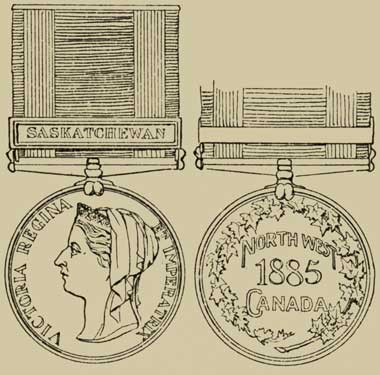
Difficulties, of course, were met in this consolidating of the territories, but the sign of Union was flying from the flagstaff, and the new-born patriotism surmounted them all. In March, 1885, when the spirit of discontent arose among the Metis of the North-West, and a rebellion broke out, the courage of the united Canadians was aroused with electric flash, and[Pg 241] the volunteer battalions from the Maritime Atlantic shores, from French-speaking Quebec, from the great Ontario lakes, and from all parts of the Dominion, vied with one another in bearing the privations of forced marches across the frozen lakes, or over the pathless prairies, to reach the scene of action, and join in maintaining the supremacy of their native union. The rebellion was quickly suppressed; but the events at Fish Creek, Batoche and on the banks of the Saskatchewan left gaps in the loyal ranks.
Three medals[151] have been granted by their sovereign to commemorate the gallantry of the Canadians who thus fought beneath the Union Jack: In 1812-15, for union with the Motherland (62); in 1866-70, for service in defence of their country during the Fenian raids (63); and in 1885, for union within Canada itself (64). Such are some of the events which have given rise to the stirring patriotism evinced by Cana[Pg 242]dians for their national flag, and which have kept aflame the passionate fervour of their loyalty not only at home, but when they joined hands in 1900 with their brothers-in-arms from British Isles and Colonies to fight and die for union in South Africa.
Four times within the century—in 1775, 1812, 1866, and 1870—have Canadians raised their Union Jack in defence of home and native land, and once, in 1885, for maintenance of union within themselves.
As Canadians see it waving above their school-houses, and on the ships, or over their homes, they read in the crosses the stories that they tell, and remember that the deep red tones in its folds have been freshened and coloured by the heart-blood of Canada's sons, poured out for it in ungrudging loyalty on their own loved soil. The sons of the parent nations have carried it in many a far-off strife, but in their own island homes, "compassed by the inviolate sea," they sleep secure, and never have had to fight beneath it in defence of native land. It is in this regard that Canadians can cherish this flag even more than they who first carried it, and their sons may now rightly wear it as their very own, for the Union Jack is so bound up with love of country, defence of home, and all that is glorious in Canada's history, that it is the union flag of Canada itself.
THE FLAG OF FREEDOM.
These stories of martial and constitutional advance are not all the story that this Union Jack tells. There is something more than mere valorous devotion which should be aroused in the expression of loyalty for a flag. Such a devotion might be found even under a despot's sway, for racial and reckless valour may, with some, take the place of thoughtful allegiance.
The story of an ideal flag should declare a supreme idea, an idea which has been so well expressed as being the "divine right of liberty in man. Not lawlessness, not license, but organized institutional liberty—liberty through law, and law for liberty."[152]
When a flag records, by the unmistakable story of its life, how this desired freedom has been not simply alleged, but granted in actual fact to all who have reached the soil of its dominion, and, further, tells how the amplest dream of self-government is realized by those who dwell beneath its sway, then, indeed, is that flag to be cherished with the most passionate devotion, and valued in the most critical estimation.
Such a flag becomes an inspiration not only to[Pg 244] the heart, but to the mind, and men may well be willing to risk their all, and life itself, for the maintenance of its unsullied honour. Such a flag is the Union Jack in Canada.
This three-crossed Jack in Canada is not only the national ensign of the British race, but it is more, for Canadians have made it the real "flag of freedom in America."
It is the proudest ascription of the Union Jack of the Empire that
This fact is true to-day of the Jack throughout all the British territories, but it has not always been so, and we may, with much interest, trace the condition of the slave under the flag in Great Britain, in the Colonies, in the United States, and in Canada.
It has been the happy lot of the Motherland, the cradle of the liberties of the earth, that freedom has been enjoyed for many centuries upon her own home soil; but even there legal doubts existed until 1772 about the position of persons who, being slaves in other lands, had reached her shores, when the notable decision of Lord Mansfield declared that, "When a slave has landed on the soil of the British Isles that slave is free." Although this legal definition had been reached, the abolition, by statute, of slavery under the Union Jack was not enacted by the British Parliament until 1811; and even after that, as this Act did not apply outside the British Isles, slavery continued in the outer realms to such an extent that[Pg 245] in 1820 there were no fewer than 340,000 slaves under British rule in the Island of Jamaica alone.
At last, in 1833, the glorious Act of Emancipation was passed by the British Parliament, and the same freedom which had existed on the soil of the parent kingdom was extended to all races who lived anywhere under the Union Jack. The people of the parent isles gave further proof that this was done, not solely in the pursuit of an ideal, but out of real good-will, for they were not content with proclaiming freedom to the slave, but themselves purchased his emancipation by paying one hundred million dollars to his owners in those colonies in which, up to that time, slavery had existed with their consent. In the true spirit of British fair-play they thus scouted the idea of exercising their own compassion and good-will at any other person's expense.
| Number of Slaves. | Indemnity paid. | |
| Jamaica[153] | 311,700 | £6,152,000 |
| Barbadoes | 311,700 | £6,152,000 |
| Trinidad | 83,000 | 1,721,000 |
| Antigua, etc. | 172,093 | 3,421,000 |
| Guiana | 84,900 | 4,297,000 |
| Mauritius | 68,600 | 2,113,000 |
| Cape of Good Hope | 38,400 | 1,247,000 |
| ——— | ——— | |
| Total | 780,993 | £20,000,000 |
Such has been the story of freedom under the Union Jack on the other continents. Let us see how its history compares with that of other flags on the continent of America.
The stories of the flags of Mexico and the republics of South America are so changing and unsettled that they may not be counted in the consideration, and the flag of Spain in Cuba never became an exponent of freedom. The sole competitor for the title of "the flag of the free" is the Stars and Stripes of the United States of North America.
The thirteen colonies of North America were, at the time of Lord Mansfield's decision in 1772, colonies of the British crown, and moved, no doubt, by a desire to emulate their brothers in Great Britain, and following their example, the representatives of the colonies met at Philadelphia, on 27th September, 1774, and in Continental Congress "declared against the slave-trade, and forbade any further importation of slaves into British America." Being supporters of the Union Jack, and following its ideals, they made, as Britons, a first step in the right direction, but no freedom was given to those already in the country.
It was, no doubt, under the influence of this spirit of British freedom, and with British hearts, that, when they were separating from their British allegiance, they stated in their Declaration of Independence (4th July, 1776):
"We hold these truths to be self-evident, that all men are created equal; that they are endowed by their Creator with certain unalienable rights; that among these are life, liberty and the pursuit of happiness."
Yet at the very time when this claim was made, that all men were born equal, well-nigh a[Pg 247] million blacks were held in these same States in bondage,[154] and this sounding declaration of "liberty" did not bring freedom to a single slave.
Indeed, when, eleven years afterwards, in 1787, the representatives of the thirteen States met[155] in federal convention, and adopted the "Constitution of the United States," the existence of slavery under the Stars and Stripes was recognized and its continuance guaranteed.
The framers of the constitution were evidently conscious of the fact that the statements of their "declaration" were not in actual accordance with their actions, and therefore the provisions in their "constitution" concerning slavery were stated in a veiled and secret form, the words "slave" and "slavery" being carefully excluded. In this way the clauses of the American constitution have a different interpretation from that which their wording would apparently convey, for the existence of one class of their population in slavery was duly recognized, although not specifically mentioned.
The leaven of English freedom evinced in 1774 had continued to work among some of the States, even after their separation from the Crown, and emancipation had been begun in Vermont in 1777, in Pennsylvania in 1780, and was impending in some of the others, but had by no means been accepted in all.[156]
In arranging the proportionate representation of the several States in the union congress it became necessary to apportion the number of members of congress to be elected by each State, and in arranging this representation a concession was made to the slave-owning States whereby their slaves were to be recognized in estimating the number of their population.
The Article[157] enacts:
"Representatives shall be apportioned among the several States which may be included within this union according to their respective numbers, which shall be determined by adding to the whole number of free persons, including those bound to service for a term of years, and excluding Indians not taxed, three-fifths of all other persons."
By the apparently simple but very pregnant words, "all other persons," of whom three-fifths were to be added, were meant the slaves, who, although they were not themselves accorded any citizenship or right to vote, were thus counted in determining the number of the representatives who were to be accredited to and elected by the State in which they were held in slavery.
As slavery was, in 1787, legal in some of the States and illegal in others, it also became necessary, in order to gain the acceptance of the union by the slave-owning States, that provision should be made for the[Pg 249] legal return to their owners of any slaves who might escape from a slave-owning to a free State, and a clause guaranteeing the rendition of fugitive slaves was therefore embodied in the constitution. It was enacted:
"No person held to service or labour in one State—under the laws thereof—escaping to another shall, in consequence of any law or regulation therein, be discharged from such service or labour, but shall be delivered up on claim of the party to whom such service of labour may be due."[158]
It is stated on the authority of Madison,[159] "the father of the constitution," that the words used in each case in the original drafts of these clauses was "servitude," but it was afterwards changed to "service."
The expulsion of the words, although it might appear better to the eye, did not alter the fact that the whole of the States, which then framed their Union, although they did not all practise slavery, yet every one of them then consented to its perpetuation. Thus it came that slavery existed legally under the Stars and Stripes from 1787 until 1865, when happily it was terminated[160] by the proclamation of Lincoln and the constitutional amendment.
Such is the story of the slave's "freedom" under the national flag of the United States.
We may now turn to the story of his freedom under the Union Jack in Canada.
We have seen that slavery, excepting on the soil of Great Britain, was not abolished in all other parts of the British Empire until 1833, and not in the United States until 1865. In 1792, long before either of these dates, self-government had been granted to Canada, and, under the two-crossed Jack, at the first meetings which were held by the parliament in Upper Canada, slavery was abolished on July 9th, 1793.[161] This was before our present Union Jack came into existence, so that in Canada alone, of all the outer lands over which this flag of 1801 has ever been raised, beginning from the very day on which it first was displayed, this three-crossed Jack has always, as in the Motherland, proclaimed freedom to the slave.
Canadians in this way feel added honour in the flag, and that it is more particularly their own; for on the continent of America, whether he came from the British West Indies, from the southern continent, from Cuba, or the United States, in all of which he was still the chattel of his owner, so soon as the slave reached the soil of Canada, and came under the colours of our Union Jack, that moment he was free.
The deep significance which this early law of Canada had given to the flag has often been attested by coloured men before their fellow-citizens and the[Pg 251] world, and particularly by Frederick Douglas, the great coloured orator of the United States. While dilating upon the great advantage which had come to his own people since freedom had at last been granted to them in the United States, he would nevertheless contrast their condition with that existing in the neighbouring Canadian land, where the black child sits in the public schools by the side of his little white brother, and travels with him in the same carriage on the trains, and where the law is administered with impartiality for both white and black alike.[162]
In telling words he would revert to the time "when there was but one flag in America under which the fugitive slave could be secure. When the slave had escaped from the control of his owner, and was making his way through the intervening States to the free land of the north, whether he gained the summit of the highest mountains or hid in the recesses of the deepest valleys, the fugitive could find no safe resting place. If he mingled in the teeming throngs of their busiest cities, he feared detection; if he sought solitude on their widest prairies, beneath the silent stars, he was in dread of being tracked; not until he had sighted the red-crossed Jack, and, crossing the northern lakes, had touched the strand of Canada's shore,[Pg 252] could the slave fall upon his knees and know that at last he was free."
Thus pure, unsullied in its life-story, this three-crossed Union Jack of Canada is the only flag on the continent of America which has always and ever been the "flag of freedom," a flag under which all men, as their birthright, have been born equal and free.
Canadians may well, therefore, be proud of their flag, for what truer glory can be claimed for any other flag—than this, which spells out FREEDOM in its every fold?
THE FLAG OF LIBERTY.
There is yet the other ideal phase in which the Union Jack in the outer realms of the Empire and in Canada reigns supreme—that of "liberty to the people." The inborn hope which buds and blossoms in the hearts of a growing people as their energies evolve and their circumstances advance, finds its fruitage in the possession of mastery over their own homes, and thus a nation's desire for liberty is concentrated in the absorbing dream of self-government.
It was this spirit which spoke in the old English colonies in America when they averred, in their address to King George III., that they were "being degraded from the pre-eminent rank of English freemen." The condition of a citizen in the old homeland was their highest ideal of the liberties of a people, and the only one with which, even in those times, they considered comparison could worthily be made.
The history of the Union Jack in the parent land has been connected, as we have seen, not solely with national allegiance, but yet more with parliamentary government; and its several parts have been combined[Pg 254] in union to evidence the advent of union under representative institutions.
Such, too, has been the history of its expansion among the great groups of colonies of the British Empire which dot the outer world, a development of true democratic government which can best be realized by a comparison between the forms of government in Canada and that in the United States.
The creation of the constitution of England was not confined to a single date, nor was it the product of the men of a single period; its growth has been spread, like that of its flag, over century after century, as each successive phase of the ideal dream has become harmonized with the existing requirements of the day. Formed largely upon usage and upon precedent, it reflects the current views of the people, and, therefore, has never been restricted to invariable forms of words.
There are milestones such as Magna Charta, the Petition of Rights, the Habeas Corpus Act, the Act of Settlement, and the other landmarks which measure the way towards constitutional liberty; but as with the Union Jack, so, too, with the liberties of the British form of government, the story of the combinations is not the record of a revolution, but the gradual process of a reasoning evolution.
When, at the end of the eighteenth century, our neighbours in the United States framed their new constitution, they based it on the information and usages of that day when responsible government was almost unknown. Creating an elective King under the name of President, they endowed him with distinct and[Pg 255] executive powers, which, as then, he still exercises, largely of his own private will, or only in consultation with a Cabinet which is nominated by and is responsible only to himself, whose members are not members of the House of Representatives, nor are they elected by the people.
How entirely he acts of his own motion, without the instructions or the initiation of Congress, was only too evidently shown in the recent Venezuela-Guiana incident,[163] when President Cleveland's message was promulgated with all the individual vehemence of an autocrat, and if it had not been for the temperate forbearance of the British Cabinet, war would have resulted.
The President of the United States, having been elected for a definite term of years, represents the opinion which prevailed at the time of his election; and no matter how much the opinion of the nation may change in the interval, or his policy be objected to, he continues to rule until his allotted term of four years shall have expired, even though he and his Cabinet be in absolute conflict with the expressed will of the people, as indicated in the elections which are constantly in progress.[164]
It is true there are provisions in the constitution[Pg 256] for checking his course, or for his impeachment, but in cases in which this has been attempted to be enforced the trial has lasted longer than his term. His appointment as chief of the nation having been the result of an election contest, the President represents not the whole people, but only the political party which happened to be in the majority at the time of his election.
Being, then, the elected representative of a definite political party, his acts are expected by those who have elected him to be used towards continuing their party in power, and thus the person from time to time holding the position of President becomes a distinct vehicle for the exercise of party political warfare instead of being an impartial administrator.
His veto being thus supreme, all legislation has to be conducted with a view to what will meet, or will not meet, the personal views of the President, as has been most plainly shown in the framing of Tariffs for Customs and Taxation.
This written constitution of the United States, admirable though it may have been thought at the time, and an improvement upon the then existing state of things, was born over a century ago, in the times of autocratic government, and though thus out of date, it has remained ever since practically unchanged; in fact, with the exception of the amendment respecting slavery, it is identically the same.
During this same hundred years, as civilization has advanced, education enlightened the masses, intelligence expanded among the people, and experience been gained, there has grown up that marvellous form[Pg 257] of self-government under which we Canadians and our brother colonists live—the British Constitutional Monarchy. In this British Empire, in the colonial parliaments, as in the Imperial Parliament, the King or Sovereign represents all the people, not a party, and is the permanent chairman of the nation. The will of Parliament, tempered by his continued counsel, is his will. The ministers of the Crown, who, with the Premier as their head, form the Executive, are elected by the people, and sit in the same House of Commons with the other elected representatives. Debating with them on the issues of the day, they are responsible to their fellow-members for the measures which they introduce;[165] and when they fail to carry these measures, and cease to secure the support of the majority of the people's representatives, as then sitting in Parliament, the ministry must resign, and is succeeded at the call of the sovereign, or in a self-governed Dominion, of the Governor-General, by another Cabinet, which shall represent that majority; or, should the matter be considered of sufficient importance, the whole Parliament is forthwith dissolved by the Sovereign, or his representative, as the neutral and unbiased centre of impartial power. All the members return for re-election by their constituencies, and the question at issue is quickly submitted for decision by the ballots of the electors. Thus the acts of the Premier or chief minister, and of his Cabinet, and also of the party of which he is leader, and the[Pg 258] whole Parliament, are at once subject to the opinion of the people without waiting for the completion of their term.[166]
Further, indeed, than this, if a member of the Cabinet should die or resign during the term of any parliament his successor must, upon his appointment, return to his individual constituency and be re-elected, so that the opinion of the people may be taken upon the general policy of the Cabinet and upon his own special fitness for his appointment.
The Governor-General of Canada, as also the governors in the other self-governed colonies, does not, as so many of the people of the United States imagine, govern the country, acting with absolute power under the direction of the Government of Great Britain; for in every way, except for the purposes of imperial advice and the declaration of war, Canada is practically an Independent Dominion, as sings the empire poet,[167]
By virtue of his office, a Governor-General represents the person of the sovereign of the empire in the local government in his portion of the British realm, and is the connecting link between the mother parliament in Great Britain and the parliament in the[Pg 259] colony. He can influence but does not direct, he can advise but does not determine, for as has been well said of the British Monarchy: "Le Roi regne mais ne gouverne pas"—The King reigns, but does not govern. As in the parent kingdom the Sovereign is secured in impartiality by the grace of birth, so in the daughter realm the Governor-General is dissociated from all local entanglements or party feelings by virtue of being selected for his particular abilities and appointed from another portion of the Empire by the central source of honour and power. The distinctive flag (65) of the Governor-General of Canada is the "Union Jack," having on its centre the arms of Canada, surrounded by a wreath of maple leaves, the whole being surmounted by a royal crown.
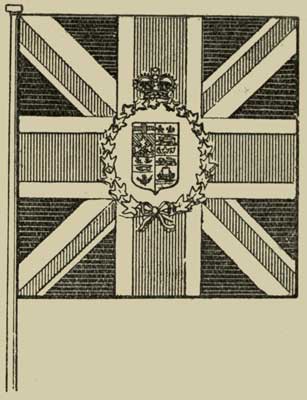
The flag of the governor or administrator in all other British colonies and dependencies is also the Union Jack, having upon it the arms or badge of the colony on a white shield, surrounded by a green garland of laurel leaves, surmounted by a crown.
In 1870, as a special honour, the imperial sanction was given to Canada to place a garland of maple leaves—its national emblem[168]—instead of the laurel upon the flag of its Governor-General.
The Lieutenant-Governors of the Provinces of Canada also wear the Union Jack as their distinctive flag, bearing upon it the arms of their respective Provinces, surrounded by a similar garland of maple leaves; but as they are appointed by the Government of the Dominion, and not by the King, the garland is not surmounted by a crown (66).
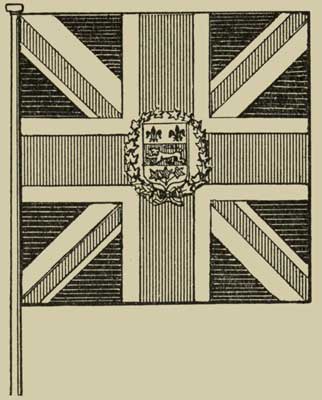
In this governor-general's flag, with its royal crown, its maple leaves, and Canadian coat-of-arms, as also in the lieutenant-governors' flags, backed up by the Union Jack, is symbolized the existence of British constitutional government in Canada. In this the reigning King or Queen is the whole Canadian people, and the Premier and his Cabinet are the repre[Pg 261]sentatives of the political party for the time being in power.[169] The Cabinet is responsible to Parliament for the policy which they introduce, and for which they, as well as all the other members of the Parliament, are immediately answerable to the electors, who are the original source of their power.
This modern flexible system of responsible government in Canada, so closely in touch with the people, in contrast with the irresponsible and rigid system in the United States, was neatly brought out by Lord Dufferin during his term as Governor-General of Canada, in a speech he delivered at Toronto, in 1874, after his visit to Chicago:
"More than once," said he, "I was addressed with the playful suggestion that Canada should unite her fortunes with those of the great Republic. (Laughter.) To these invitations I invariably replied by acquainting them that in Canada we were essentially a democratic people—great laughter—that nothing would content us unless the popular will could exercise an immediate and complete control over the executive of the country—renewed laughter—that the ministers who conducted the government were but a committee of Parliament, which was in itself an emanation from the constituencies—loud applause—and that no Canadian would be able to breathe freely if he thought the persons administering the affairs of the country were removed beyond[Pg 262] the supervision and contact of our legislative assemblies. (Cheers.)"
It is, then, easily seen why Canadians and our brother Britons love their Union Jack. It is the signal of parliamentary government by British constitutional principles. It represents progress and modern ideas—the rule of the people, for the people, by the people, through their unbiased King; and, therefore, it is the evidence of their affectionate and loyal allegiance to that monarchy and system of government under whose benign sway the colonies have advanced, and Canada, above all other countries on the continent of America, is the land of the self-governed and the free.
These are the liberties which the Union Jack signals in all parts of the British Empire to all the varied nations, with varied tongues, which have come beneath its sway. It is the consciousness of such liberty and the enjoyment of such equal rights that impelled Canada, Australia, New Zealand and all the colonies of the empire to send their sons to the field of contest in South Africa as a free-will offering to defend their fellow-men and to spread the blessings of Liberty and Freedom to the peoples of that continent.
From this has come that most recent acknowledgment of its incomparable liberties that the peoples of South Africa, the Boers of Dutch and French descent, so recently warring with their British neighbours of Cape Colony and Natal, have now[170] united[Pg 263] together and, meeting as brothers, have raised it as the union sign of their united liberty in the fourth[171] daughter Parliament of the Britains beyond the seas in our united empire.
The world over it is the free-will Flag of Liberty.
THE UNION JACK AS A SINGLE FLAG.
This Union Jack, so spread abroad, is in its single form a declaration and an evidence of British nationality, and is raised every day from sunrise to sunset over every one of the garrisons of the British peoples which surround the world. It is the flag which is raised and saluted whenever formal possession of any new territory is taken in the name of the Sovereign of Great Britain, and was thus raised at Khartoum, Bloemfontein, and Pretoria, to signify the success of the British arms and the accession of British rule, just as its predecessors had been in Newfoundland, on the shores of America, and all other colonies and conquests around the seas when each was first occupied.
Some considerable discussions have taken place as to whether it should be called the "Union Jack" or the "Union Flag."
This latter is the name usually given in the Official Regulations respecting the official use of a three-crossed flag of this description. There is in the navy the rank of "Admiral of the Fleet," corresponding to the rank of Field Marshal in the army. The Admiralty Regulations state that the proper flag of an Admiral of the Fleet is the "Union Flag," to be worn[Pg 265] at the top masthead, and an Admiralty memorandum further states: "A Jack is a flag to be flown only on the 'Jack' staff, i.e., a staff on the bowsprit or forepart of the ship."
The difference in name of the same flag when carried on a ship would appear to indicate a difference in size appropriate to the different positions.
In the order in Council[172] directing what flags are to be used by diplomatic and consular officers, it is stated: "The flag to be used by Her Majesty's consular officers ashore to distinguish their residences is the Union flag."
There is, however, another official name of this flag given in official instructions which must be noticed.
The Military Regulations (1899) order to be displayed afloat, by generals and other military officers commanding stations, as their distinguishing flags, "the Union, bearing in the centre as a distinguishing mark the Royal Initials, surrounded by a garland on a blue shield and surmounted by a crown." For Commissioners and Consuls-general, "the Union, with the Royal Arms in the centre, on a white shield, surrounded by a green garland."
This same name "Union" is also given in directions respecting this flag when included as a part of a larger flag.
The Admiralty Instructions directing what Ensign is to be worn by all ships of the Royal Navy in commission state that they shall "bear a White Ensign with the Red St. George's cross, and the Union in the upper canton."
The Foreign Office Regulations direct that "consular officers when embarked in boats or other vessels shall use the Blue Ensign with the Royal Arms in the centre of the fly of the flag, that is, in the centre of that between the Union and the end of the flag."
Many other instances could be quoted, but these are typical and sufficient.
Three names are used—the "Union," "Union Flag," and "Union Jack," all describing the same flag.
It is interesting to note the transition of the names. Under Charles I., in 1634, it was described as "the Union Flagge"; under Charles II., in 1663, "His Majesty's Jack, commonly called the Union Jack." The usage of the name Jack had thus early and largely spread, and it is further shown by a letter written by Burchett, the Secretary of the Admiralty, in 1695, regarding the flag carried by the Earl of Pembroke in the expedition against Cadiz, in which he says: "There was some doubt as to whether his Lordship should have borne at the maintop masthead the Royal Standard of England or the Union, or, more properly speaking in maritime phrase, the Jack flag commonly worn by those who have under the Lord High Admiral been appointed Admirals of the Fleet."[173]
It is not surprising, therefore, that under Queen Anne, in 1707, it is again described as "Our Jack, commonly called the Union Jack."
This name of the flag had, in fact, become so general that it had affectionately passed onward to give[Pg 267] its name to the gallant sailors who bore it, as is instanced in nautical ballads:
Used thus for centuries by sailors in song and on shore, although the name given in the proclamation of George III., 1801, was the "Union Flagge," the ancient and loving name of Union Jack has always prevailed among its upholders.
In the issue of official instructions there is propriety and, perhaps, necessity for using the different names, but they all contain the dominant name of "Union," and describe the same flag in its single form—the two-crossed or, in its succession, three-crossed Jack of united nationality.
There is another and distinctive use of the Union Jack. Surrounded by a white border of one-fifth of its width, it becomes a "Pilot Jack," and in this form becomes the official signal for a pilot, and is so used on all British ships, merchantmen as well as men-of-war, in all parts of the world. This white-bordered Jack is only appropriately to be used for this special signal service.
The restrictions given in the early proclamations as to the flying of the Union Jack at sea, and the official instructions as to its use as a special distinction on shore, particularly for military garrisons and official residences, have given rise to questionings as to the right of its being used by all British private citizens on land. Their authority to use it afloat has[Pg 268] been clearly defined, but not so clearly that of their right on shore, although such has been the usage and practice of centuries.
The proclamation of Queen Anne declared the flag which conjoyning the crosses of St. George and St. Andrew, had been approved to be "used in all flags and ensigns both at sea and land," and then proceeded to state restrictions only as to their particular using as insignia at sea, where as signs of authority and signals on ships such restrictions were unquestionably necessary.
No restrictions were placed upon their use on land, and thus all citizens of the United Kingdom were given authority to use on land "Our Jack, commonly called the Union Jack," the loyal usage which had grown up under its predecessors being confirmed. This right was not in any way changed at the time of the creation of the present Union Jack, which, in 1801, succeeded it, and so to the first century of loyal and common usage have been further added two centuries of loyal right.
In more recent times additional interesting evidence and authority have been given, both as to the name of this flag and its use by private citizens. In reply to an enquiry in 1902 by the Vicar of Folkestone, England, as to the propriety of the display of the Royal Standard upon his church at the time of the coronation of His Majesty Edward VII., Lord Knollys, Private Secretary to the King, in reply, informed him that the Standard should not so be used, but "you can always fly the Union Jack."[175] The name and the[Pg 269] propriety of the use of the Jack by private citizens in the United Kingdom was graciously confirmed.
As there had been considerable discussion as to what flags were proper to be used on land in Canada, the writer addressed Lord Knollys, quoting the previous letter, and stating the particular attention given to the flying of flags in this and the outer realms of the Empire, and received in reply, that "the Union Jack, being the national flag, may be flown by British subjects, private or official, on land."[176]
The Colonial Secretary of the Imperial Cabinet, in reply to a question in the House of Commons (1908), said that the Union Jack could be flown by every citizen of the Empire, as well as on Government offices and public buildings; that the Union Jack should be regarded as the national flag, and undoubtedly might be hoisted on land by all His Majesty's subjects.
Authority has also been since given by the "Home Office" in England, stating "that the Union Jack is to be regarded as the national flag, and may be used generally by British subjects on land".[177]
The three crosses of the three nations whose successive unions it first typified, have since expanded far beyond the United Kingdom of the parent isles.
The sons of the Kingdoms have in centuries of prowess carried it far afield, and bringing distant continents beneath its realm, have built up the Dominions beyond the seas in Australia, Canada, New Zealand, India, South Africa, and the myriad islands[Pg 270] of the oceans, so that it has become the Union Jack of the British Empire.
A British subject, wherever he may be on British soil, may, therefore, always use the Union Jack.
It has already been noted that when flags are to be employed for official purposes it is desirable that definite regulations shall be issued for their use. In Canada we raise the Union Jack on our Parliament and Legislative Buildings, as indicating the presence of Government under the British Constitution; by Parliaments derived from and following the precedents of the original Union Parliaments, and on our law courts, as sign of the administration of British law.
To emphasize and inculcate the world-wide duties that this flag proclaims, the Union Jack is raised over the Public Schools, so that the newcomers to our lands from other lands and other nationalities may know that they and their children have come to enjoy with us allegiance to King and country, the securities of British protection of person and property, and the rights and privileges of British citizenship, which loyal allegiance to it conveys.
Public education in Canada is under the charge of each of the Provincial Governments, and in Manitoba, Ontario, British Columbia and the Maritime Provinces the single Union Jack is the flag which has been instructed to be officially raised daily over the Public Schools.
Whatever flags may be used for other purposes and on other occasions, it is manifest that to be raised over schools this widely-spread national Union[Pg 271] Jack is the most fitting; telling the children, as it does, the duties and relations they bear to the other members of their Empire, and leading them to study, not only the history of the continent in which they live, but to go far back into the centuries and learn the growth of the glorious liberties which this flag has brought them, and the unity which its colours proclaim.
The patriotic celebration of "Empire Bay," which first was originated in the schools in Canada,[178] has extended through the schools of the Empire. On this day, as well as on other notable days, appropriate addresses are given, this Union Jack, the national flag, is reverently raised and saluted, and the National Anthem and patriotic songs sung by the scholars. It has been recorded that in the Public Schools in Canada, Australasia, New Zealand and Great Britain over 8,000,000 children united in this celebration in 1908, and it is still fast extending.
It is an inspiration for ourselves to have it thus brought to mind that our Union flag floats on every sea, and that on one-fifth of the earth's surface it is hailed as their union emblem by four hundred millions of fellow-patriots, in every clime, of many languages, and all religious faiths, each dearly loving their own native land and devoted to its welfare, but united in loyal brotherhood with their fellow, yet far-distant, Britons under One King, One Flag, One Empire.
THE JACKS IN RED, WHITE AND BLUE ENSIGNS.
In its single form the Union Jack has these special duties, which have been noted, but combined in the upper corner of a larger flag it creates a general flag of the nation, and thus environed becomes a Union Ensign.
Although usage has sometimes used the name, yet it is a misnomer to call a flag of this larger combined form a Union Jack, this being the proper name solely for the flag containing only the three island crosses.
The distinction in the names arises from the early days when a smaller flag—bearing a national emblem or the crest or coat-of-arms of a liege lord—had been inserted in a larger flag. This larger flag, bearing the emblem or insignia of its wearers, was termed an "Ensign."
Place our smaller union flag in the upper corner of a larger flag, and it there becomes the sign of identity, of allegiance, and of the union of British patriotism with the special story which is told by the colourings and form of the other parts, or fly, of such Ensign.
PLATE VIII
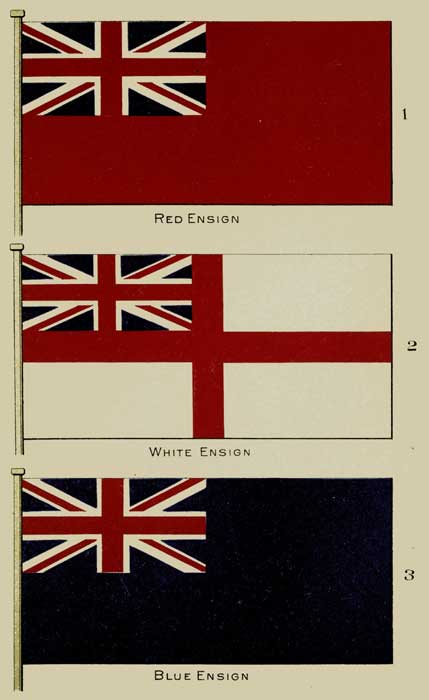
| 1 Red Ensign |
| 2 White Ensign |
| 3 Blue Ensign |
The Union Jack was first quartered in the upper canton of three flags, the Red, White and Blue[Pg 273] ensigns. These flags have arisen from the flags which were used of old to distinguish the ships of the respective squadrons into which British fleets were divided.
Lord Lisle, in the time of Henry VIII., divided his fleet at Shoreham in 1545 into three squadrons, the Vanwarde, Battle and Wing, corresponding in their position to the van, centre and rear.[179] These were the germ of the red, white and blue squadrons of the seventeenth century.
There were at that time only two distinguishing flags used in the navy, the Royal Standard and the St. George Jack.
The admirals hoisted their flags in accordance with their rank upon their flagships, in 1545, in the following order:[180]
| Squadron. | Admirals. | |
| 1. Battle | Royal Standard at main.St. George at fore. | |
| 2. Vanwarde | St. George at main.St. George at fore. | |
| 3. Wing | St. George at mizzen. |
The other ships of their respective squadrons displayed:
| Squadron. | Ships. |
| 1. Battle | St. George at main. |
| 2. Vanwarde | St. George at fore. |
| 3. Wing | St. George at mizzen. |
Eighty years afterwards, in the time of Charles I.,[Pg 274] we learn of another change, when in 1627 the Duke of Buckingham divided his fleet into squadrons at the Island of Rhe, each designated according to the flag it carried:
"Himself ye admirall and general in chief and admirall particular of the bloody colours," the "vice-admiral of ye fleete bearing a blew flag in his main top and was admiral of the blew colours," and the "rear admiral bearing a white flag in the main top and was admirall of ye squadron of white colours."[181]
The admirals' flags were, in 1627:
| Admiral | Red flag. |
| Vice-Admiral | Blue flag. |
| Rear-Admiral | White flag. |
It was into the upper corner of these red, blue and white flags of the squadrons that the single-cross St. George's English Jack was placed, in 1649, when the "Commonwealth Ensign" (Pl. IV., fig. 1) was formed and the red, white and blue ensigns of the navy first appeared.
Difficulties must have been caused by the fact that from the "Restoration," in 1660, the English merchantmen were, without authority, using the Ensign Red at the stern in exactly the same form as the flag of the red squadron, and still more when the general use of the Red Ensign on all ships had been officially authorized by Queen Anne in 1707.
At first the admirals holding the highest position had carried the red, but afterwards the seniority had been changed.
A rank of admiral, vice-admiral and rear-admiral was appointed for each colour. Promotion was made from the rank of captain to that of rear-admiral of the blue, which was the lowest, and upward through the red to admiral of the white, which had become the highest rank.
There were then nine ranks of admirals carrying the three ensigns:
| Admiral of the White | White ensign. |
| Vice-Admiralof the White | White ensign. |
| Rear-Admiral of the White | White ensign. |
| Admiral of the Red | Red ensign. |
| Vice-Admiralof the Red | Red ensign. |
| Rear-Admiral of the Red | Red ensign. |
| Admiral of the Blue | Blue ensign. |
| Vice-Admiralof the Blue | Blue ensign. |
| Rear-Admiral of the Blue | Blue ensign. |
As merchant ships, which were all flying the red ensign, increased in size, it became increasingly difficult for foreigners to distinguish these from the ships of the Royal Navy—a difficulty which was further intensified for them by the fact that a squadron of the Royal Navy might be sailing on one coast under the blue ensign, while another squadron was sailing under the red, and yet another under the white, according to the rank of the admirals of their respective squadrons.
Confusion and possibility of mistakes in identification in action was sometimes caused by the ships of one squadron becoming intermingled with those of another. Nelson solved this difficulty by directing that only the white ensign, which was the ensign of his own squadron,[182] should be used on the ships of all the squadrons at the battle of Trafalgar.
The three ensigns, with their successive one, two and three-crossed Jacks, had continued to be used in these varying ways during more than two hundred years, until 1865, when the positions of the three ensigns were separated and distinctive duties allotted to each.[183] The number of the rank of admirals was at the same time reduced to three—admiral, vice-admiral and rear-admiral. All of these were to fly, as they still do, the white ensign at the stern, their seniority being indicated by the position of the St. George Jack at the mast head.[184] These ranks are in addition to the rank of Admiral of the fleet, which confers the right to wear the Union Jack instead of the St. George.
The ensigns were described in the Order and directed to be used as follows:
The White Ensign (Pl. VIII., fig. 2).—A white flag, with a St. George cross through the whole flag[Pg 277] and the Union Jack in the upper canton, to be used at sea only by ships of the Royal Navy or by yacht clubs to which special license has been given.
The Blue Ensign (Pl. VIII., fig. 3).—A blue flag, with the Union Jack in the upper canton, to be used only by ships of the Royal Naval Reserve, or by merchantmen which are commanded by officers of the reserve, and have been duly licensed, or by yacht clubs to which special commission has been granted.
The Red Ensign (Pl. VIII., fig. 1).—A red flag, with a Union Jack in the upper canton, to be used as a national ensign by all British merchantmen.
By the Admiralty Regulations, afterwards issued, instructions are given as to the relative proportions of the parts of these flags.
In the Red and Blue Ensigns the Union Flag in the upper quarter next the staff is to be "in length half the length of the flag, and in width half the width of the flag."
In the White Ensign the Red Cross of St. George, which runs through the whole of the white field, is to be "2-15ths of the width of the flag." The Union is to occupy the upper quarter next the staff, leaving the whole Cross intact. This was virtually adding the Union Jack to the original English Jack of Richard I.
By a special Act it was afterwards more particularly enacted in 1889:
"The Red Ensign, usually worn by merchant ships without any defacement or modification whatsoever, is hereby declared to be the proper national colour of all ships[Pg 278] and boats belonging to any subject of Her Majesty, except in the case of Her Majesty's ships, or in the case of any other ships for the time being allowed to wear any other national colours in pursuance of a warrant from Her Majesty or from the Admiralty."[185]
It may be that the Red Ensign, which was the common flag of all the people ashore and afloat and the admiral's flag of highest rank and worn by the merchant ships, in the time of the Dutch wars, was given to the merchantmen in recognition of their great services in winning the supremacy of the sea; that the White Ensign was given to the Royal Navy in recognition and memory of Trafalgar; and the Blue Ensign to the Royal Naval Reserve because they were the rear guard to Her Majesty's ships; but the Union Jack was the binding link between them all, and established their rank and designation as "Union Ensigns."
The Red Ensign, first with its St. George cross under Charles II., afterwards with its two-crossed Union Jack under Queen Anne, and then with its three-crossed Jack, had thus become the national ensign on all British ships at sea, and not being restricted to any particular services, as are the white and blue ensigns, and in its red form, authorized by Queen Anne for use on land, it increased in its usage, and has become the Ensign of the British people on shore as well as afloat.
Whether it be in the "right little, tight little islands" of the old land, or in the greater area of the colonies which stud the globe, the presence of this Union Ensign proclaims the sovereignty of the united nations and the presence and protection of the British Empire.
Thus the three crosses in the Union Jack have ceased to have solely their local meanings, for their story has become merged in the larger significance which their presence now imparts to the several Dominion Union Ensigns as being the sign of this greater British Union.
THE UNION ENSIGNS OF THE BRITISH EMPIRE.
A further evolution in the Union flag has come step after step, by which the distinguishing emblems of the colonies have become part, first of the Union Jack, afterwards of the Union ensigns, and then through the red ensign to unite home and colony in one Imperial Union ensign.
In the century of the expansion of Raleigh's "trade command," the governors of the English colonies, principally of those in America, began giving commissions to their local colonial ships, authorizing them to engage in the various free and ready methods by which that trade was being obtained from foreign sources. Some inconvenience seems to have resulted from this practice, as the colonial ships carrying the two-crossed Jack were making prizes and taking trade under the flag which the Old Country merchant ships were directed not to use. Objection was made by the ships sailing from the home ports, and under William III. the matter was taken up.
PLATE IX.
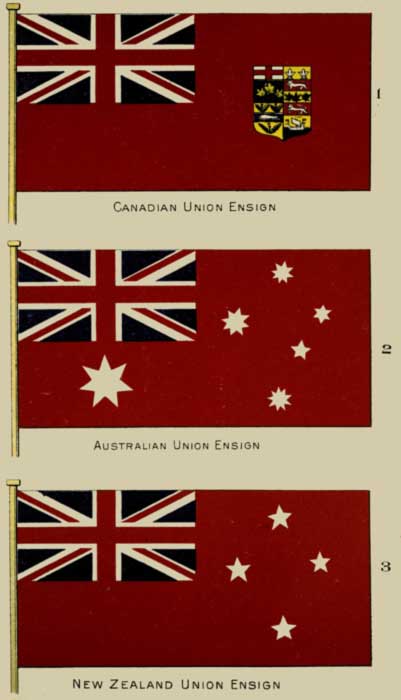
| 1 Canadian Union Ensign |
| 2 Australian Union Ensign |
| 3 New Zealand Union Ensign |
The English Lords Justices in Council considered the question and reported:
"At the Council Chamber, Whitehall, the 31st day of July, 1701.
"Present—Their Excellencies the Lords Justices in Council.
"Upon reading this day at the Board a report from the Lords Commissioners of the Admiralty in the words following, viz.:
"Their Excellencies the Lords Justices having been pleased to refer to us a Report of the Lords Commissioners of Trade, upon a Memorial from this Board, representing the Inconveniences that do attend Merchant ships wearing the King's Colours, in and among the Plantations abroad, under Colour of the Commissions given them by His Majesty's Governours of the said Plantations. We do most humbly report to their Excellencies that we do agree with the said Lords Commissioners for Trade that all such ships to whom the aforesaid Governours shall, by the Authority Lodged in them, grant Commissions, ought to wear colours that may distinguish them from private ships, as is done by those employed by the Officers of the Navy, Ordnance Victualling, and others, and therefore do humbly propose that all the said Governours may be directed to oblige the Commanders of such Merchant ships, to which they grant Commissions, to wear no other Jack than that hereafter mentioned, namely, that worne by His Majesty's ships with the Distinction of a White Escutcheon in the middle thereof, and that said mark of[Pg 281][Pg 282] Distinction may extend itself to one-half of the depth of the Jack, and one-third part of the Fly thereof, according to the sample hereunto annexed.
Directions were accordingly so issued, and of the instructions transmitted to the governors of the colonies in America originals are extant of those sent to Massachusetts, in 1701, and New York, in 1709. Fig. 56 is from an actual tracing from the drawing of the flag on the margin of the instructions sent to the Governor at Boston.[186] It will be noted that the white escutcheon on the Jack is perfectly plain and without any special distinctive emblem, such as those worn on the escutcheons on the ordnance and other departmental flags.
The white escutcheon of the home departmental flags was thus extended to the Union Jacks used in the colonies, and formed the new and first "colonial flag" (Pl. III., fig. 3).
The Governors, High Commissioners or Administrators of British colonies and dependencies were afterwards authorized to place upon this white escutcheon on the Union Jack the arms or emblem of the colony in which they served. In this way it has come that the arms of Canada, the southern cross constellation of Victoria, the red cross and British lion of New South Wales, the black swan of Western Australia (67), and the other special distinctive emblems[Pg 283] in each of the British colonies are now displayed upon the centre of the Union Jacks which form the Governor's flag in each.

| Victoria. | New South Wales. | Western Australia. |
In 1865, when Colonial Navies were first established, the vessels of war maintained by the local governments in Australia were authorized to use the blue ensign, with the seal or badge of the colony in the centre of the fly,[187] and thus the escutcheon being transferred from the centre of the Jack to the centre of the "fly," was given another position, and the local stories of the Australian colonies, which established these fleets, became embodied in the British blue ensign.[188]
A similar privilege, although they are not commissioned as vessels of war, was afterwards extended to the "fishery protection" cruisers of Canada, so that these and all other vessels which are owned by the Government of the Dominion carry the blue ensign with the arms of Canada in the centre of the fly.
Authority was also given to all these vessels owned[Pg 284] and commissioned by the colonial governments to fly a blue pennant of the same shape as that of the British navy (Fig. 22, page 108), with the white ground and red cross of St. George at the head, but having the fly blue instead of red.[189]
By such successive steps the Imperial idea became attached to one of the ensigns of the British navy.
From the plain white escutcheon in the centre of the colonial Union Jack, 1701, to the special emblem in the fly of the colonial blue ensign, 1865, was a long way, but other steps were yet to be taken.
The vessels owned by the governments of the colonies had thus been given their special British Union flags, but provision had not been made for those owned by private citizens. The plain red ensign has, by authority of Queen Anne, become the national right of all British subjects on all lands as well as on all seas. As the colonies developed in native energy so their merchant shipping increased, and in recognition of this advance, and in order that their ports of origin might be made known, all colonial-owned merchant vessels were accorded, in 1889,[190] the right of wearing, together with the red ensign, an additional flag on which might be shown the distinguishing badge or insignia of their colony, similarly as under James I. direction had been given to raise the separate national Jack of England or of Scotland at the same time as[Pg 285] the King's Union Jack. In order to prevent the possibility of mistakes in identification, it was further directed that any flags of this character were to be made in such a way as not to resemble any of the existing flags of the Royal Navy.
In some of the Australian colonies local flags of excellent design had been devised, but these additional flags of entirely separate design were not all that could be desired, for while the special local flag might give expression to the local patriotism represented, there might come with it also an idea of separation, and it did not succeed in expressing the dominant and prevailing sentiment of allegiance to "One Empire, One Flag."
It fell to the lot of the statesmen of Canada, who do not seem to be behindhand in developing new and imperial ideas, to suggest (1890) another step in the history of the ensign.
The merchant shipping of Canada stands fifth in rank in merchant shipping among the nations of the world.[191]
The government ships were authorized to use the blue ensign with the Dominion arms as their distinguishing flag, but as no distinctive flag had been adopted for Canada, her merchant marine used the same plain red ensign as worn by the merchant marine of Great Britain, and Canadian merchant ships were unable to be recognized amidst those of the Mother Country.
In 1892, to meet this requirement, the Lords Com[Pg 286]missioners of the Admiralty, on the suggestion of the Canadian Department of Marine, issued a warrant permitting the badge of the arms of Canada to be inserted in the flag of the red ensign as well as in the blue, and this new combined red ensign was by this empowered to be used on board vessels registered in the Dominion of Canada.[192]
Thus was formed the union ensign of Canada. This Canadian ensign (Pl. IX., fig. 1) is the British red ensign, having the Union Jack in the upper corner and the arms of Canada in the fly.[193]
This restriction to its being used only afloat has, like the ancient restriction of the Union Jack, been modified by usage and authorized by permission. Yet it is also to be remembered that the right of the red ensign had been conferred by Queen Anne upon all British citizens whether at sea or on land in all British Dominions, and is rightfully to be raised by all Canadians. The "Dominion Ensign" is the red ensign of the Empire with the insignia of Canada on the broad red of the fly, and, being accorded to Canadians as an evidence of the ownership of their ships, has passed onward to be an evidence of their country over their own homes. As they have the right to use the plain red ensign everywhere, so now they may use its daughter, the Canadian ensign, and although there[Pg 287] was at first a restriction as to its use at sea, this has been merged in the more widely extended and general usage on land.
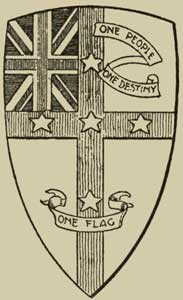
The raising of this ensign does not, any more than the raising elsewhere of a red ensign in addition to the single Union Jack, suggest any idea of separation; on the contrary it was designed by the Canadian statesmen to avoid any such idea which, perhaps, might be attached to an entirely different flag. The presence of the Union Jack in the upper corner declares inviolate fidelity to King and Empire, while the Canadian emblem on its folds gives a recognition of native home. When an Englishman raises his St. George, the Scotsman his St. Andrew, or the Irish the St. Patrick or their crown and harp on a blue ground, it is not taken as a sign of separation, but only as a recognition and reminiscence of their old homes and ancestry; so, too, with the Canadian in his special ensign, with its Canadian emblem. All raise both their native and the Union Empire flags in united fervour.
The federation badge with the stars of the Southern Constellation, worn during the plebiscite of 1899 in Australia (68), suggested that the union of the Par[Pg 288]liaments of the colonies on that continent might be followed by the creation of a Union ensign for the new Commonwealth of Australia.
The union came in 1901, and following on the line of the Canadian ensign, the Australian ensign was created. This is the British red ensign with the Union Jack in the upper corner, under this Jack a six-pointed star signifying the six Provinces or States of the Australian union, and in the fly the five stars of the constellation of the Southern Cross,[194] the leading constellation of the Southern Hemisphere.
By a subsequent enactment another point was added to the star, making a star of seven points,[195] one for each of the States, New South Wales, Victoria, Queensland, South Australia, Western Australia, Tasmania, and one for the Territories of Papua and Norfolk Island; but the rest of the ensign remained the same as previously.
Thus was formed the Australian ensign (Pl. IX., fig. 2).
The Union Ensign of the Dominion of New Zealand contains in the same way the Union Jack in the upper corner, and a southern constellation of four stars in the middle of the red fly (Pl. IX., fig. 3).
As the separated colonies of South Africa are now joining together in a union Parliament under the Union Jack, we may expect another Union Ensign to be added to the galaxy of these loyal union and native ensigns.
Like the expansion of the British Constitution to patriot governments beyond the seas, so has come the extension, step by step, of the old union flag to the newly-created Dominions. As the spirit of that constitution has been adapted to the local circumstances in each, so the red ensign with its Union Jack, which is the embodiment of the power and glory of the British nation, has been emblazoned with the local fervour of each young and growing people, who, ardently loving their new land, yet stand unconquerably in union with the Motherland, and rejoice at seeing their own emblem set upon the mother flag. Each such flag tells us its grand story in a way that a national flag ought to do; for the red ensign of the homeland, with the sign of the colony added to its folds in these far-off lands, signals to the beholder that it is an Imperial Union Ensign of the British Empire.
These are the union ensigns of the self-governing Dominions of the outer Empire, which have been adopted in succession in each, as a Union Parliament for their Dominion has been created, to embrace the several Provinces or States of their continent, and endowed with powers from the Union Parliament of the Parent Realm.
As in the sixteenth century the forces of the Percys raised the cross of St. George in their ensign (Pl. III., fig. 1), to show that of whatever district they might be they were all Englishmen, so the younger nations of the Britains over the seas raise the Union Jack in the upper corner of their Dominion Union Ensigns to tell that their bearers are all Britons, sons and daughters of the Family, loyal to the British Crown.
When the Canadian sees the union crosses displayed on his Canadian ensign, or the distant brother colonist on that of his colony, it speaks to each, not only as his own native flag, but yet more as his sign of brotherhood in an empire wider than his own home, broader than the continent on which he lives, for it is the visible evidence of his citizenship in the Empire of Great and Greater Britain.
The fervid eloquence of Daniel Webster, in 1834, described that empire as "a power dotted over the surface of the whole globe with her possessions and military posts, whose morning drum-beat, following the sun and keeping company with the hours, circles the earth with one continuous and unbroken strain of the martial airs of England."[196]
If this heart-rousing testimony of the majesty of the empire, of which the dominions and colonies form a part, had been given by one of ourselves, it might have been tinged with the suspicion of self-glorious boasting; but springing from the lips of so distinguished a citizen of the United States, its fervid utterance is the candid acknowledgment of a nation wider than his own, whose grandeur compelled his admiration.
If over half a century ago this ascription was true, how much more so is it in these later days when the ideal of the "morning drum-beat" has been transmuted into actual fact in the "continuous and unbroken strain" of the "Diamond Anthem" of the rejoicings at the Jubilee of Queen Victoria,[197] when,[Pg 291] commencing at Suva at 4 p.m. on that Sunday afternoon, the National Anthem was taken up in the assemblies in almost every place in the outer British Dominions as the sun came over them in succession around the world, until it had come back again to Fiji on the following day.
Those "possessions" which fired the statesman's imagination have marvellously increased; that "power" has expanded beyond his utmost dreams. Since that time no nation, not even his own, has progressed like has the British nation. Canada, then lost to view in a solitude of far-off forests or of pathless plains, has arisen like a young lion, and carrying the Union Jack in continuous line of government from the Atlantic to the Pacific, has gripped the American continent from sea to sea. Australasia and New Zealand have risen beneath the southern star, India in itself has become an empire, and Africa, youngest born of all the lion's brood, is welding fast another continent beneath the imperial sway.
These are the nations of the Union Jack, the galaxy of parliaments of free men, which have arisen round the centre isles and the throne of Her who, with Her statesmen,
In this Nation of nations, brothers join hands with their brothers around the world, and raise aloft the Union Jack of itself, and in their ensigns as the glad emblem of their united allegiance, a union for[Pg 292] which the Britains beyond the seas have proved their faith, and ever stand in foremost rank ready and willing to defend.
There is something marvellous in the world-wide influence of this three-crossed flag of the parent nation, whose sons have followed its ideals through all the centuries. Sometimes they have made mistakes, or blundered into difficulties, but undaunted, masterful and confident, have profited by the hard-won experience, and progressing with the march of time, find at the beginning of this twentieth century that they "have builded better than they knew."
Thus, when in the opening month of 1890 Britain stood alone, as said a Canadian statesman,[198] in "splendid isolation," there was heard coming, not only from Canada, but from every daughter nation around the seas, the same brave refrain which had been sung by a Canadian poet in 1861, when the sanctity of the flag had been violated in the stirring times of the "Trent affair":
And yet again in 1899, when brother Britons in[Pg 293] Africa were suffering injustice, when our British colonies were being invaded and the Union Jack attacked by a mistaken foe, the Empire arose, and the bold refrain passed into chivalrous action.
In ships that ploughed furrows around the world the sons of the Empire came—colonists, yeomen and imperial forces—"in one united armament blent," to give their glad devotion in life or death for Queen and Union Ensign on the South African hills and veldt.
Such, then, is the story, such is the meaning of our Union Jack; the emblem of combined constitutional government, the proclaimer of British liberty, the Union sign of British rule, the signal of the Realm of "Great Britain and Ireland and of all the Britains beyond the seas."[199]
Mindful of its story, happy in their lot, facing the World, its sons and their sons' sons stand up to their Union Colours and encircle the earth with their glad anthem,
THE MAPLE LEAF EMBLEM.
The maple leaf emblem of Canada, as compared with the rose, shamrock and thistle of the British Isles, has but so recently entered into the realm of national emblems that some of the reasons for its adoption may well be given.
The maple tree is found in luxuriance in every province of the Dominion. Varieties of it grow, it is true, in other parts of America, but the tree is in its greatest glory in the northern zones, where throughout Canada, extended along her line of similar latitude, it attains to its greatest and most robust development. It flourishes in Newfoundland, in the Maritime Provinces, and in Quebec. It is the finest forest tree in Ontario. Manitoba maples form the foliage of the North-West, and anyone who has seen the giant maple leaves of British Columbia will say the maple leaf is the natural emblem of Canada.
As well as being the natural emblem, it is also the typical emblem. It was held in high esteem by the early settlers of Quebec, and was adopted, in 1836, as the French Canadian emblem for the festival of St. Jean Baptiste. It was placed on the coinage of New Brunswick early in the century; a whole maple tree was shown on the coinage of Prince Edward Island before the time of Confederation, after which event maple leaves have been used on all coinage issued by the Dominion. At the creation of the union in Confederation it was placed in the arms of Quebec and of Ontario, and was heraldically recognized as the "emblem of Canada."
Maple leaves form the wreaths on the flag of the Governor-General of the Dominion and on the flags of the Lieutenant-Governors of all the provinces. The maple leaf[Pg 296] was the emblem placed by His Royal Highness the Prince of Wales on the Colours of the "Royal Canadians," the 100th Regiment, raised in Canada in 1865, and it is still worn as the regimental badge of their successors, the Royal Leinster Regiment.
It has been worn on the breasts of all the representative champions of Canada—at the oar, on the yachts, on the athletic fields, in military contests, and at the rifle ranges—as the emblem of their country.
It is on the "Canada Service" and "North-West" medals, and on the uniforms and accoutrements of the Canadian Militia, of the North-West Mounted Police and all official Services.
It was the distinguishing emblem on the uniforms and helmets of the lusty and loyal sons of the Canadian contingents who served in South Africa in 1900, where the presence of that emblem reminded them of their far-off home and nerved their hearts for deeds of duty and devotion to Canada and their Queen. The wounded Canadian who, lying wounded on the veldt at Paardeberg, touched the maple leaf upon his helmet and said to his companion, "If I die, it may help this to live," spoke that which burns within the heart of every Canadian lad and fires the inborn energy of his race.
It has been extolled in poetry and prose; it is the theme of the songs of our children; and the stirring strains of "The Maple Leaf" form an accompaniment to our British national anthem.
Everywhere throughout the world the maple leaf has won recognition as the emblem of the Canadians, and surely might well be displayed upon their national flag.
If, instead of the Dominion coat-of-arms, a green maple leaf were placed on the shield in the Canadian ensign, the flag would be fairer to see and more easily distinguished. Green is the emblem of youth and vigour, or, if the colour used were scarlet, the colour of courage, then in either case the natural and emblematic attributes of the leaf would be represented.
It was suggested[200] that in that year of the Diamond Jubilee a white diamond of one-third the size of the "union" should be substituted for the present shield and coat-of-arms, making a flag (69) which would signalize an historic epoch. The single maple leaf on the white diamond in the fly of the red ensign would tell as bravely and more clearly the story of the "coat-of-arms" on the[Pg 297] shield, and it would also be a national tribute to that Queen under whose commanding influence the colonies have arisen around the empire, and be a record of that Diamond Jubilee of Victoria which was the revelation of their union and the united testimony to their affection and allegiance.
If for similarity with the flags of other branches of the Empire a white escutcheon or circle should be preferred to the diamond, the maple leaf upon it would be equally well displayed and the sign of Canada on the red fly of the ensign be clearly distinguished.
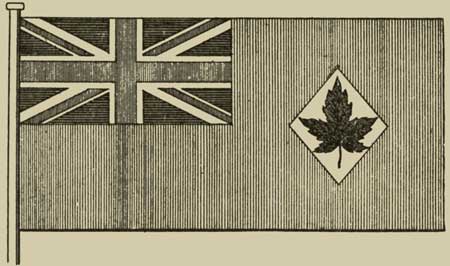
Flags are signals to be used for conveying information to persons at a distance; their details should, therefore, be simple in form and be displayed in simple colours. The multi-coloured quarterings of the Dominion arms, as shown on the shield upon the Canadian ensign (Pl. IX., fig. 1), have not been found entirely efficient, for they fail in being easily recognizable.
Whatever the colour may be or the shape of the escutcheon, the single maple leaf on a white ground would tell at a glance that the emblem was the emblem of its people, and that the flag was the Canadian ensign.
LETTERS FROM THE PRIVATE SECRETARY OF HIS MAJESTY KING EDWARD VII.
Dear Sir: In reply to your letter, I am afraid that the Royal Standard, which is the King's personal flag, can only be hoisted on the Coronation. If permission were given in one case, it would be impossible to refuse it in any other. I must remind you that you can always fly the Union Jack.
Yours faithfully, F. KNOLLYS.
The Vicar of St. Michael's, Folkestone.
Sandringham, Norfolk, Dec. 29th, 1907.
Sir: In reply to your letter of the 9th inst., I beg to inform you that the "Union Jack" being the national flag may be flown by British subjects, private or official, on land.
Yours faithfully,
KNOLLYS.
Barlow Cumberland, Esq. Port Hope.
CANADIAN WAR MEDALS.
The War Medal (62) was granted in 1848, to be worn by the men of the British forces who had served in the fleets and armies during the wars from 1793 to 1814. Among these the Canadian militia was included.
Clasps were granted to those men who had been present at the actions of St. Sebastian, Vittoria, Salamanca, Talavera and Vimiera, in the Peninsular campaign; and in the Canadian campaign, for the actions at Fort Detroit, August 16th, 1812; Chateauguay, October 26th, 1813; and Chrystler's Farm, November 11th, 1813. The medal from which the drawing is made is engraved, "A. Wilcox, Canadian Militia," and bears the clasp "Fort Detroit."
The Canada General Service Medal (63) was granted in 1898 to the survivors of the Canadian militia and Imperial troops who had been out in active service in Canada in repelling the Fenian Raids of 1866 and 1870, or in the Red River Expedition under Wolseley in 1870. There are three clasps—"Fenian Raid, 1866," "Fenian Raid, 1870," "Red River, 1870." Upon the reverse side is the Canadian ensign surrounded by a wreath of maple leaves. The drawing is made from the medal of the writer, as engraved, "F. B. Cumberland, Ensign, 10th Royal Reg't."
The North-West Canada Medal (64) was granted in 1886 to all who had served in the Canadian North-West in 1885. The clasp "Saskatchewan" was accorded to all who were present at the actions of Fish Creek, April 24th; Batoche, May 12th; and Frenchman's Butte, May 27th, 1885.
The force serving in the operations of 1885 was drawn entirely from the Canadian militia and the North-West Mounted Police, with the addition of the Imperial officers on the staff.
A RECORD OF THE "DIAMOND ANTHEM."
20th June, 1897.
The imaginative description given by Daniel Webster in 1834 of the "Morning drumbeat which, following the sun and keeping company with the hours, circles the earth with one continuous strain of the martial airs of England" has been for many years the ideal example for estimating the world-spread area of the British Empire. It seemed at the time, and was, a poetic fancy, but since that time the domiciles of the British peoples have been more amply developed and more closely spread so that the world is now encircled not simply with isolated military posts, but by a continuous line of happy British homes.
The time for the celebration of the 60th year of the accession of Her Majesty Queen Victoria, so aptly named, by His Royal Highness Prince of Wales (now Edward VII), the Diamond Jubilee, was approaching and many projects were rife to give expression to the loyalty and affection of Her Majesty's subjects.
The official day set for the celebration was Tuesday, June 22nd, 1897, a date which was preceded by Sunday, June 20th, the actual anniversary of Her Majesty's accession.
Mr. Barlow Cumberland was then the President, and Mr. Jno. W. Carter the Secretary, of the Supreme Lodge of the "Sons of England Benevolent Society." This is an organization which had been initiated in Canada in 1874 for the purpose of joining together colonists who had emigrated from England, or their descendants, for patriotic, benevolent and social purposes; to welcome new-comers and be of fraternal assistance to one another. The Society had flourished and Lodges had been formed in all parts of Canada. A branch organization had been established in the Colonies of South Africa and[Pg 301] connections had been opened in Australia. A compact and energetic organization therefore was ready to hand in the larger parts of the Colonial Empire. The members of the Society were actively joining in the arrangements for all the local celebrations for the 22nd, in which they afterwards took fullest share. Mr. Cumberland made the proposal that they should do something more and should in addition, organize a world-wide incident which their far-spread organization would enable them to do, and which would be the further tribute of the Sons of England to their Queen and a testimony of the fidelity which they had carried to their new homes beyond the seas. Besides being President of this, and of other National Societies, Mr. Cumberland had for many years been actively engaged in steamship and railway operations, so was peculiarly qualified for the requirements for completing such an enterprise.
His conception and proposal was the "Diamond Jubilee Anthem," to be sung around the world, following the sun, on Sunday, June 20th, the actual anniversary day.
His project was that, commencing at the time of the earliest hour in the morning on the 20th at Windsor Castle, where Her Majesty would be in residence, the sons and daughters in the Colonies should encircle their Queen with the never ceasing upraisal of their loyal acclaim and prayer by taking up the singing of the National Anthem in succession at their far distant homes throughout all the hours of that great day of her life. It was to be as though deputation after deputation from the Colonies, each carrying the Union Jack, were presenting themselves minute after minute and singing below the Castle walls.
On the opposite side of the world from the Heart of the Empire at Windsor Castle are the Fiji Islands, the Colony situate nearest to longitude 180°, which is 180°, or 12 hours, from the centre of time at the Royal Observatory at Greenwich, and is the dividing line of the days of the world's time—where day begins and midnight ends. At these Islands, being on the opposite side of the world, it is 4 o'clock in the afternoon at the same moment at which it is 4 o'clock in the morning of the same day in England. The problem was therefore to have the National Anthem commenced in Fiji at the beginning of Her Majesty's day, and arranging to have it sung thereafter precisely at 4 p.m., as the sun arrived at that moment in succession over each place in the Colonies and passed onward around the world.
A form of service was devised, suitable for any Sunday[Pg 302] afternoon service to be held in any church, open air service or assembly hall, in which the National Anthem should be arranged to be sung at the exact moment of 4 o'clock.
A time-table of longitudes, prepared by the Meteorological Department of Canada, showing the meridian or sun time at each place, and full descriptive circulars with forms of service and a time-table showing the hour at Windsor Castle and the corresponding hour at each place, were sent in multitude to friends and correspondents in these Colonies and Dependencies owning allegiance to the Union Jack.
With the co-operation of the Right Rev. the Bishop of Toronto, who was a member of the Order, and the Heads in Canada of all religious bodies, communication was opened up with the Colonial bishops and clergy, and their services were enlisted. Patriotic societies and the secretaries of the Royal Colonial Institute were asked to assist, and letters were also sent to the captains of every British passenger ship which would be at sea on the 20th of June, asking them to sing the Anthem, fire a gun, and note the position of their ship at 4 p.m. on that day.
The brethren of the Society in Newfoundland and Canada took the service up with energy and enthusiasm. The Sons of England in South Africa answered with alacrity, Australia and New Zealand joined in heartily, and thus, by prompt and efficient action, the organization was completed and ready for the eventful day.
Copies of the services and time-table beautifully illuminated, were sent to Her Majesty, by reference to which it could be seen at any hour how far the Anthem had proceeded on its way and in what Colony it was at any moment being sung.
In acknowledging receipt the Colonial Secretary, the Right Hon. Joseph Chamberlain, said to His Excellency Lord Aberdeen: "I have the honour to acknowledge the receipt of your dispatch of the 24th April, with its enclosures on the subject of the Continuous Service around the World which is being arranged by the Sons of England in commemoration of the 60th Anniversary of the Queen's Accession to the Throne. I have to inform you that, in accordance with your request, the matter has been brought before the notice of the Queen, and that Her Majesty was graciously pleased to express her sincere appreciation of the loyal feelings that have prompted this interesting method of Commemoration."
Two thousand six hundred personal letters were written, 60,000 copies of the service sent out, and after months[Pg 303] of work the 20th of June came and the Anthem passed around the world.
Each one knew that they had done their duty, but had others far away done theirs so that the links might be complete?
The idea when first made met with immediate acceptance as a happy conception, but many doubts were expressed as to the possibility of its being actually accomplished, for it seemed to the faint-hearted almost an impossibility to arrange for a connecting line of services, which should take place in succession around the whole circle of the earth for the space of twenty-four hours. Yet the President was able to inform the Grand Lodge that the Jubilee service had been carried out in actual fact and in completest detail.
Of this record it is not possible within the limits of this notice to give more than a sketch.
Reports and letters kept coming in for month after month from the far distant continents in reply to the request, and giving an account of the proceedings. A few extracts only can be given here as samples of many hundreds of similar character which were received from the continuous line now recorded around the world, telling of how the Diamond Jubilee Anthem was sung at each place as shown in the time-table attached.
The service commenced on Sunday afternoon, 20th June, in Levuka, Fiji Islands. Dr. Garner Jones, headmaster of the Levuka Public Schools, writes: "Owing to geographical position—viz., 178° 51' e. long.—the inhabitants of Levuka, Fiji Islands, enjoyed the unique honour of initiating 'The Wave of Song' that hailed the Diamond Jubilee of Her Majesty's Ascension. The service was an open air one, being held in the Government school grounds, Rev. W. Floyd, of the English Church, officiating. The attendance was large and included representatives of various races who claim Her Majesty as their Sovereign. English, Scotch, Irish, Australian and New Zealand Colonials, Chinese, Germans, Swedes, and among them the characteristic bushy hair of the Fijian and other South Sea Islanders was prominent, there found themselves shoulder to shoulder in the antipodes of the British Empire earnestly rolling forth our grand old National Anthem, thus giving the keynote of thanksgiving to the entire world. The Masons and Oddfellows appeared in regalia and the Levuka brass band was in attendance. Surrounding the main body of the assembly were the Levuka school boys, drawn up with their wooden rifles.[Pg 304] Punctually at five minutes to 4 o'clock the procession of choristers left their temporary vestry and slowly approached their stand. At 4 o'clock precisely, meridian time, the British Ensign was hoisted, which was the prearranged signal, the band immediately struck up, and every throat commenced 'God Save the Queen,' while the public school guard stood at the 'Present.' Undoubtedly the occasion was unique, and Levuka never forgot for a moment that her geographical position was unique also, in so far as she enjoyed the proud distinction of being allowed to start the wave of song which in its course would pass over in rotation all the British possessions on the face of the globe."
At this same moment at which it was 4 p.m. Sunday in the Fiji Islands, and 4 a.m. Sunday at Windsor Castle, where Her Majesty was in residence, the Executive of the Sons of England met at Shaftesbury Hall, Toronto, it being then precisely 10.55 p.m. on Saturday, June 19th, and sang the National Anthem, commenced that same minute in Levuka on Sunday afternoon, and which for the next seventeen and a quarter hours was to be coming steadily nearer with the sun as it passed in succession over each of the loyal gatherings in other lands until it was over Toronto at 4 o'clock (4.18 Standard time) on Sunday afternoon, when the Sons of England and Britons in Toronto again joined in the loyal strain as it passed by them onward toward the West.
Three minutes after Levuka had commenced, Suva, the Fiji capital, took up the strain. Mr. Hamilton Hunter says: "I am glad to report that the Special Jubilee Service was a great success in this Colony. It was not merely confined to the English Church, but was heartily taken up by the Roman Catholic, Presbyterian and Wesleyan Churches. The National Anthem was sung on the stroke of four. I have to thank you for having enabled us to set 'The Wave of Song' in motion by your timely warning."
Seventeen minutes later, or before the services in the Fijis had closed, the Anthem was taken up in Napier, New Zealand. The report says: "The Jubilee services at the cathedral yesterday will be remembered by the Napier people for many a long year, and it is questionable whether a more imposing ecclesiastical spectacle was ever witnessed in New Zealand. The cathedral was crowded to excess, all the friendly societies of Napier being present." The Dean writes: "As Dean of the easternmost cathedral in the British Empire, the cathedral upon which the rays[Pg 305] of the rising sun first fall, I have to report that, in accordance with your wishes, we joined in the great circle of Anthem singing, as arranged for by the Sons of England, at 4 o'clock on the afternoon of Sunday last. The service was a very magnificent and enthusiastic one. I convey my most hearty good wishes to you and to the members of the great organization you represent."
The wave swept across Australia. At Melbourne, Victoria, B. Cowderoy, Esq., Secretary R.C.I., reports: "Both cathedrals (Anglican and Roman Catholic) were crushingly full. In the Exhibition building several thousands, after addresses by leading Wesleyans, took up the National Anthem at our Standard time. In the Town Hall the Anthem was sung with fervour at 4 p.m. by 4,000 with most impressive effect. I am an octogenarian, but in this matter I am as young as my eight grandsons, and thank you, Mr. Cumberland, for your happy suggestion which has given added interest to all that is being done." Adelaide, South Australia, reports: "The Bishops of the Diocese entered heartily into the scheme. The Governor and his staff were present. The National Anthem was sung with intense fervour and most thrilling effect." So it passed through the other cities and over the continent of Australia.
Across the Indian Ocean.—S.S. Empress of India marked the latitude 26° 6' n.; long. 120° 26' e.: "Rockets fired and National Anthem sung at 4 p.m. off Alligator Rock."
It first touched Africa and was hailed by the lodge of the Sons of England at Durban, Natal, and then in continuing line across South Africa, in all the principal cities, and at Cape Town the record was maintained.
On the Atlantic Ocean it was taken up on many British ships at sea, among which a few only may be mentioned. R.M.S. Tantallon Castle, lat. 7° 17' n.: long. 14° 33' w., off west coast of Africa: "Guns fired and Anthem sung at 4 p.m." S.S. Greek, lat. 18° 10' n.; long. 17° 38' w.: "Fired rocket and sang National Anthem." S.S. Numidian: "'God Save the Queen' sung precisely at 4 p.m." Ship's position, lat. 54° 42' n.; long. 20° 43' w. S.S. Catalonia: "At 4 p.m. I had two explosive gun signals fired on my ship in lat. 50° 12' n.; long. 22° 6' w. It was blowing a south-west gale with high seas, and it was a great disappointment to me that we could not hold the service I had intended, but all classes of passengers were so seasick."
By the equivalent time of 7.31 o'clock in the evening at Windsor Castle the Anthem had crossed the Atlantic, and first touched the shores of America at St. John's, Newfoundland,[Pg 306] when it was met by Lodge Dudley S.O.E. assembled, together with the Governor-General and all the friendly societies in the cathedral. "The service was impressive in the extreme." From here westward through Canada the records of the reports in the time-table appended show how that as the sun crossed the continent the line through the villages, towns and cities of Canada was so complete that the singing of the Anthem in one place had not ceased before it was taken up in the next. Brief extracts from the reports of a few only can be given. Charlottetown, P.E.I.: "The First Methodist Church was crowded to the doors with members of the Orangemen, Good Templars, Oddfellows, Masons and the Mayor and City Officials. At the proper moment the church rang with the grand old strains of the National Anthem." Halifax, N.S.: "St. Paul's Church was filled to its utmost. Among those present were Countess Aberdeen, General Montgomery Moore and Admiral Erskine with their staffs. At 4.14 o'clock the Anthem was sung right loyally." Montreal, Que. "Services were held in four churches and all well attended. At Christ Church Cathedral a large military church parade was held and as in the others the Anthem sung at the appointed time." Ottawa: "All the local societies joined in a church parade to Christ Church Cathedral. At 4.03 o'clock the Guards Band struck up the National Anthem, which was heartily joined in by all." Pembroke: "The form of union service was held in the Town Hall, all societies joining. In order to join in the Anthem at the right moment the Mayor cut down his remarks." Brockville: "Every corner of the church was occupied. As the Town clock struck four the entire congregation rose and sang. An indefinable emotion passed over the people as they joined in the continuous hymn of loyalty as it circled with the sun around the world. Surely in the history of the world no monarch ever received such a glorious tribute of hearty affection and respect from her subjects." Orillia: "As the familiar words were sung with lusty fervour by nearly a thousand voices, until the volume almost raised the roof, the sun passed the hour of four. In imagination the congregation could hear the strains as they rolled up from the east and died away into the west." At Toronto: "3,000 people were packed into the cathedral. After completion of the prayers there remained four minutes before it was our turn to take our place in the circle of song. By direction of His Lordship the Bishop the congregation knelt in silent prayer for Her Majesty and the welfare of the[Pg 307] Empire. An immense throng of 6,000 to 7,000 people filled the churchyard and the adjacent streets outside, and a regimental band had been stationed outside on the cathedral steps to lead their singing. At the first stroke of the cathedral bell, which had been arranged to strike at 4.18 p.m., being the real meridian time for 4 p.m. at Toronto, the congregation rose to their feet and at the second joined with those outside in uplifting with heart and voice their loyal prayer, 'God save our gracious Queen.' Those were moments of a life-time while we waited in silence for the coming of the Anthem." Hamilton: "The biggest hall in Hamilton is the Armory, but it wasn't big enough to hold every one who wished to take part, although 5,000 did manage to pack inside. Precisely at 4.20 o'clock the opening strains of 'God save the Queen' came from the band and the immense gathering rose and sang the Anthem with a vigour and earnestness never before heard. It was a time for everyone's heart to swell with pride that he or she was a Britisher, although thousands of miles distant from the Mother Land." Collingwood: "When at 4.21 the united choir and congregation joined in singing the National Anthem every heart responded to the noble thought that a link was being formed in the chain of prayer for the Queen that passed round the world that day from sunrise to sunset." Owen Sound: "It was a happy thought that suggested the gathering of the Fraternal Societies in the Queen's Park. Every face in the great throng beamed with pleasure as the grand chorus swelled upon the air from many throats." London: "The service was a memorable one, in every feature it was remarkable. The singing of the National Anthem which took place exactly at the appointed hour, 4.26 p.m., will not readily be forgotten by those present." Winnipeg, Man.: "The Sunday service surpassed anything ever known here before." Chilliwack, B.C.: "The great company joined enthusiastically in singing the National Anthem, which took place at 4 o'clock, astronomical time."
The utmost enthusiasm was everywhere displayed, the churches were crowded, and the details of the service faithfully carried out, immense interest being taken in singing the anthem exactly at the correct moment.
Thus actually minute after minute the Anthem strain followed the hours across this continent to the shores of the Pacific at Victoria, British Columbia, where an open-air service was held in the Public Park at the equivalent of 12.13 midnight at Windsor Castle. "Among those present at Beacon Hill Park were the Lieutenant-Gover[Pg 308]nor, the Mayor, the Admiral and crews of the ships in harbour. At 4 o'clock the bugles rang out, the royal standard was run up to the masthead, and the National Anthem was sung with full force by an assemblage of 12,000 people."
From here, leaving the land, the Anthem wafted its way back to the place of beginning, being joined as it passed by the R.M.S. Aorangi, in lat. 32° 25' n., long. 147° 49' w., and by the R.M.S. Empress of China, lat. 41° 16' n., long. 152° 30' w. until at length it came to the little island which is as far on one side of long. 180°, the central degree of longitude, as Levuka, from where it had started, is on the other. Here the West met the East. As it is so typical, and as the closing report, it may be well to give in full the letter received from the lighthouse keeper on the island:
"To Barlow Cumberland, Esq., Toronto.
"My Dear Sir,—As you expressed a wish in your circular to hear how the anniversary of the day on which Her Majesty began her happy reign was observed in each locality, and also on board passenger ships at sea, I hope you will be pleased to hear that all your instructions were carried out here, as fully as circumstances permitted, my situation here being unique. As this is the connecting link between the western and eastern hemispheres it may happen that you will find by overlooking the places where the ceremony was observed, that my endeavours were successful in commencing or finishing the general celebration of the world. Being only 54 minutes west of the meridian, all ships passing either way ought to change the name of the day on their reckoning while within sight of this island. I obtained the correct astronomical time from the captain and officers of the steamer that calls here every three months. A doubt being expressed about the proper day, and as a good action could not be performed too often, I observed both the 20th and 21st June in the same way. I also had a bonfire lit on both nights, so that ships passing either eastward or westward could see that the anniversary was being kept to suit either contingency. I would have written you earlier but there has been no means of communication between this island since the 16th of June last until to-day.
Here the circle of the world was completed and the Anthem had come back to the place of beginning.
Thus were the fellow-colonists, hand in hand and voice to voice, linked in one continuous line around the world, and the historic but ideal "drumbeat" of the "Martial Airs of England" changed into the absolute fact of the "Diamond Anthem" with which they encircled the earth and accompanied the hours throughout the Diamond Jubilee Accession Day of their beloved Queen.
One of the great records of Her Majesty's reign was the marvellous increase of her colonial kingdom. It was largely through her own personal influence that during those sixty years it had been extended and cared for. Gladly has this tribute of affection been given by her grateful colonists to their Queen by thus joining "Hands all Round" in their rejoicings, in a way which was impossible at the beginning of her reign, but which, by her broad-minded advance, she had herself made practicable, and which therefore marks a record of her great life-work.
Thus was completed in every particular the Diamond Anthem of the Sons of England. A "Service" which was so universally and ardently adopted, is absolutely unique in history, and one which is capable of being carried out only by our British Nation, upon whose Sovereign's Dominions the sun never sets.
A diamond star was added to Mr. Cumberland's Past President's Jewel as a token of appreciation, and every commendation must be given to the officers of the Lodges and kindred associations, to the clergy and municipal, and to the naval and military authorities who so earnestly co-operated in carrying out the celebrations which will long last in the thoughts of those who had the happiness of sharing in them. It was a memorable event.
SUNDAY, JUNE 20th, 1897.

DIRECTIONS FOR THE SONS OF ENGLAND JUBILEE SERVICE AROUND THE WORLD.
1. Members of Societies will meet at their lodge rooms, or some convenient place, and, clad in their regalia, march in procession, carrying the Union Jack at their head, to the church selected.
2. Where there are two or more lodges in the locality they will attend one combined service, which shall be held in a church or place selected by the joint committee.
3. The President shall, on arrival, deliver the Union Jack to the minister, to be draped upon the pulpit or upon the reading desk.
4. The service shall commence at 3.30 p.m.
5. The opening hymn shall be the "Old Hundredth"—"All people that on earth do dwell."
6. At 4 p.m. precisely, according to astronomical time, being the time at which the sun passes over each locality, the congregation will stand and sing the three verses of the National Anthem, "God Save the Queen," to be immediately followed by (1) The collect of thanksgiving for Her Majesty's accession to the throne; (2) The prayer for the Queen and Royal Family, as formerly used in the thanksgiving service on 20th June.
7. The rest of the service to be a usual Sunday afternoon service, but with an interval to permit of the National Anthem being sung as above, at the proper time, according to the time-table herewith.
8. The collection shall be given, as has been desired by Her Majesty, to some charitable purpose.
9. The closing hymn shall be, "The day thou gavest, Lord, is ended." No. 477, A. & M.
10. The lodges will invite the colonial and municipal authorities and all sister societies to attend the service.
By request, Barlow Cumberland, President Sons of England in Canada.
TIME-TABLE COMPILED FROM THE REPORTS RECEIVED
OF THE
DIAMOND JUBILEE SERVICES
WHICH WERE HELD AT THE FOLLOWING PLACES IN SUCCESSION
AT 4 P.M. ON SUNDAY, JUNE 20, 1897.
The National Anthem was sung at 4 p.m., local time, or, in Australia and Canada, where "Standard Time" is used, at the equivalent local minute as shown, being the time at which the sun passed over each place at 4 p.m., "Sun Time."
The day commenced at Longitude 180°. The second column gives the equivalent time at Windsor Castle throughout the twenty-four hours.
| PLACE. | Local Time. | Time atWindsor Castle. |
| p.m.20th. | a.m.20th. | |
| FIJI ISLANDS: | ||
| Levuka (Long. 178° 56' E.) | 4.00 | 4.05 |
| Suva | 4.00 | 4.08 |
| NEW ZEALAND: | ||
| Napier | 4.00 | 4.20 |
| Auckland | 4.00 | 4.21 |
| AUSTRALIA: | ||
| Brisbane | 3.50 | 5.50 |
| Sydney | 3.55 | 5.55 |
| Hobart | 4.11 | 6.11 |
| Melbourne | 4.20 | 6.20 |
| Adelaide | 3.46 | 6.46 |
| Perth | 4.16 | 8.16 |
| Empress of India | Longitude120° 26' E. | 7.58 |
| p.m. | p.m. | |
| SOUTH AFRICA: | ||
| Durban (Port Natal) | 4.00 | 1.56 |
| Addington | 4.00 | 1.57 |
| East London | 4.00 | 2.08 |
| King William's Town | 4.00 | 2.11 |
| Graham's Town | 4.00 | 2.14 |
| Port Elizabeth | 4.00 | 2.18 |
| Cape Town | 4.00 | 2.46 |
| ATLANTIC OCEAN: | ||
| Ships at Sea— | Longitude | |
| Teutonic | 9° 27' W. | 4.37 |
| State of Nebraska | 11° 18' W. | 4.45 |
| Tantallon Castle | 14° 33' W. | 4.58 |
| Greek | 17° 38' W. | 5.11 |
| Greek | 20° W. | 5.20 |
| Numidian | 20° 43' W. | 5.23 |
| Pavonia | 21° 30' W. | 5.26 |
| Catalonia | 22° 6' W. | 5.28 |
| Mohawk | 22° 40' W. | 5.31 |
| Magdalena | 27° 22' W. | 5.49 |
| St. Paul (U.S.M.) | 33° 12' W. | 6.13 |
| Konigen Luise | 49° 13' W. | 7.12 |
| Berlin (U.S.M.) | 65° 32' W. | 8.22 |
| p.m. | ||
| NEWFOUNDLAND: | ||
| St. John's | 4.00 | 7.31 |
| CANADA: | ||
| Cape Breton— | ||
| Sydney | 4.01 | 8.01 |
| Prince Edward Island— | ||
| Charlotte town | 4.12 | 8.12 |
| Nova Scotia— | ||
| New Glasgow | 4.10 | 8.10 |
| Truro | 4.13 | 8.13 |
| Halifax | 4.14 | 8.14 |
| Springhill | 4.17 | 8.17 |
| Stellarton | 4.17 | 8.17 |
| Windsor | 4.17 | 8.17 |
| Digby | 4.23 | 8.23 |
| Yarmouth | 4.24 | 8.24 |
| New Brunswick— | ||
| Moncton | 3.20 | 8.20 |
| St. John | 3.24 | 8.24 |
| Fredericton | 3.27 | 8.27 |
| Woodstock | 3.30 | 8.30 |
| Quebec— | ||
| Sherbrooke | 3.48 | 8.48 |
| Lennoxville | 3.48 | 8.48 |
| Richmond | 3.49 | 8.49 |
| Quebec | 3.50 | 8.56 |
| St. Lambert's | 3.54 | 8.54 |
| St. Lambert's | 3.54 | 8.54 |
| Ontario— | ||
| Cornwall | 3.59 | 8.59 |
| Ottawa | 4.03 | 9.03 |
| Brockville | 4.03 | 9.03 |
| Carleton Place | 4.04 | 9.04 |
| Smith's Falls | 4.04 | 9.04 |
| Almonte | 4.05 | 9.05 |
| Arnprior | 4.05 | 9.05 |
| Kingston | 4.07 | 9.07 |
| Pembroke | 4.08 | 9.08 |
| Deseronto | 4.09 | 9.09 |
| Belleville | 4.09 | 9.09 |
| Belleville | 4.10 | 9.10 |
| Campbellford | 4.11 | 9.11 |
| Peterborough | 4.11 | 9.11 |
| Port Hope | 4.13 | 9.13 |
| Bowmanville | 4.14 | 9.14 |
| Burke's Falls | 4.15 | 9.15 |
| Lindsay | 4.15 | 9.15 |
| Oshawa | 4.15 | 9.15 |
| Cannington | 4.16 | 9.16 |
| Whitby | 4.16 | 9.16 |
| Huntsville | 4.17 | 9.17 |
| Bracebridge | 4.17 | 9.17 |
| Orillia | 4.18 | 9.18 |
| Aurora | 4.18 | 9.18 |
| Toronto | 4.18 | 9.18 |
| St. Catharines | 4.18 | 9.18 |
| Welland | 4.18 | 9.18 |
| Niagara Falls | 4.18 | 9.18 |
| Barrie and Allandale | 4.19 | 9.19 |
| Grimsby | 4.19 | 9.19 |
| Hamilton | 4.20 | 9.20 |
| Orangeville | 4.20 | 9.20 |
| Collingwood | 4.21 | 9.21 |
| Guelph | 4.21 | 9.21 |
| Galt | 4.21 | 9.21 |
| Brantford | 4.21 | 9.21 |
| Simcoe | 4.21 | 9.21 |
| Paris | 4.23 | 9.23 |
| Woodstock | 4.23 | 9.23 |
| Sudbury | 4.24 | 9.24 |
| Stratford | 4.24 | 9.24 |
| Ingersoll | 4.24 | 9.24 |
| Owen Sound | 4.24 | 9.24 |
| St. Thomas | 4.25 | 9.25 |
| London | 4.26 | 9.26 |
| Goderich | 4.27 | 9.27 |
| Petrolea | 4.28 | 9.28 |
| Chatham | 4.29 | 9.29 |
| Sarnia | 4.30 | 9.30 |
| Windsor | 4.32 | 9.32 |
| Port Arthur | 3.57 | 9.57 |
| Fort William | 3.57 | 9.57 |
| Fort William | 4.18 | 10.18 |
| Manitoba and Northwest Territories— | ||
| Winnipeg | 4.28 | 10.28 |
| Carman | 4.28 | 10.28 |
| Brandon | 3.40 | 10.40 |
| Russell | 3.45 | 10.45 |
| Regina | 3.58 | 10.58 |
| Medicine Hat | 4.22 | 11.32 |
| Calgary | 4.36 | 11.36 |
| British Columbia— | ||
| Donald | 3.40 | 11.49 |
| Revelstoke | 3.53 | 11.53 |
| Chilliwack | 3.58 | 11.58 |
| British Columbia— | ||
| a.m.21st. | ||
| Vancouver | 4.12 | 12.12 |
| Victoria | 4.13 | 12.13 |
| PACIFIC OCEAN: | ||
| Ships at Sea— | Longitude | |
| Aorangi | 147° 49´ W. | 1.51 |
| Empress of China | 152° 39´ W. | 2.11 |
| WAILANGILALA ISLAND | 179° 6´ W. | 3.56 |
FOOTNOTES:
[1] Lord Dufferin, Toronto Club, 1874.
[2] Bulwer Lytton.
[3] Sumner.
[4] The colours carried by the Royal French regiments are described by Capt. Knox to have been: "A white silk flag with three fleur-de-lis within a wreath or circlet in the centre part of gold." ("The Fall of New France"—Hart.)
[5] Thiers: "History of the French Revolution," Vol. I., p. 74.
[6] Decree of Feb. 15, 1794.
[7] Defence of Quebec, 1775.
[8] Benjamin Suite: "Le Drapeau Tri-colore en Canada."
[9] Preble: "History of the Flag of the United States," p. 85.
[10] The Annual Register, 1843, Vol. 85.
[11] Bird: "Six Months among the Sandwich Islands," 1875.
[12] Harleian MSS.
[13] Fabyan, 1415.
[14] Machyn's Diary.
[15] Bloomfleld: "The National Flag."
[16] Harleian MSS.
[17] Gordon: "Saint George, Champion of Christendom."
[18] Spenser: "Faerie Queene."
[19] Ludovicus Patricius: "Book of Travels."
[20] Jameson: "Sacred and Legendary Art."
[21] Butler: "Lives of the Fathers and Martyrs."
[22] Bloomfield: "The National Flag."
[23] Spenser: "Faerie Queene."
[24] Orton: "Saint George."
[25] A special permission has been granted to the yachts of the "Royal Yacht Squadron," of England, to use the white ensign. A penalty of £500 may by law be imposed for hoisting on any ship or boat belonging to any of His Majesty's subjects any flag not permitted in accordance with the Admiralty's Regulations. (See Art. 86, "Admiralty Instructions.")
[26] Campbell.
[27] Campbell.
[28] "Sax. Chron."
[29] "Canciam," IV.
[30] Southey: "British Admirals."
[31] Sir Harris Nicholas.
[32] Rymer.
[33] Aubrey: "Gold Noble, Ed. III."
[34] Preble: "Flag of the United States."
[35] Monson.
[36] Tennyson: "The Revenge."
[37] Sir Harris Nicholas: "History of the Order of the Thistle."
[38] Perry: "Rank and Badges."
[39] In 1707, when, at the time of the completed union under Queen Anne, the whole navy of the Scots was transferred to the navy of Great Britain, it consisted of only "three small ships."
[40] Pinkerton: "History of Scotland."
[41] Sir William Monson.
[42] Hulme: "Flags of the World."
[43] Phineas Pett: "Journal," 1696.
[44] Hallam.
[45] W. Laird Clowes: "History of the English Navy."
[46] Langton: "Heraldry of the Sea."
[47] The United States national ensign has at the different dates been composed as follows:
1776—The Union Jack of Queen Anne and thirteen stripes.
1777—Thirteen stars and thirteen stripes.
1794—Fifteen stars and fifteen stripes.
1818—Fifteen stars and thirteen stripes. Thereafter an additional star was added as each new State was created out of the western territories, the stripes for the original thirteen colonies remaining the same.
1896—Forty-five stars and thirteen stripes.
1909—Forty-six stars and thirteen stripes.
[48] Monson's "Naval Tracts."
[49] Richelieu.
[50] Monson.
[51] Bloomfield: "The National Flag."
[52] Hannay: "Short History of the Royal Navy."
[53] These masthead pennants, with the St. George cross at the head, are worn on all His Majesty's ships in commission. They vary in length from 9 to 60 feet, and in width 2½ inches to 4 inches, and are worn as a sign of command both night and day.
[54] Regulations and instructions relating to His Majesty's Service at sea, 1790.
[55] Treaty of Breda, 1667.
[56] Mahan.
[57] Treaty of Westminster, Charles II. and Holland, 1674.
[58] R. L. Stevenson: "Letters from Samoa."
[59] Minute of Council, 17 March, 1707.
[60] Minute of the Privy Council, 17 April, 1707.
[61] Minute of the Privy Council, 17 April, 1707.
[62] Proclamation, p. 75.
[63] Proclamation, p. 123.
[64] Instructions, p. 119.
[65] The artist would appear to have altered the flag shown on the flagstaff in a sketch which he had made the previous year. The sketch was made in 1758, and the Fort taken in 1759. A "colonial escutcheon" will be noted in the centre Union.
[66] Kirby: "Spina Christi."
[67] The nuns of the convents of Quebec sewed together blankets to make trousers for the 78th Fraser Highlanders, who otherwise would have had no protection against the snows during the first winter of their occupation of the citadel of Quebec. The soldiers of this regiment were given grants of land, and settled on the north shore of the St. Lawrence, below Quebec, where they intermarried with the French Canadians. It is a striking instance of the amalgamating influence of the habitant that the descendants of the Frasers are now Frasiers, and speak French as their native tongue.
[68] The Treaty of Paris was concluded at Paris, 10th February, 1763, by George III. of Great Britain, Louis XV. of France, Charles III. of Spain, and Joseph of Portugal. France ceded to Britain all countries east of the Mississippi except the town of New Orleans; and Spain, in consideration of the return to her of Havana and the Island of Cuba—which had been captured during the war by the English—ceded Florida with the Bay of Pensacola and all her territories in North America to the east or south-east of the Mississippi.
[69] Royal Proclamation under Treaty of Paris, 1763.
[70] Quebec Act, 1774, Section 11.
[71] Goldwin Smith: "The United States' Political History."
[72] "United Empire Loyalists," so called because they preferred to remain united with the parent Empire rather than become citizens of another State.
[73] Jakeway: "The Lion and the Lilies."
[74] Kinglake: "Invasion of the Crimea."
[75] Smith: "Religion of Ancient Britain."
[76] "The Book of Public Arms."
[77] Hulme: "Flags of the World."
[78] King: "National Arms."
[79] "Hadyn's Index."
[80] "Ulster Journal of Archæology," Vol. I., September, 1894.
[81] Afterwards Governor of Virginia in 1618.
[82] Macdonald: "Charters Illustrative of American History, 1606-1775."
[83] Winthrop's Journal, November 5, 1634, Vol. I., p. 175.
[84] Winthrop's Journal, March, 1635.
[85] Winthrop's Journal, December, 1635.
[86] Winthrop's Journal, March, 1636.
[87] Massachusetts Records, Vol. I. Order of General Court at Boston, May 7, 1651.
[88] Journal of Voyage to the New Netherlands, 1679-80, translated from the original manuscript, Long Island Historical Society, 1867.
[89] Treaty of Whitehall, November, 1686.
[90] British State papers, New England. Vol. 12.
[91] Sewall Papers, Massachusetts Historical Collections, Fifth Series, Vol. V.
[92] Massachusetts, Virginia, Maryland, the two Jerseys, New York, Connecticut, and Plymouth and Rhode Island.
[93] Sir Wm. Phips: "Account of Expedition against Quebec." Colonial Entry Books. London.
[94] Acadie was restored to the French by the Treaty of Ryswick, 25th September, 1697.
[95] It was afterwards placed, with much ceremony, in the Cathedral.
[96] Ernest Myrand: "Phips devant Quebec," p. 341.
[97] P. Schenk, Amsterdam, 1711. See p. 227.
[98] New York Colonial manuscripts, Vol. V., p. 137.
[99] Practically our present Nova Scotia.
[100] Bourinot: "Island of Cape Breton."
[101] Graham's Journal, published by the Society of the Colonial Wars, in New York.
[102] When, in the Spanish-American war of 1899, the forces of the United States placed the American ensign, containing the thirteen stripes of the old colonies, above the flag of Spain, in Cuba, Great Britain stood by the descendants of her men of 1762 and kept the field clear from interference by other nations.
[103] Letter to Lord Barrington, Secretary of War, April 12, 1775.
[104] Address of the General Congress of the Colonies in America to the King, September 1, 1775.
[105] New England Chronicle, July 6, 1775.
[106] "Washington Letters," Vol. I., p. 84.
[107] Lossing.
[108] General Schuyler Hamilton: "Addresses on the Flag," p. 18.
[109] Preble: "The Flag of the United States."
[110] Benjamin Franklin's only son bitterly resented his father's abandonment of peaceful and constitutional methods, and himself left the country in 1782, and died a U. E. Loyalist in 1813.
[111] Carried in Congress only by the casting vote of the chairman.
[112] Franklin, Adams and Washington.
[113] Preble: "Ross episode."
[114] Also spelled "Wessingtons."
[115] "Magazine of American History," Vol. XIX., p. 151.
[116] Edward VI., Mary, Elizabeth.
[117] George I., George II., George III.
[118] Benjamin Sulte: "The Origin of the French Canadians."
[119] First used at Gisors, in Normandy, in 1198.
[120] The custom is still continued. The consent of Queen Victoria to Acts passed by Parliament was given in Norman French, "La Reyne le veult."
[121] W. H. Drummond: "The Habitant."
[122] Guizot: "Essais sur l'Histoire de France."
[123] Gibbon.
[124] The design of this Bank of Upper Canada penny was made by F. W. Cumberland, the father of the writer.
[125] Memorandum of the Admiralty.
[126] "Genealogical Magazine," 1899.
[127] Proclamation, Charles I., 1634, p. 83.
[128] Proclamation, Charles II., 1663, p. 90.
[129] Gentleman's Magazine, January. 1801.
[130] Naval and Military Magazine, 1827, p. 182.
[131] Naval and Military Magazine, 1827.
[132] Times, September 17, 1903.
[133] Admiralty Memorandum relative to the Union Jack, 1907.
[134] McGeorge: "Flags."
[135] In 1781 England lost Tobago, St. Eustachius, Demerara, Essequibo, St. Christopher, Nevis, and Montserrat.
[136] Kirby: "Canadian Idylls."
[137] Nelson, in order to have the British ships easily recognized by one another in the action, had ordered that instead of wearing (in accordance with regulations) the flags of their respective red, white or blue squadrons, all the ships should wear the same flag (the white ensign) as himself.
[138] "Captain Langtin caused his men of the Beauharnois militia to kneel, went through a short prayer with them, and then, rising, said: 'Now that they had fulfilled their duty to their God, they would fulfil that to their King.'"—Lighthall: "The Battle of Chateauguay."
[139] A Union Jack given him by Her Majesty Queen Alexandra.
[140] Caravelle Francaise tirée des "Ouvres Pilote du Havre," MSS. du XVI. Siecle.
[141] Archives Rooms, Massachusetts. Vol. 62, Fol. 449-490. Boston.
[142] New York Colonial Society Manuscripts, New York.
[143] In Emmet Collection, Lennox Library, New York.
[144] In Collection of Chateau de Ramezay, Montreal.
[145] Avery: "History of the United States," Burrows Bros.: Cleveland, Ohio.
[146] Now in the Museum at Alexandria, Virginia, U.S.A.
[147] The British Orders in Council respecting the "right of search," to which the United States made objection, and had been given as their reason for war, had been repealed in England the day before war was declared.
[148] An ancestor of Lord Roberts of Kandahar and Pretoria.
[149] Kernighan ("The Khan"): "The Men of the Northern Zone."
[150] Out of a part of these the Provinces of Alberta and Saskatchewan were created in 1905.
[151] See Appendix C—"Canadian War Medals."
[152] Henry Ward Beecher.
[153] Extract from Dictionary of Statistics, p. 541, "Abolition of Slavery."
[154] In 1780 there were 1,191,000 slaves in the United States, and as late as 1860 more than 4,000,000.
[155] 25th May, 1787, at Philadelphia.
[156] Emancipation was effected in New Jersey in 1804; New York, 1827.
[157] Article I., Section 2, Constitution of United States, 1787.
[158] Article IV., Section 2, Constitution of United States, 1787.
[159] James Madison, subsequently twice President of the United States, 1809 and 1813.
[160] Constitutional amendment abolishing slavery, January 31st, 1865.
[161] There were a few isolated instances of slaves who continued for a short time in the possession of their previous owners, but after this date any slave who came to the country, and every child born of coloured parents, was free.
[162] Speaking in the Exposition Hall, at the great Columbian Exhibition, Chicago, on August 25th, 1893, Douglas said of his people: "To-day we number 8,000,000 (coloured) people in the United States. To-day a desperate effort is being made to blacken the character of the negro and to brand him as a moral monster. In fourteen States of this Union wild mobs have taken the place of the law. They hang, shoot and burn men of my race without law and without right."
[163] 1896.
[164] In the United States the members of the Senate are elected by the Legislatures of the States, one for each State, and sit for six years. The members of the House of Representatives are elected by popular vote of the electors, the number for each State being determined by its proportional population, and each sits for a fixed term of two years.
[165] No Bill for the expenditure of any money or for a change in taxation can be introduced except by a member of the Cabinet.
[166] The life of a Parliament in Canada is limited to five years, and, unless it has been dissolved in the interval, must return for re-election at the end of that term. An entire new parliament can be re-elected any time in about six weeks.
[167] Rudyard Kipling.
[168] Appendix A.—"The Maple Leaf Emblem."
[169] Legal documents issued under legislation in Canada are issued in the name of the "King," as representing the whole people, as in the United States the expression is in the name of "The people of the United States."
[170] Confederation Act, South Africa, 1909.
[171] Canada, New Zealand, Australia, South Africa.
[172] Order in Council, 7th August, 1869.
[173] Admiral Eardley Wilmot: "Our Flags."
[174] Dibdin, 1755.
[175] Lord Knollys, 4th June, 1902. Appendix B.
[176] Lord Knollys, 29th December, 1907. Appendix B.
[177] Letter Under-Secretary of State, Home Office, Whitehall, June 19, 1908.
[178] Initiated by Mrs. Clementina Fessenden, of Hamilton, Canada, in 1898.
[179] Hakluyt.
[180] Hannay: "Short History of the British Navy."
[181] Extract from Pepys' Diary.
[182] He was at the time a vice-admiral of the white and the senior officer present.
[183] Order in Council, October 18th, 1865.
[184] In the present day, when ironclads have not more than two, and often only one mast, vice-admirals wear the St. George with one red ball in the upper corner, and rear-admirals with two red balls, to indicate their respective rank.
[185] The Merchant Shipping (Colours) Act, 1889.
[186] Massachusetts Archives, Vol. 62, p. 449.
[187] Colonial Defences Act, 28 Victoria, Cap. 14.
[188] Warrant of the Lords Commissioners of the Admiralty.
[189] Pennants having this blue fly were worn by the English navy almost two hundred years previously, as shown in a picture, painted by Vandervelt, of the action off the coast of Holland on August 11, 1673, between the English, French and Dutch, now the property of His Majesty the King.
[190] Merchant Shipping (Colours) Act, 1889.
[191] The order is British (Home Kingdom), United States, German, French, Canadian.
[192] Admiralty Warrant, February 2, 1892.
[193] The arms of the four provinces which first united are the only ones which, up to 1909, have been officially authorized to be inserted, although the arms of the whole nine provinces, now comprising the Dominion, are often to be seen. A simple maple leaf on a white escutcheon would be infinitely preferable, for which see Appendix A and fig. 69.
[194] Admiralty Order, 11th September, 1902.
[195] Admiralty Warrant, 3rd October, 1908. Colonial Office despatch, 27th October, 1908.
[196] Speech, May 7, 1834.
[197] Appendix D.—The "Diamond Jubilee Anthem" of 1897.
[198] Hon. G. B. Foster, Minister of Finance of Canada, in a speech in the House of Commons, Ottawa.
[199] His Majesty King Edward VII. caused himself to be so proclaimed at his coronation, when he added this recognition of the Britains over the seas to his title, being the first of our kings to so include them.
[200] First edition, 1897.